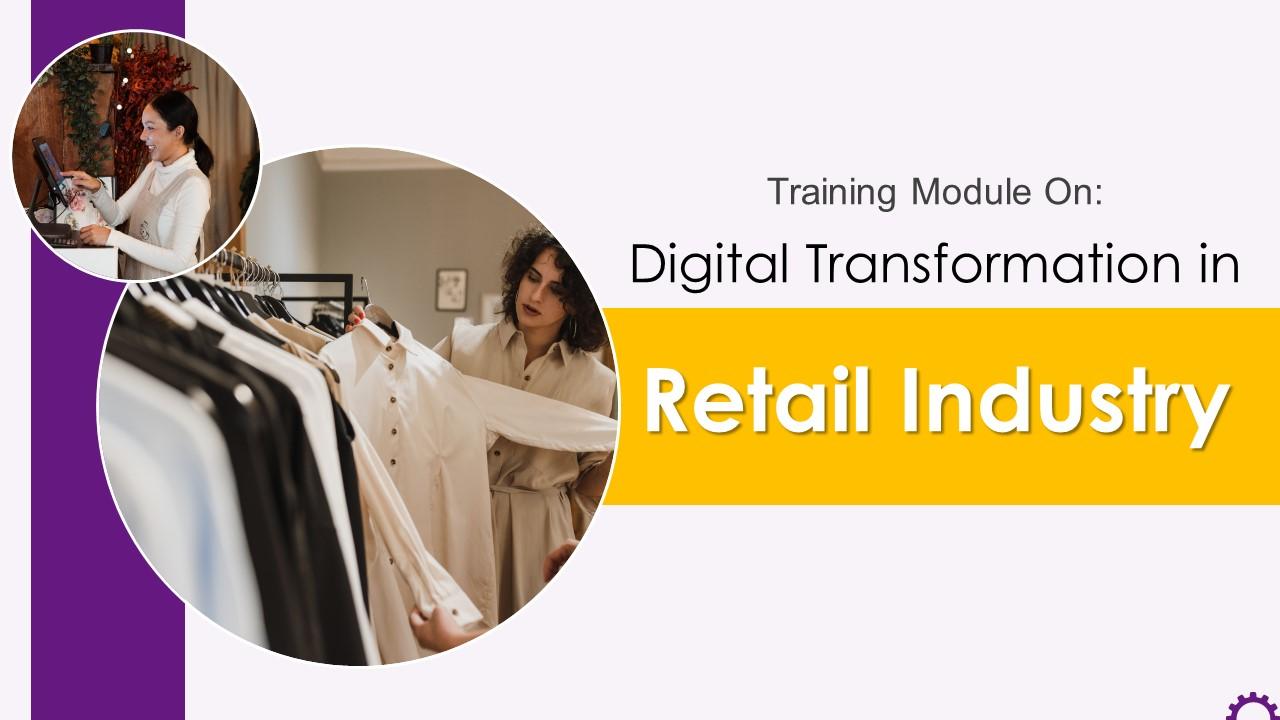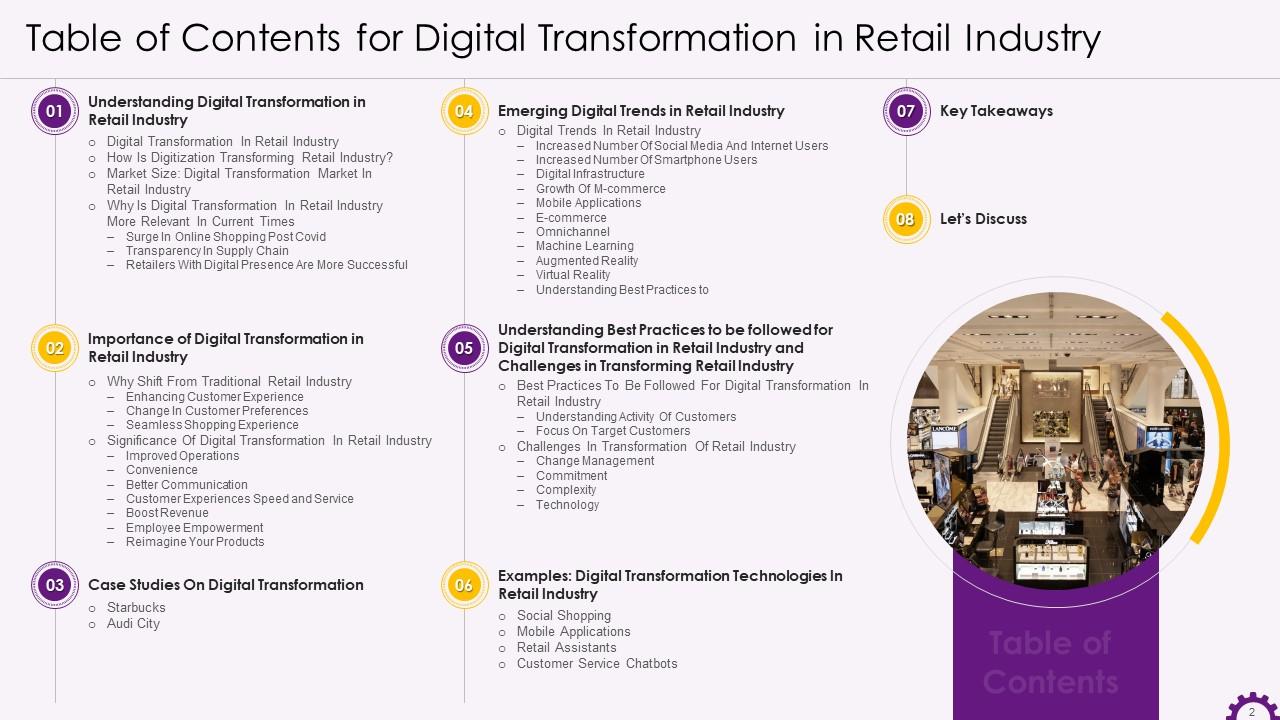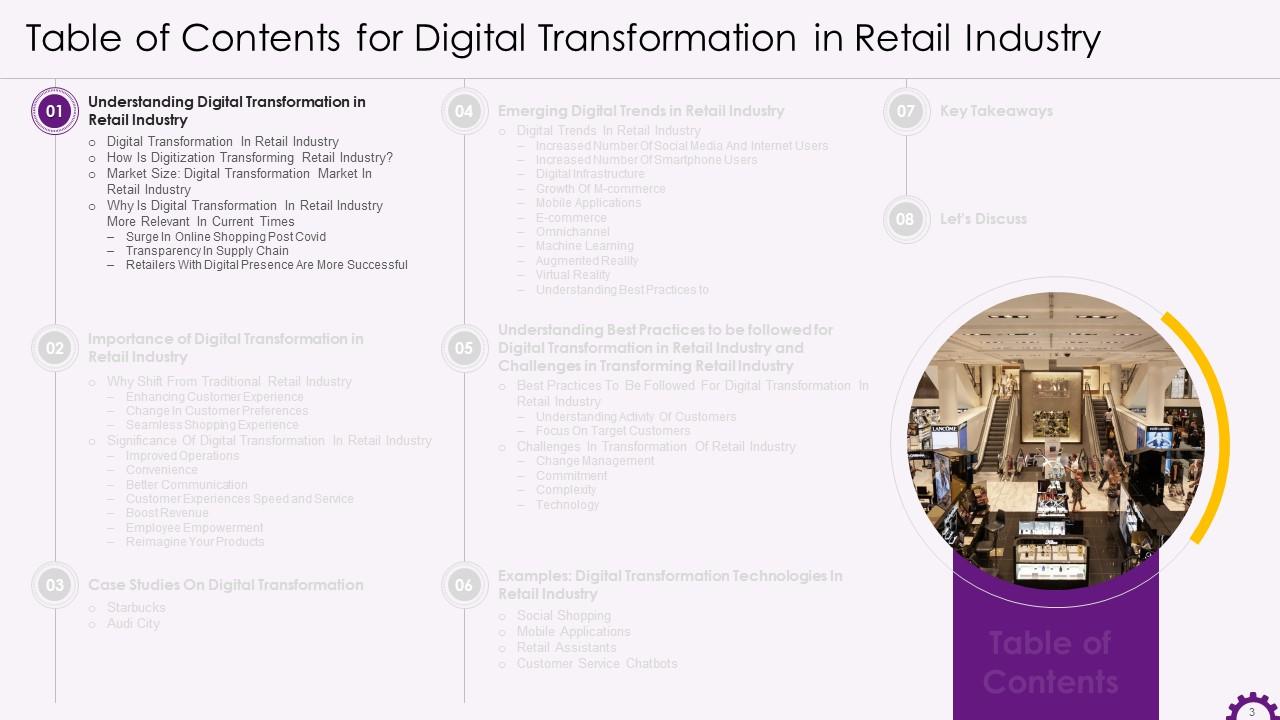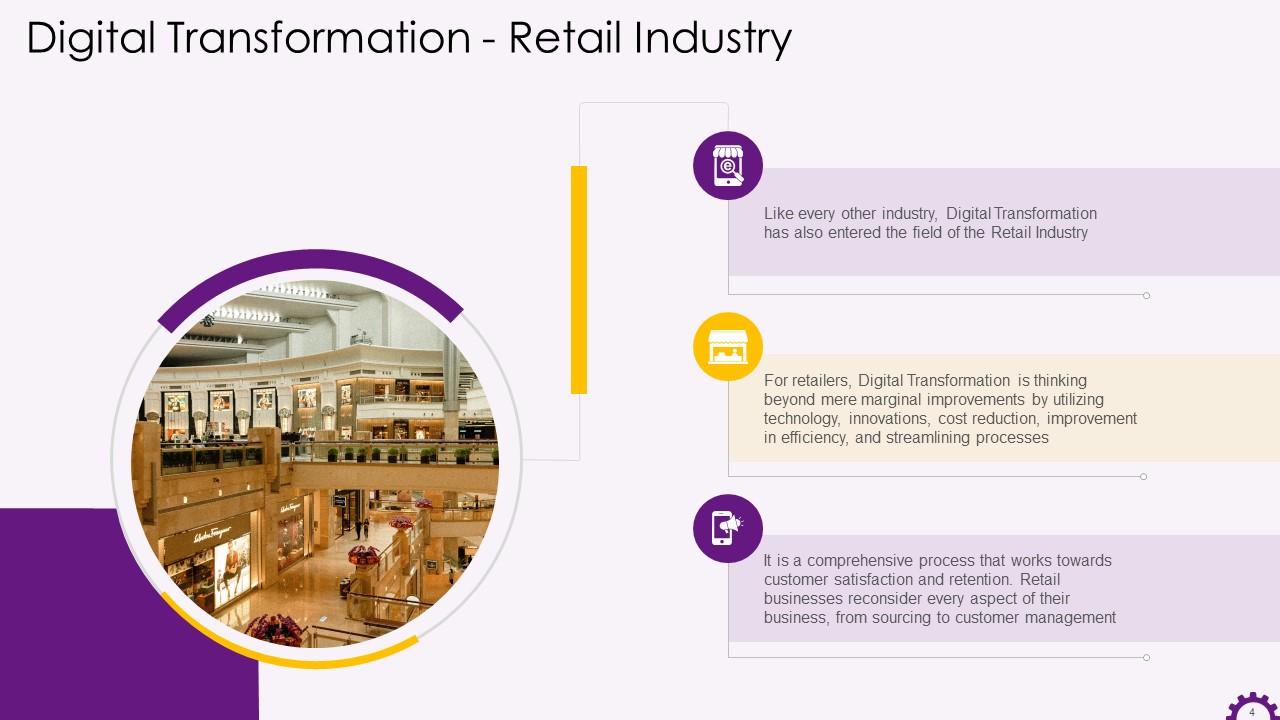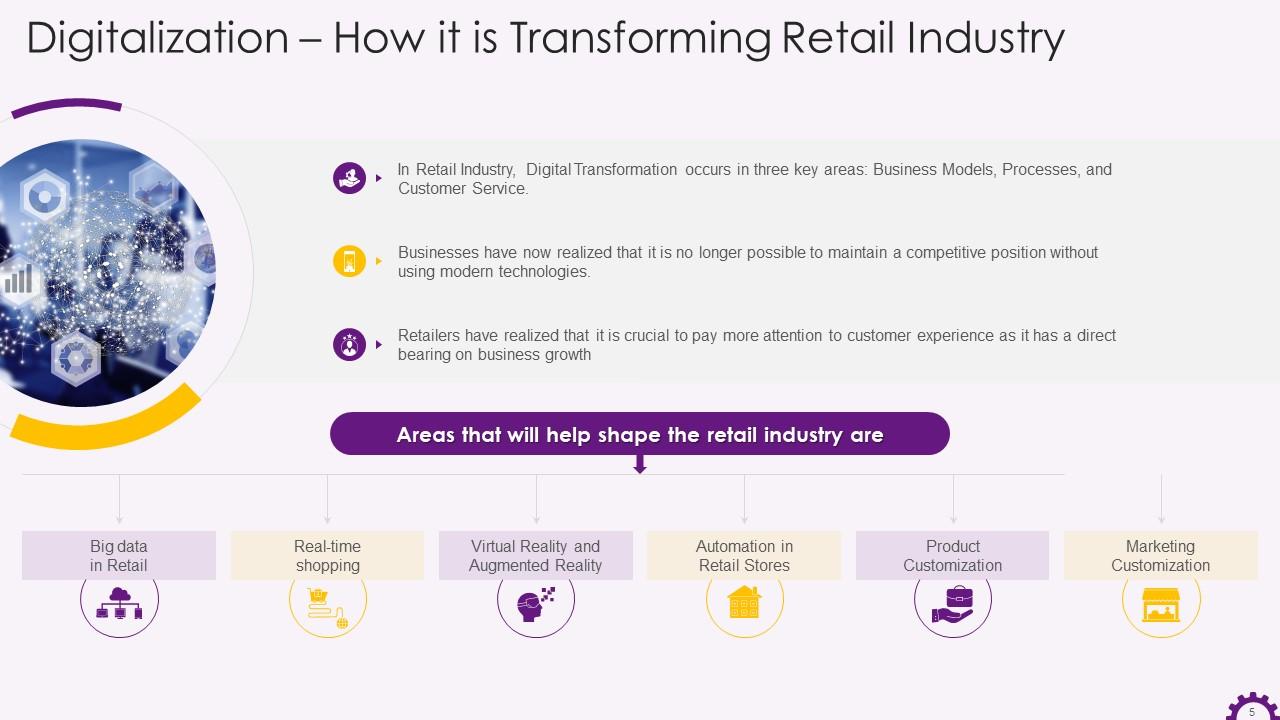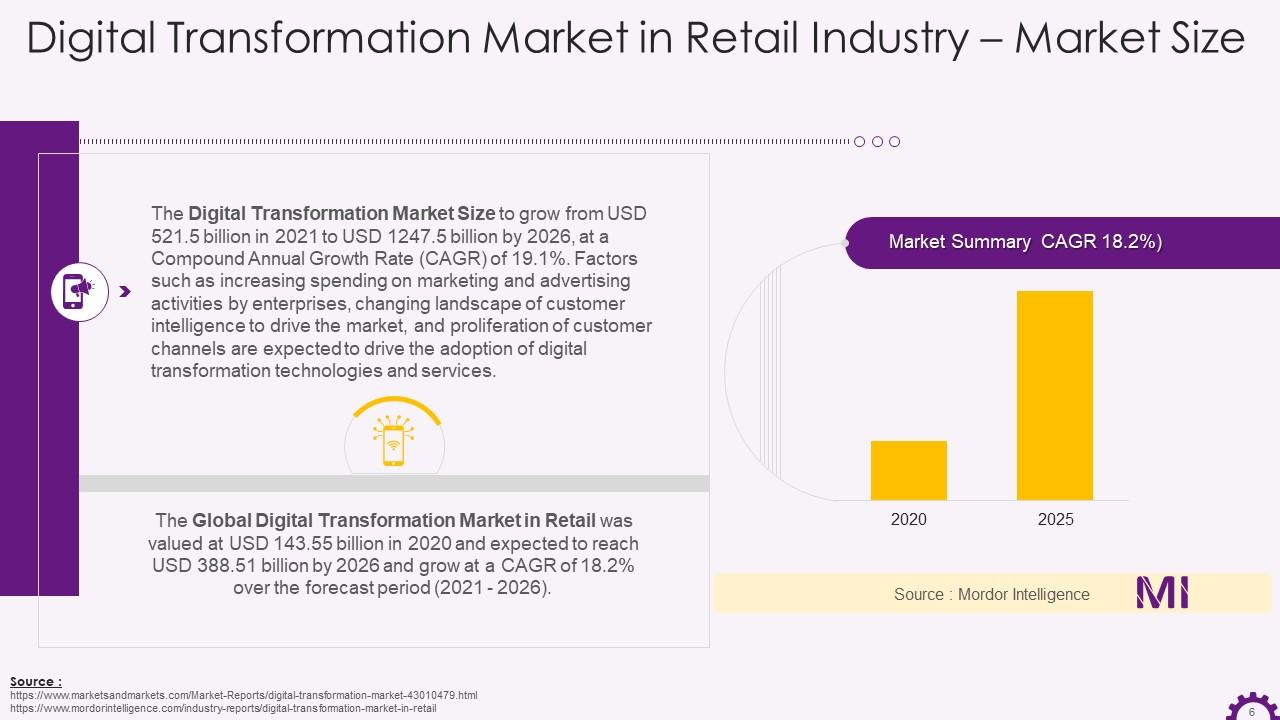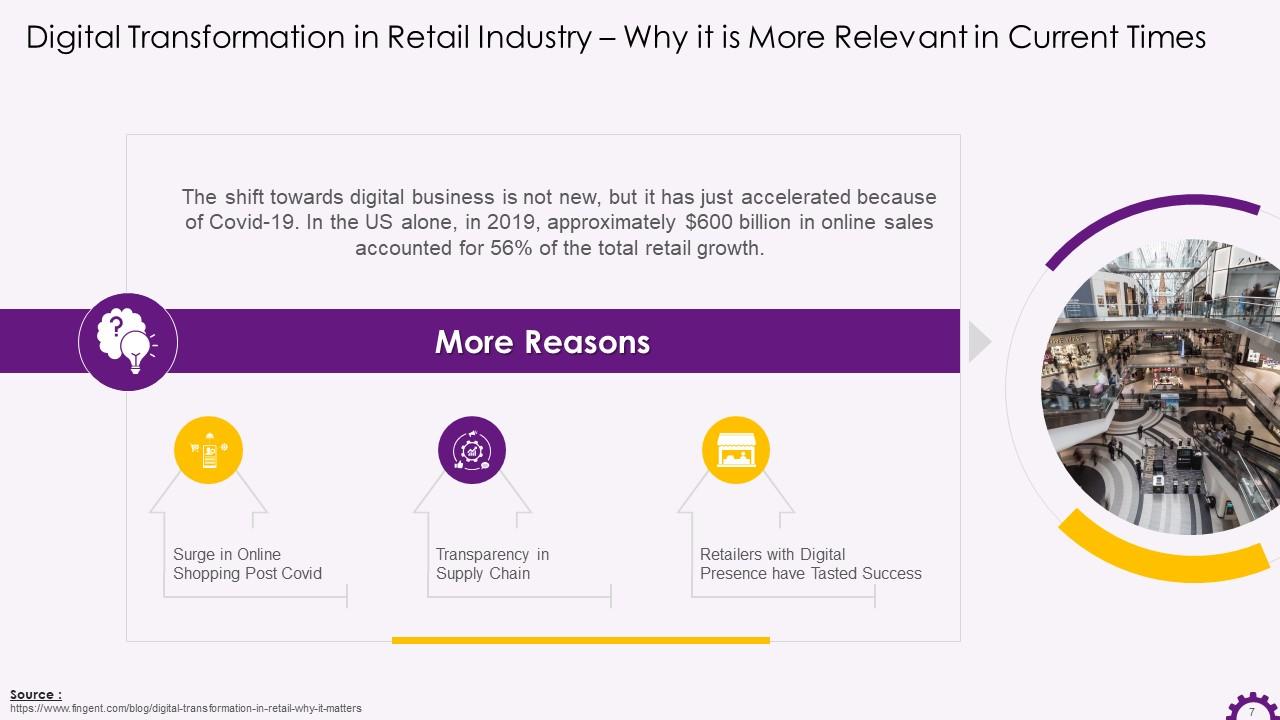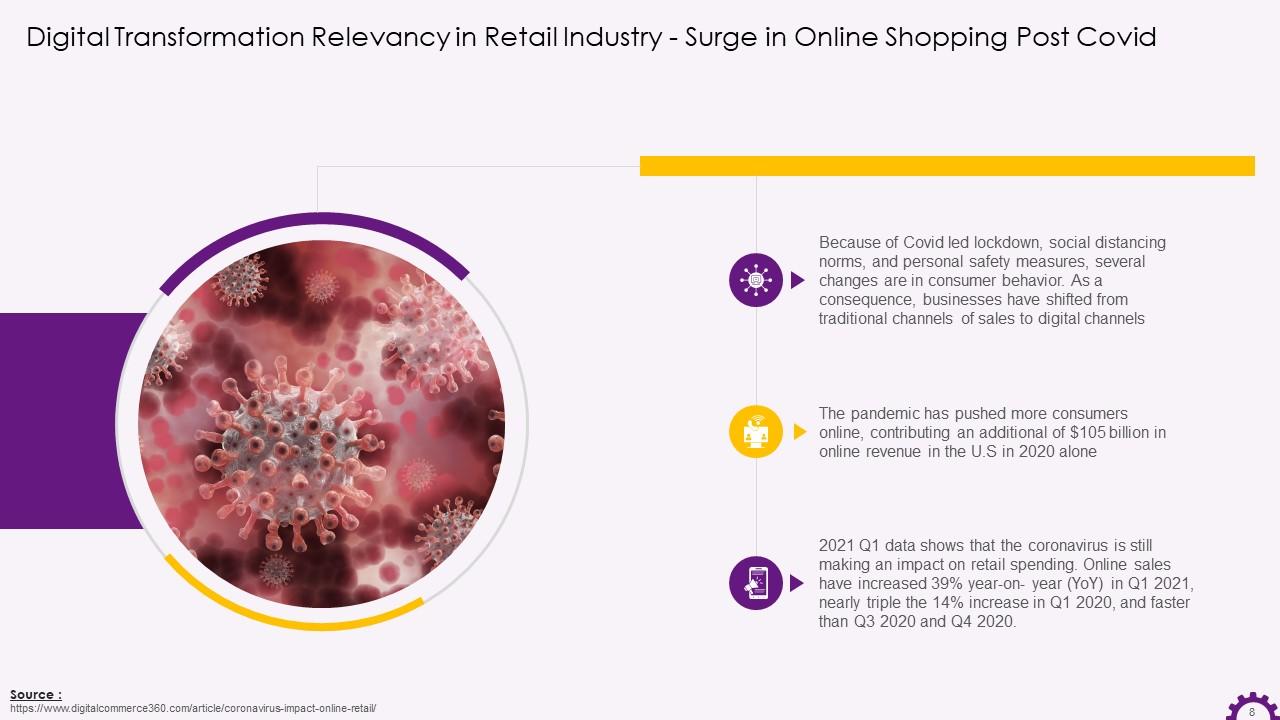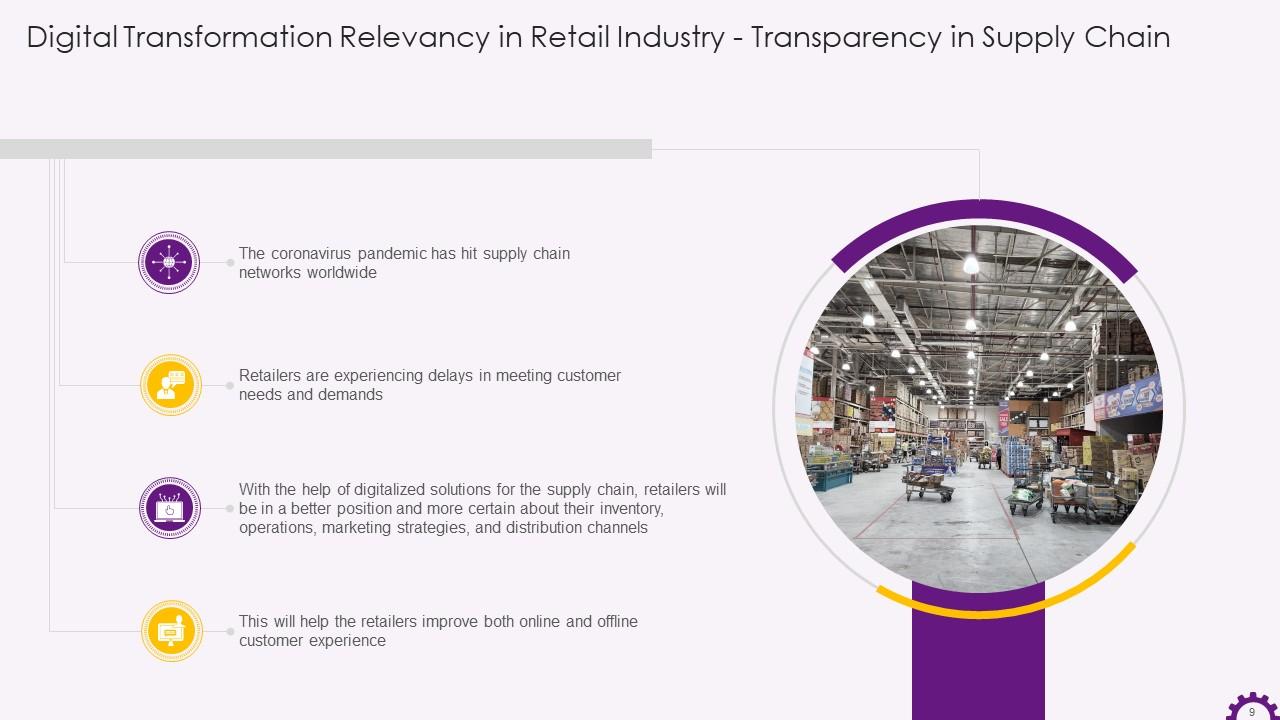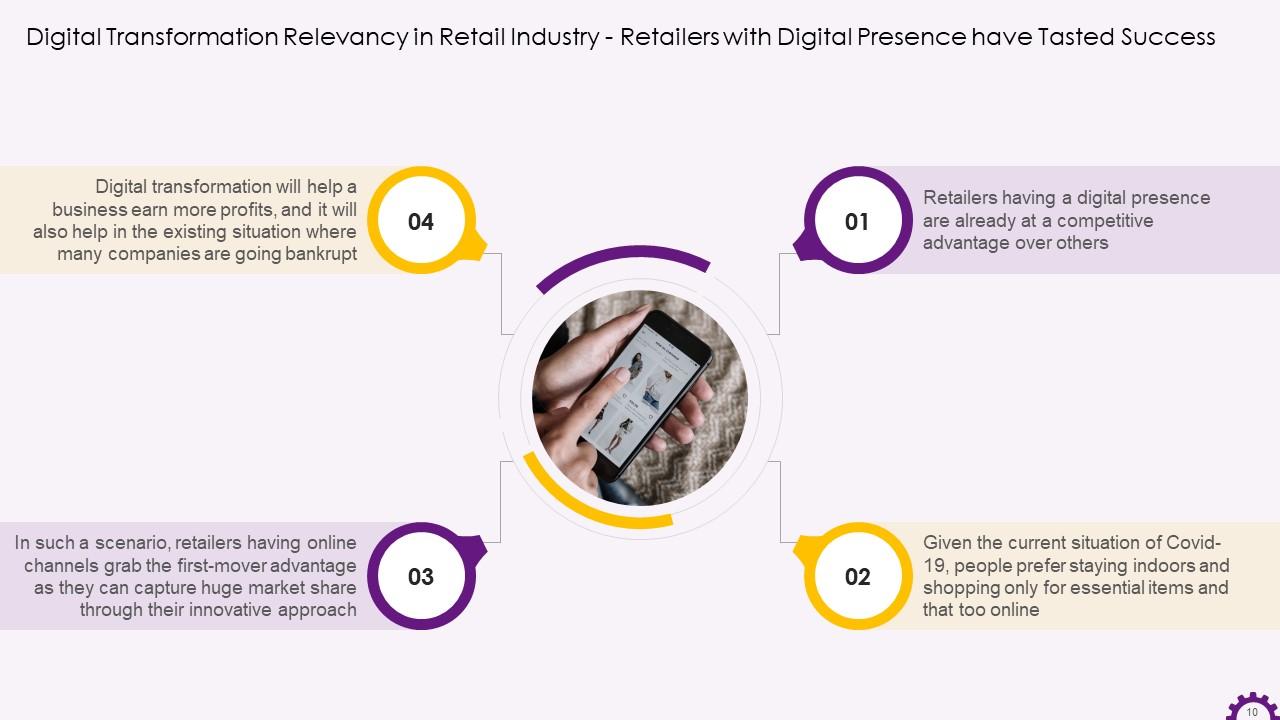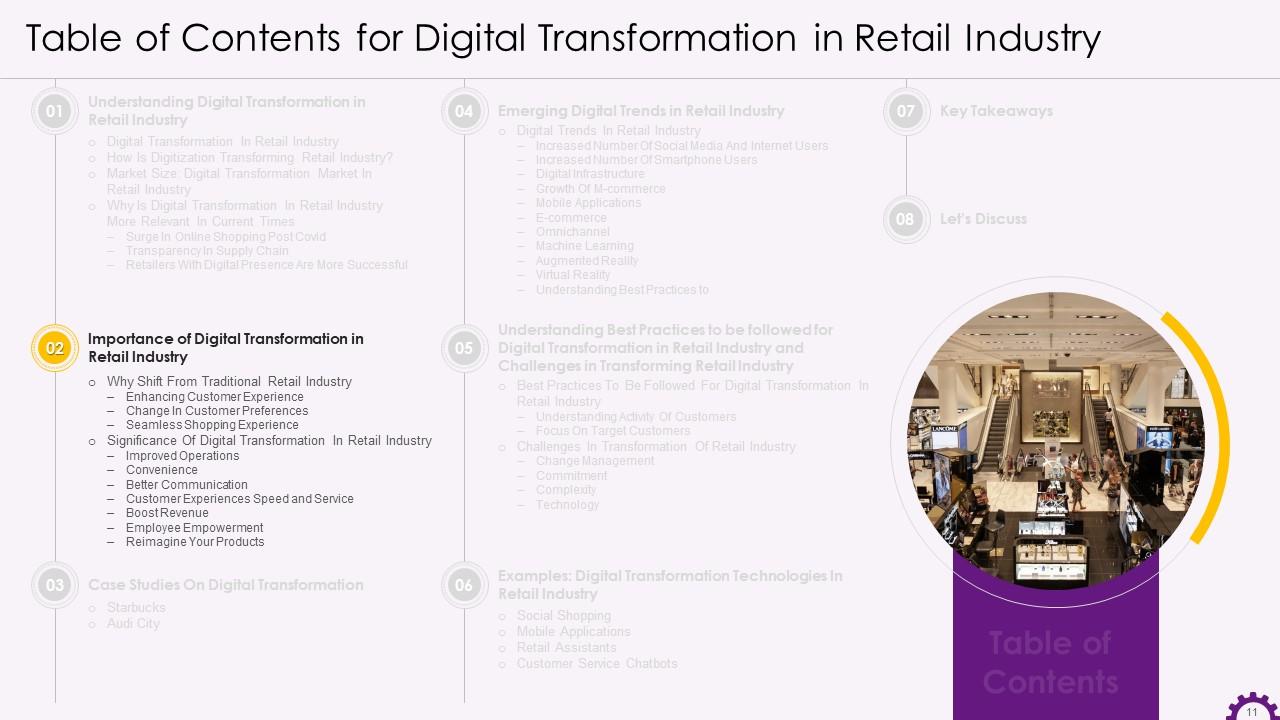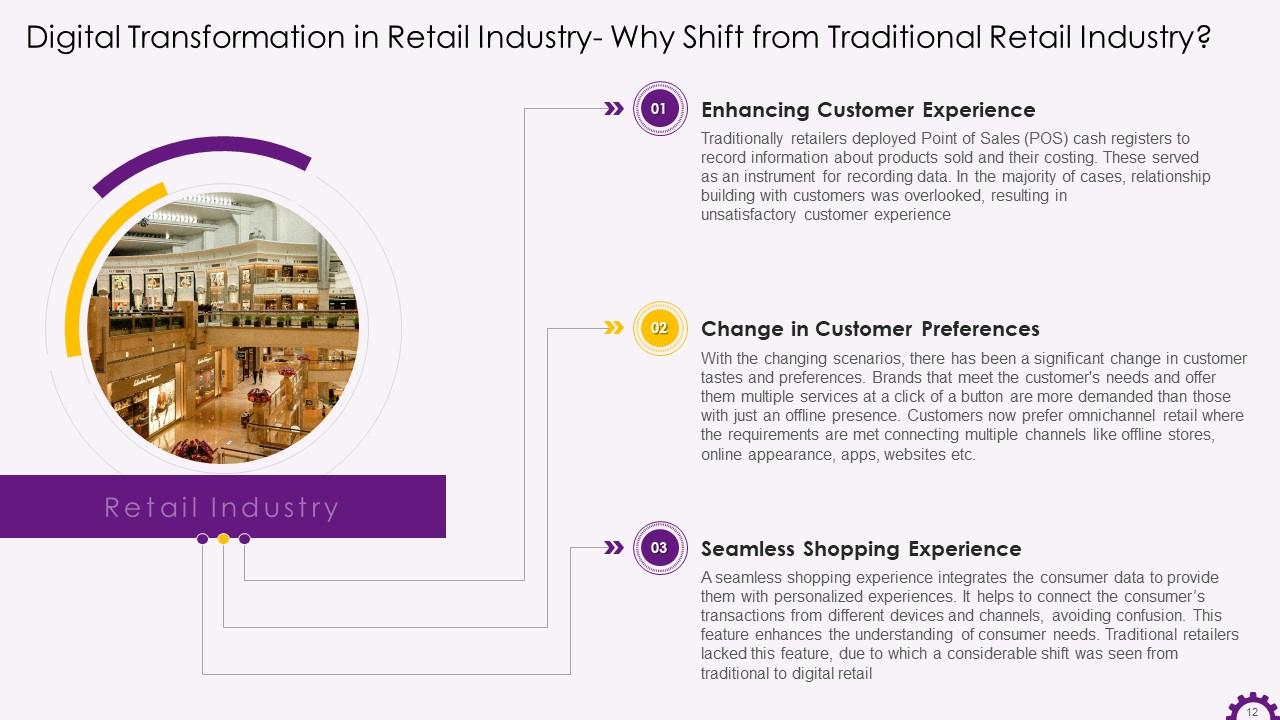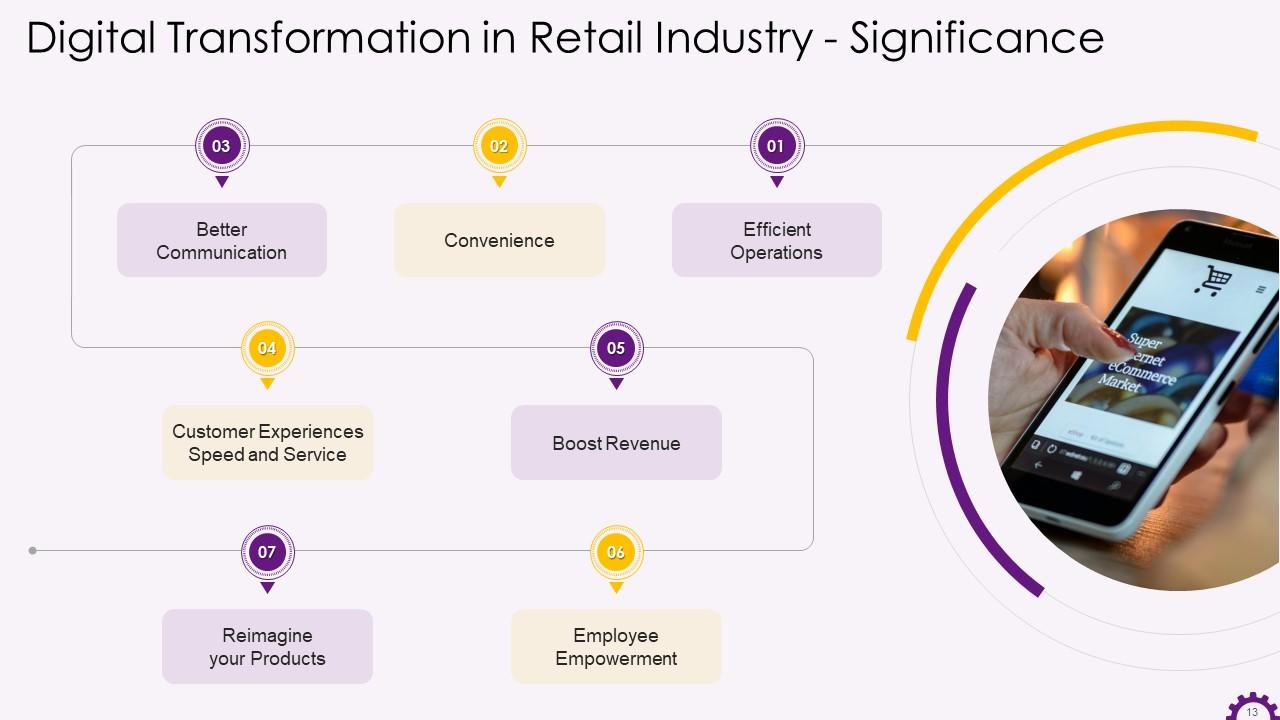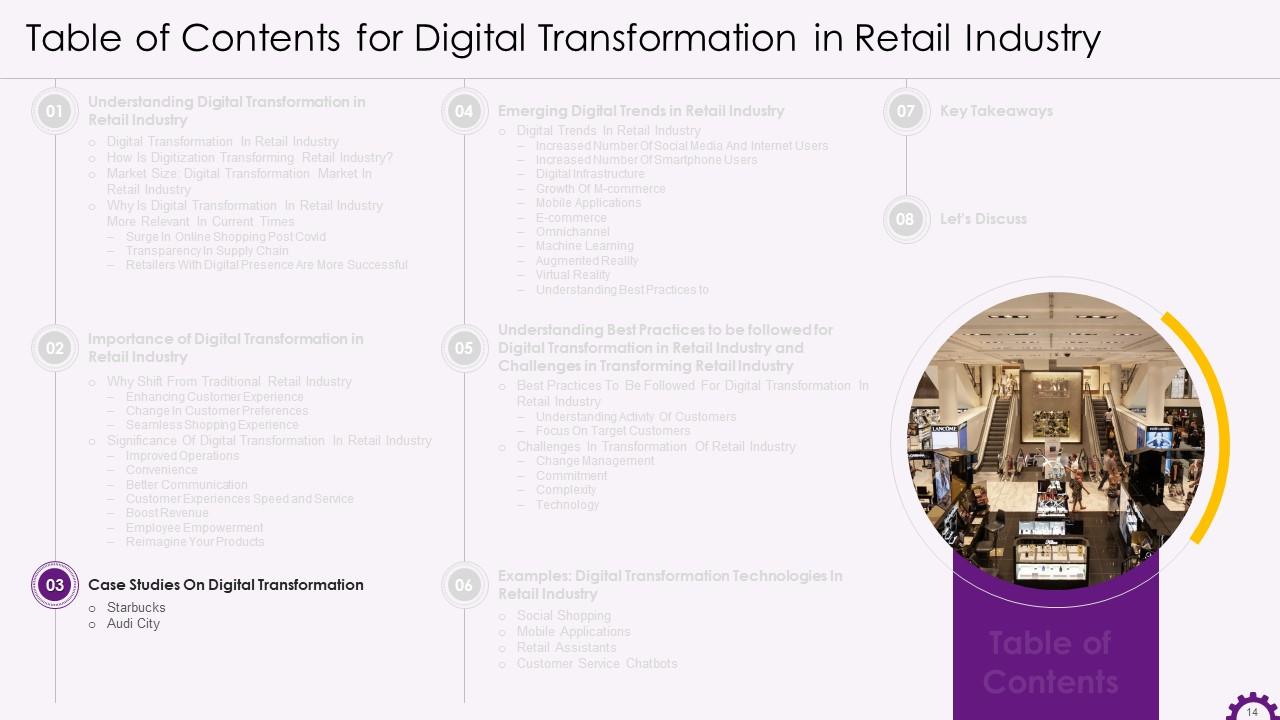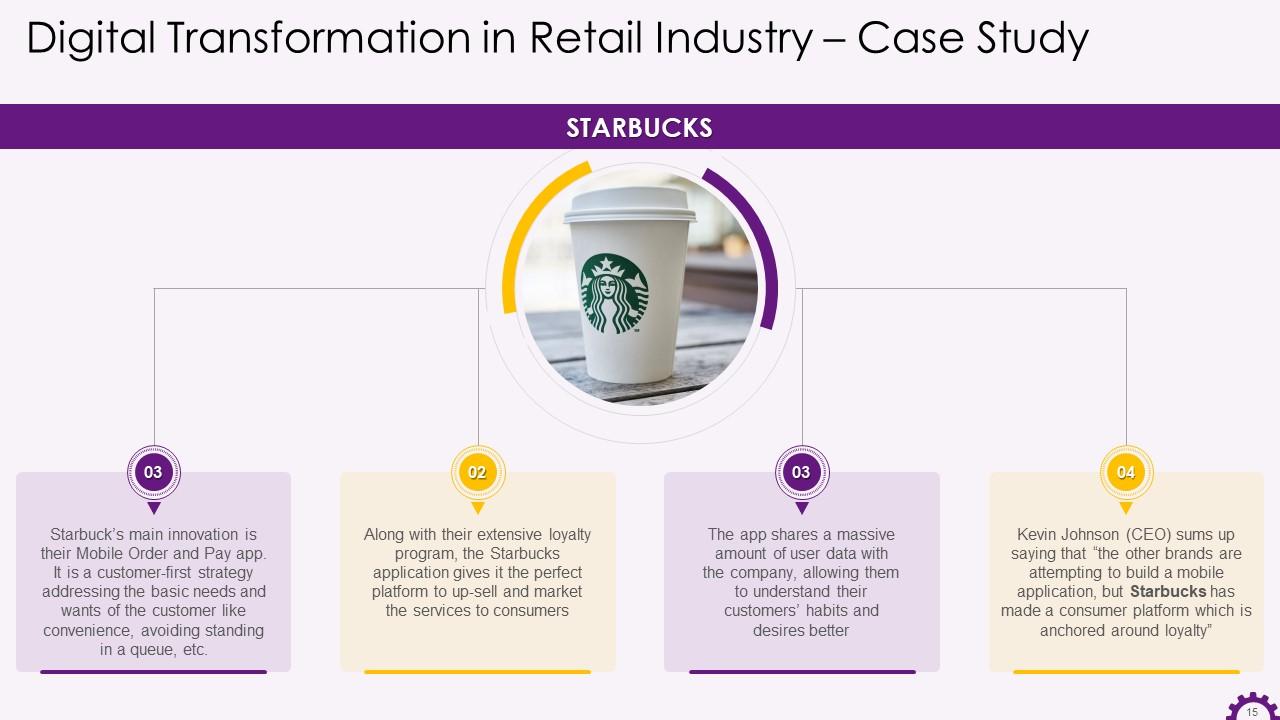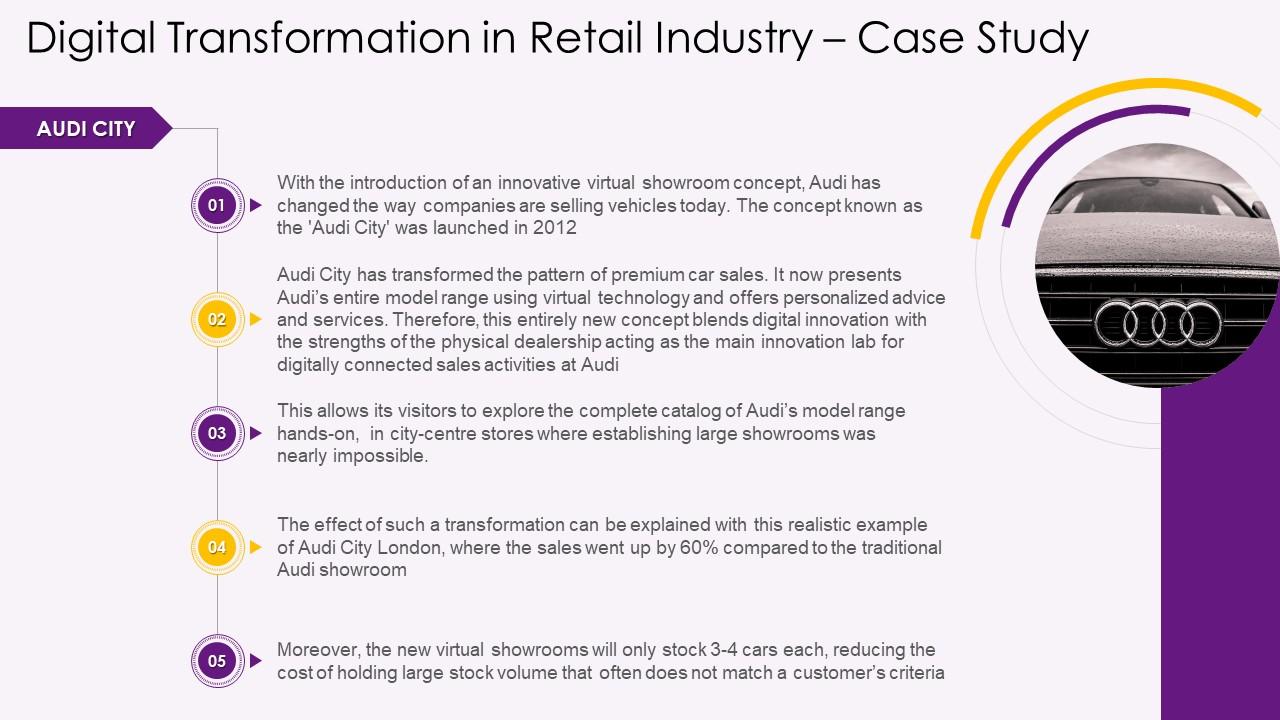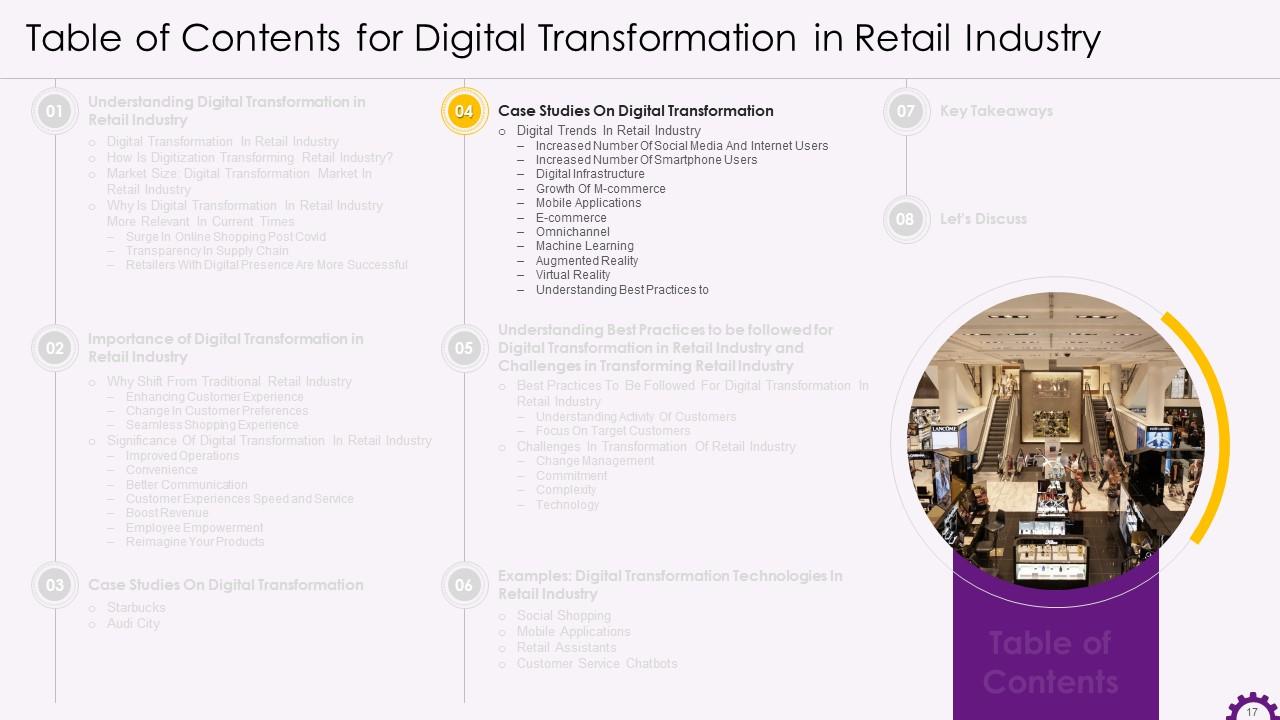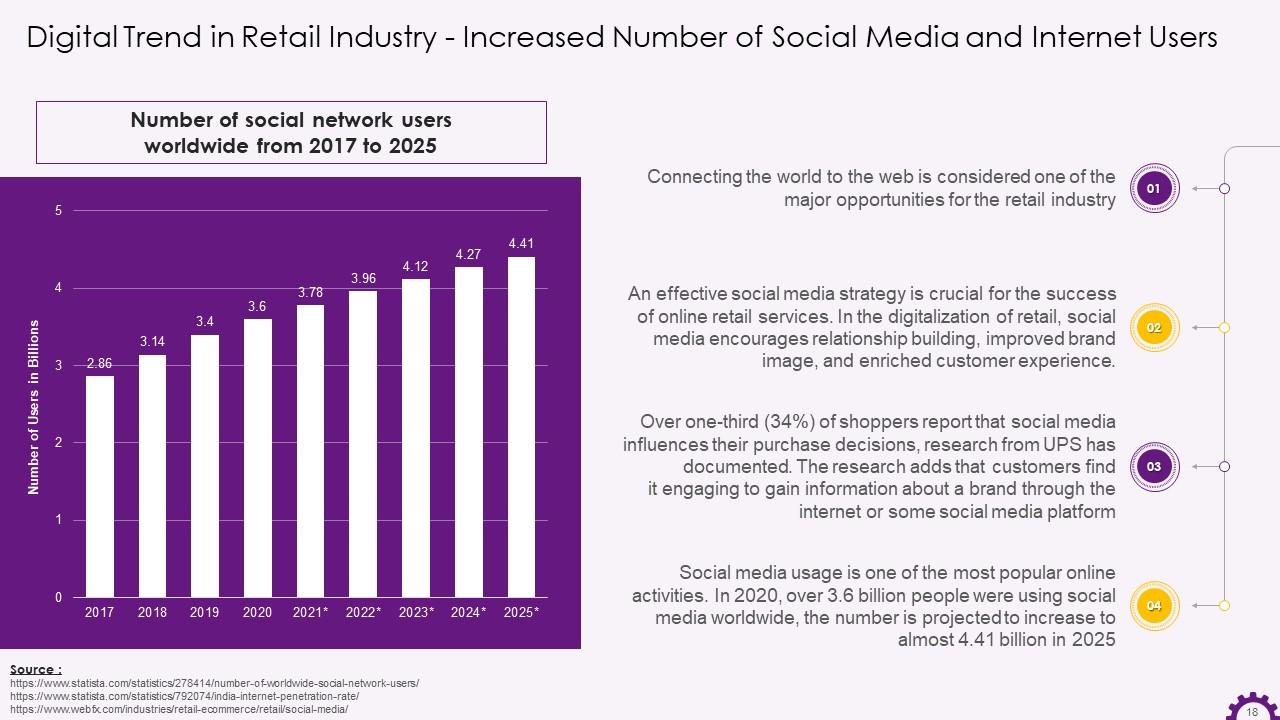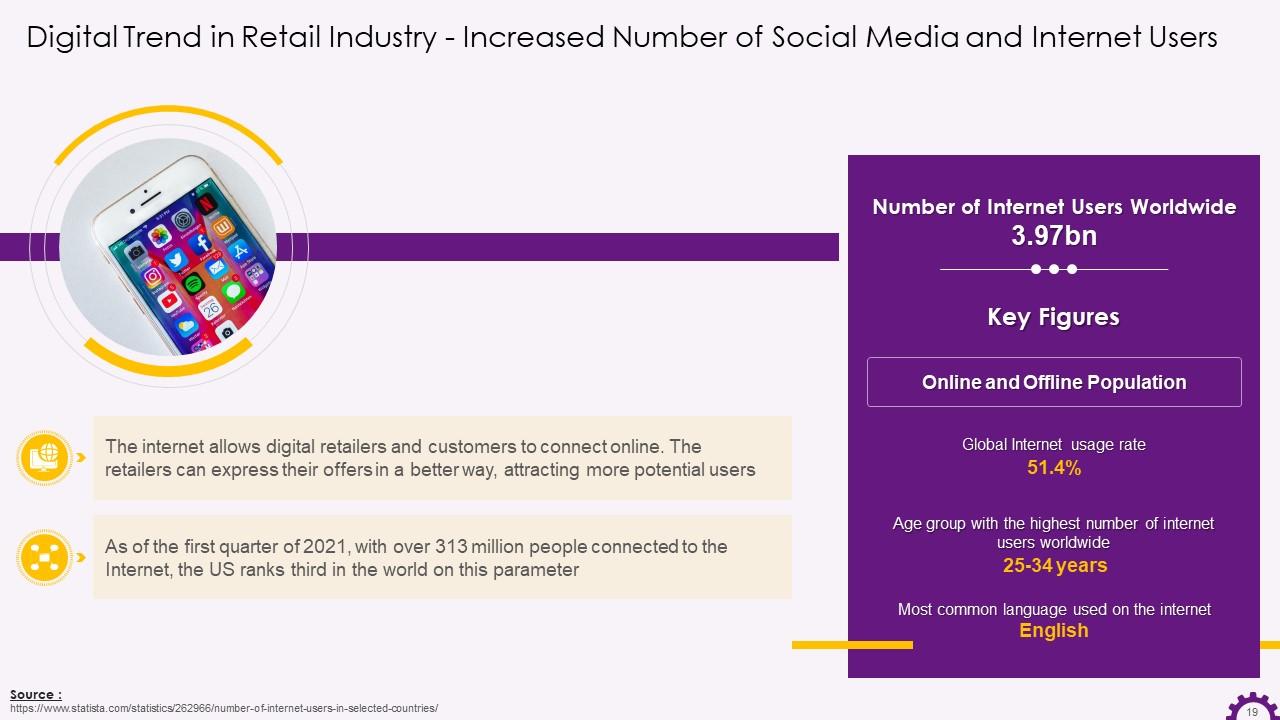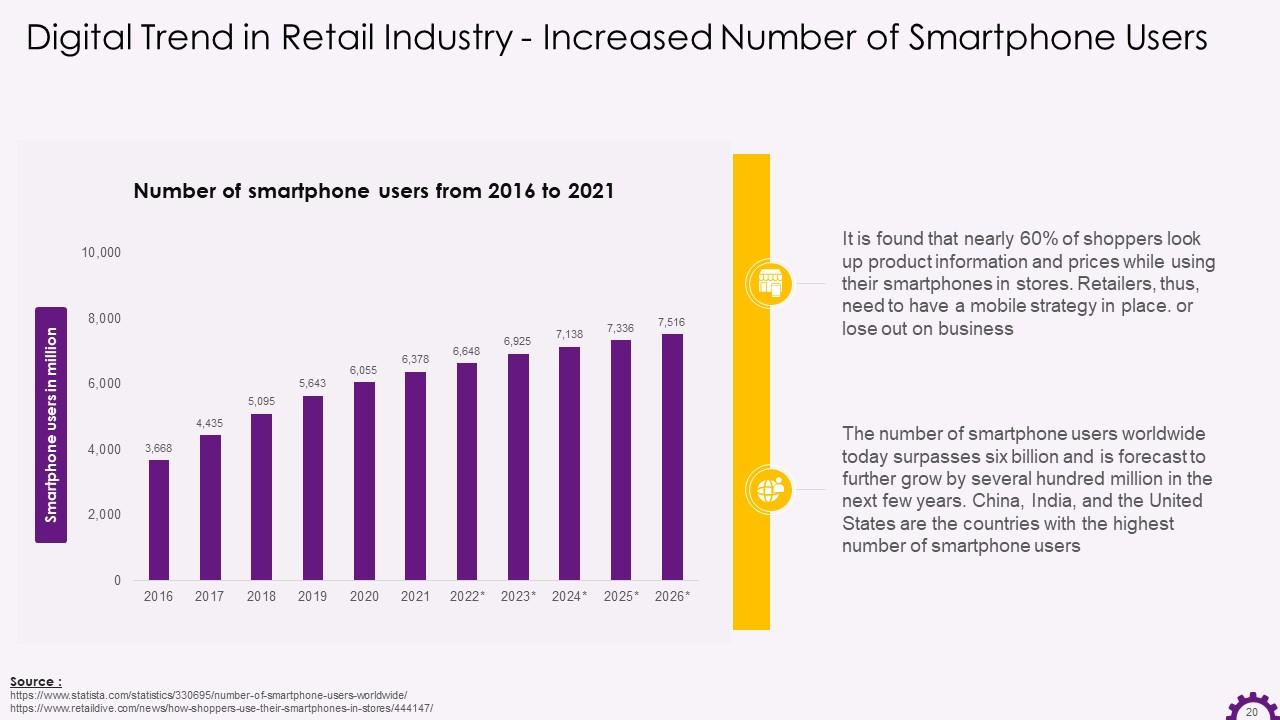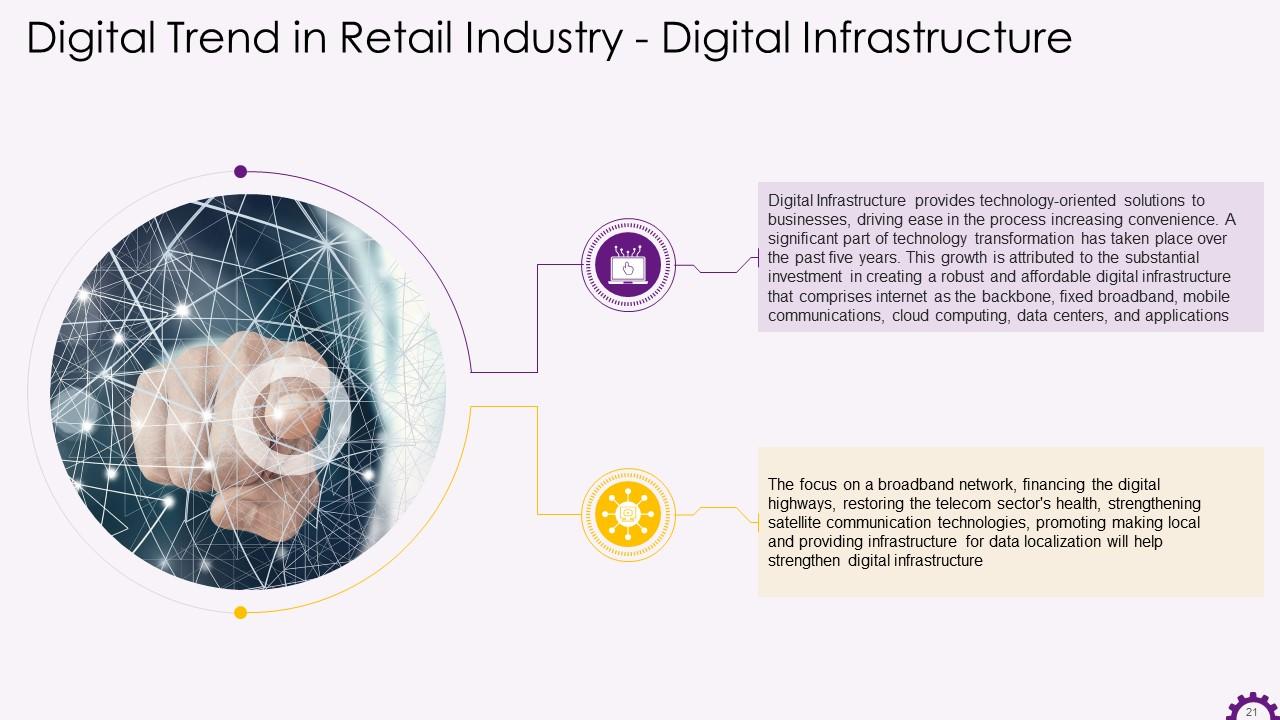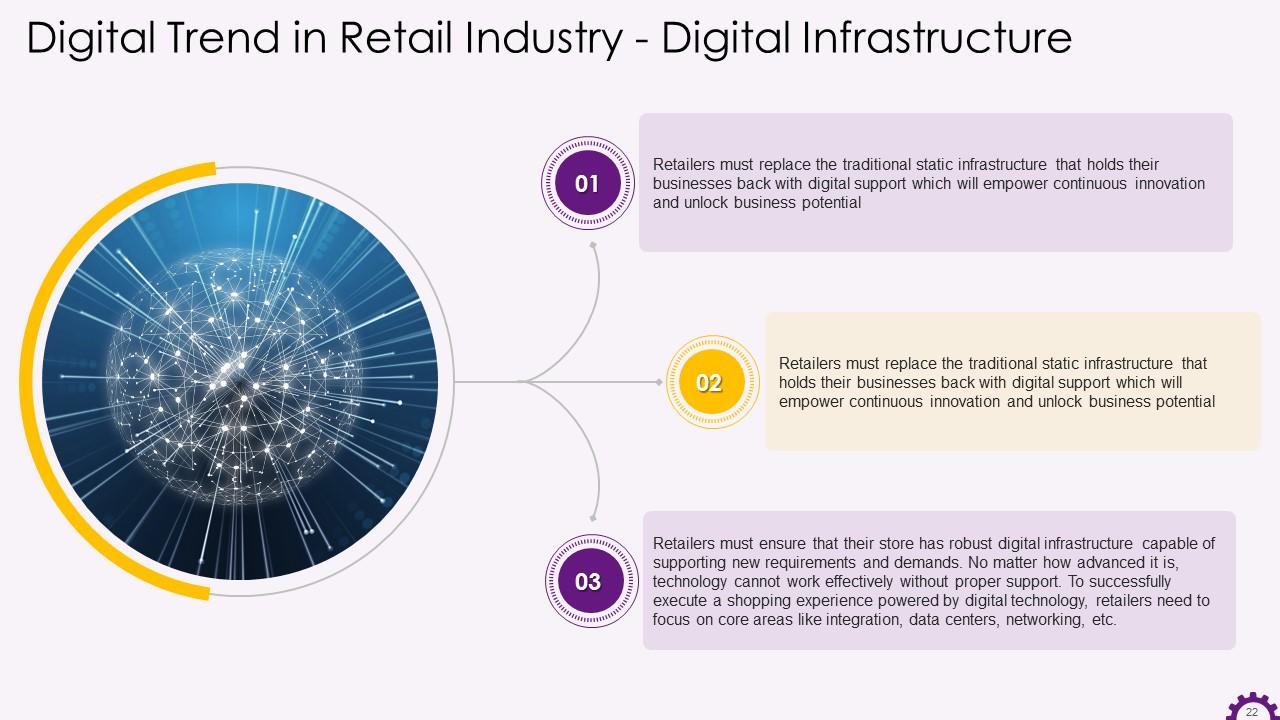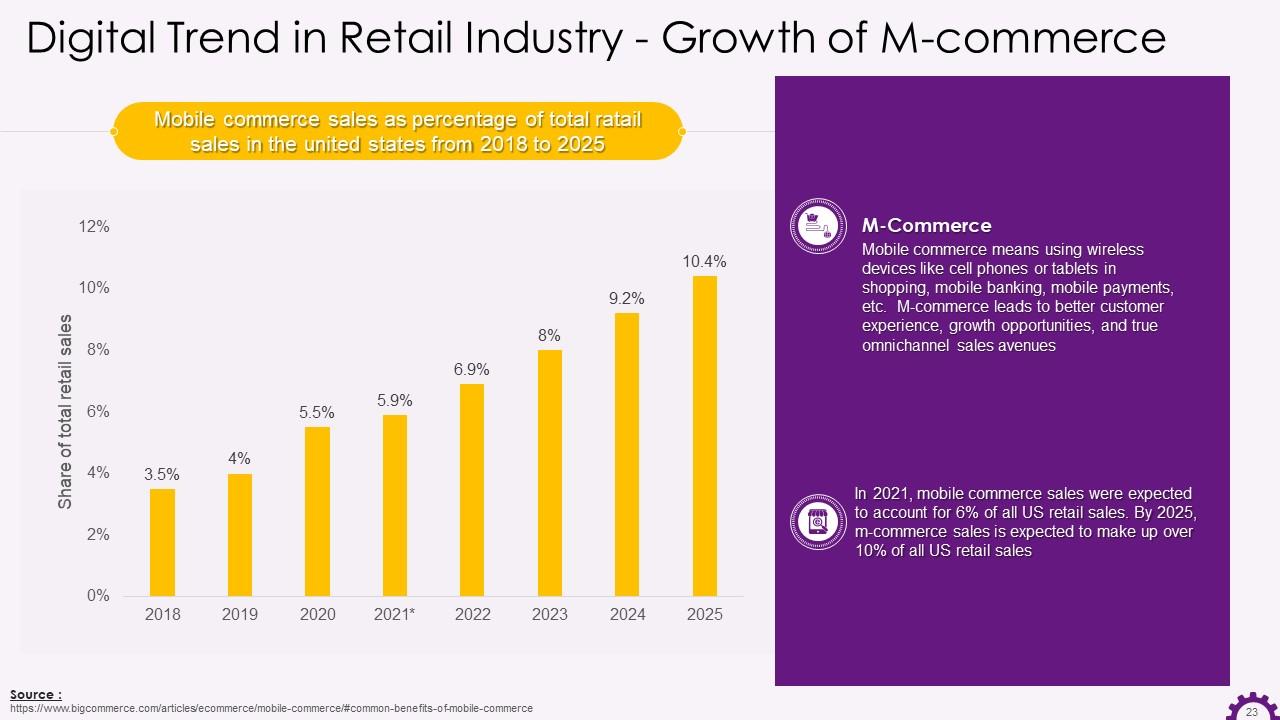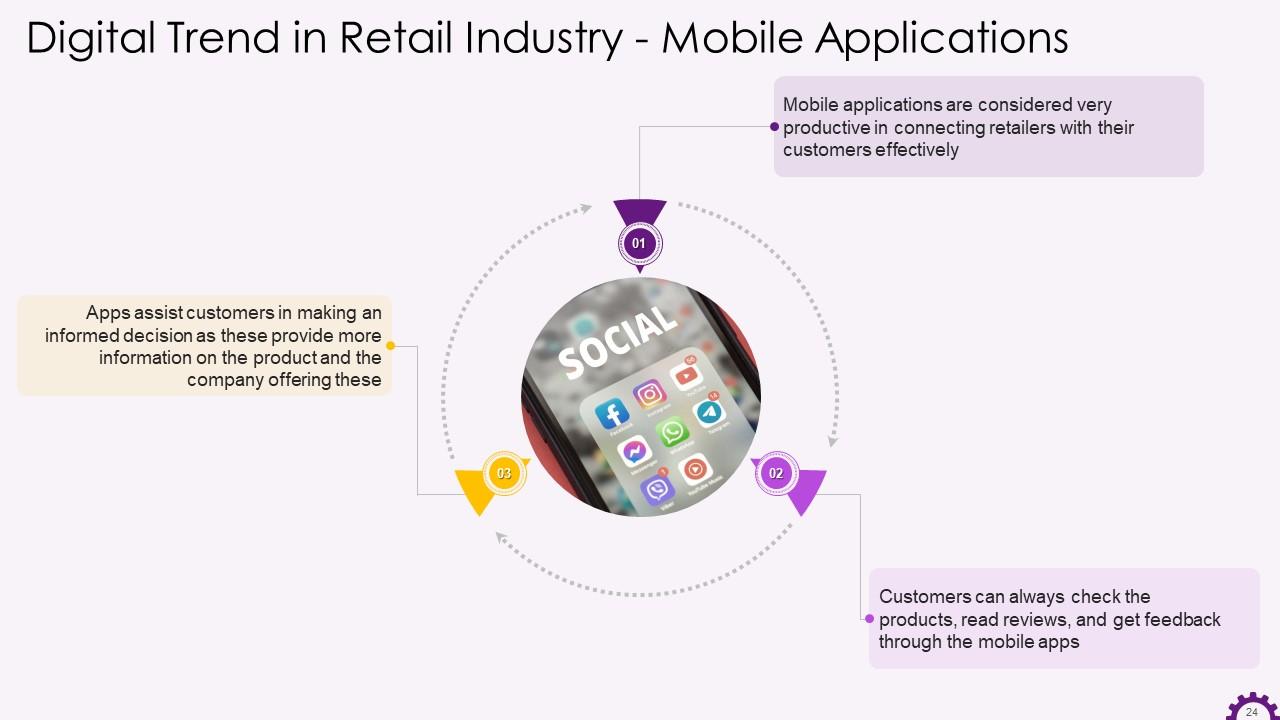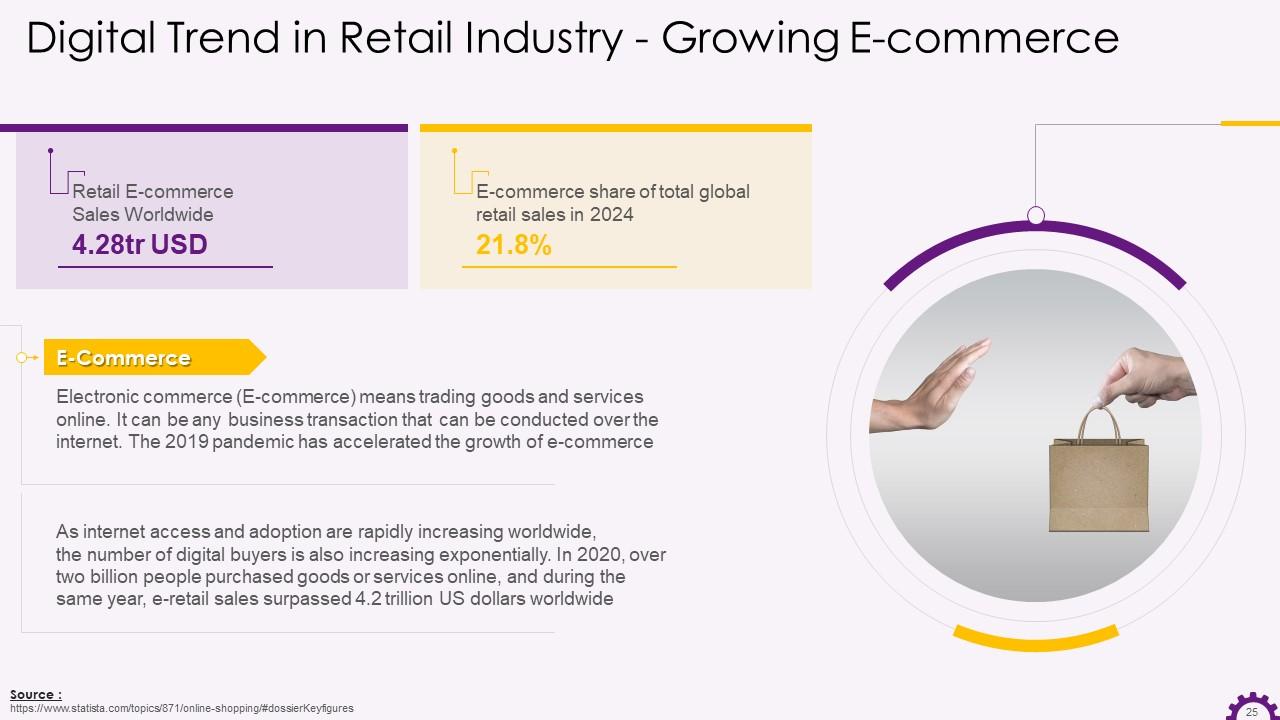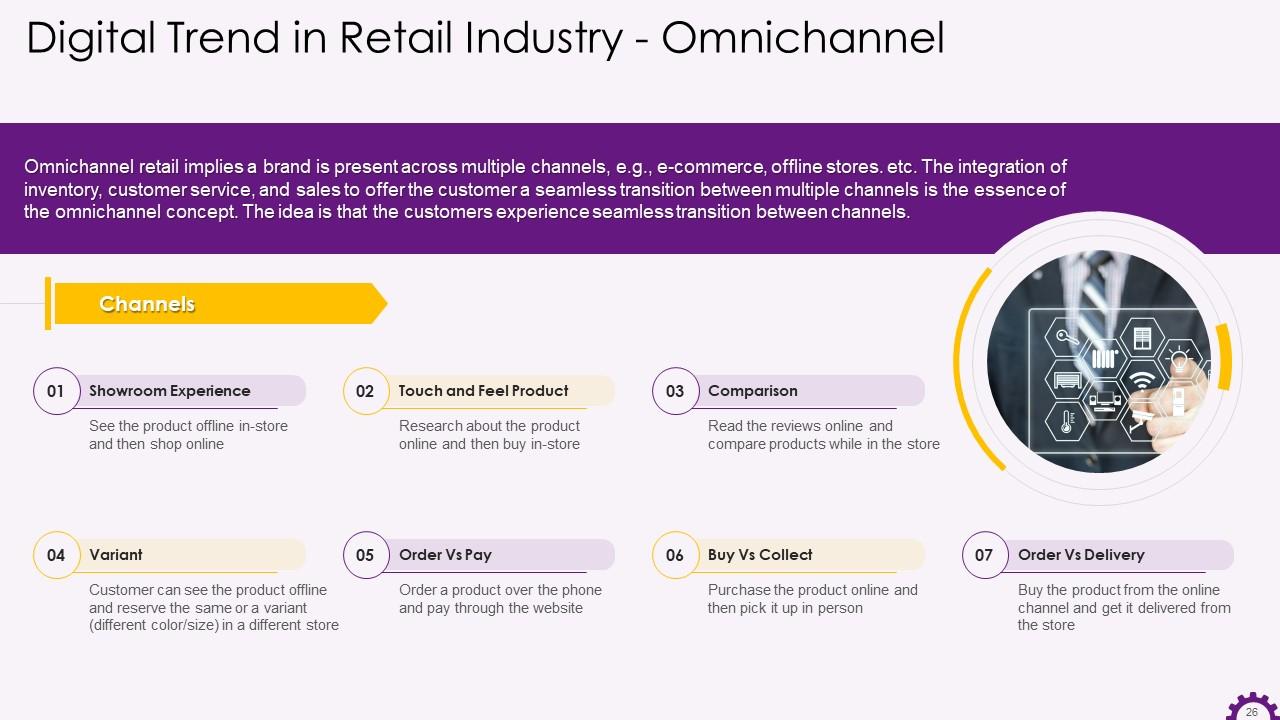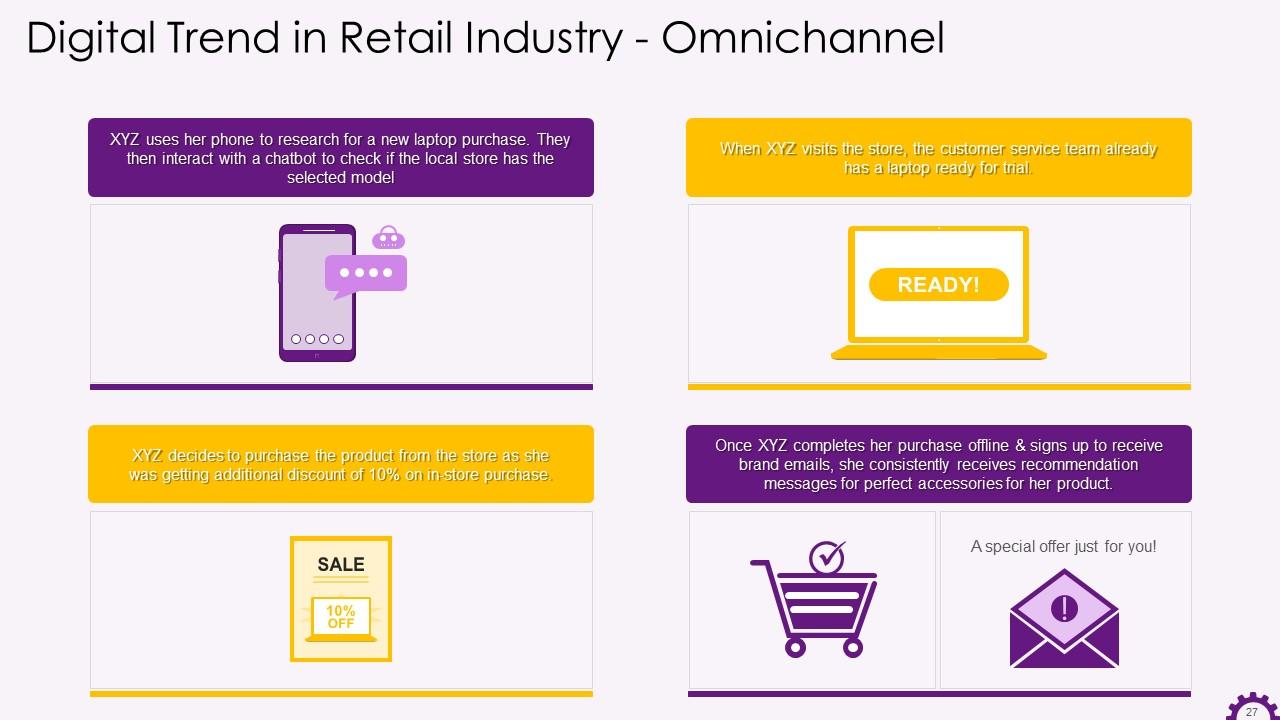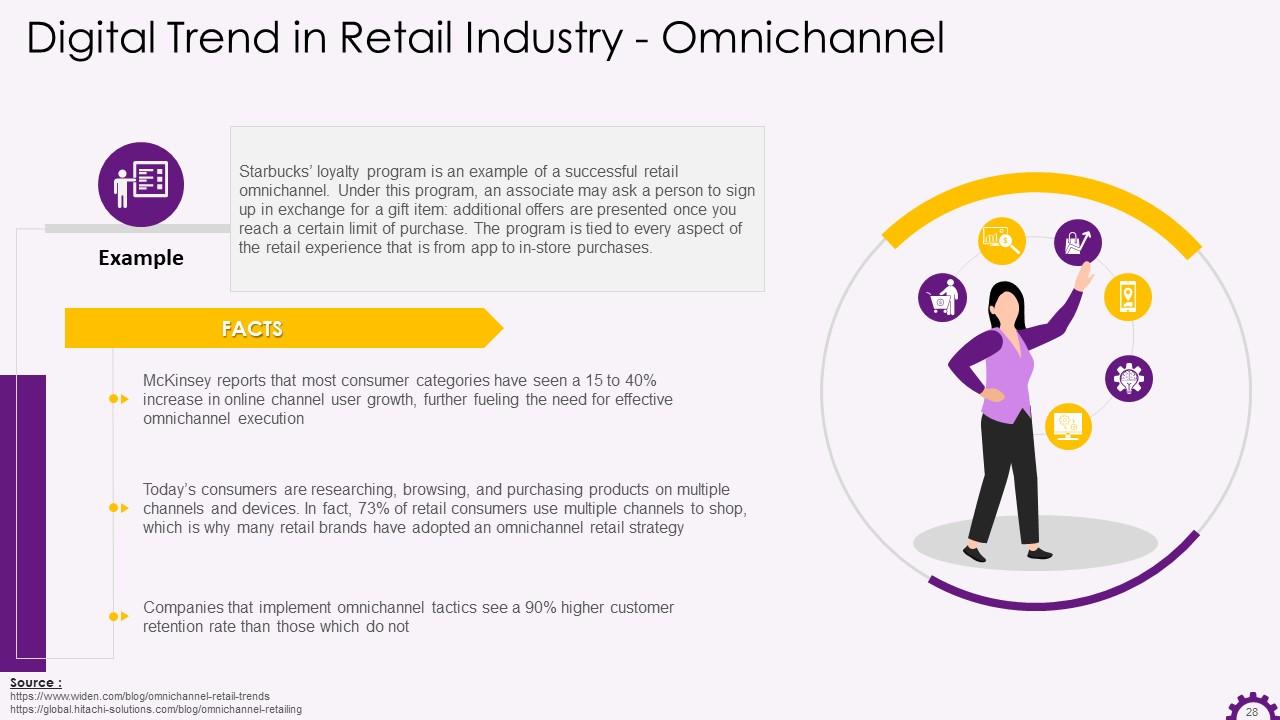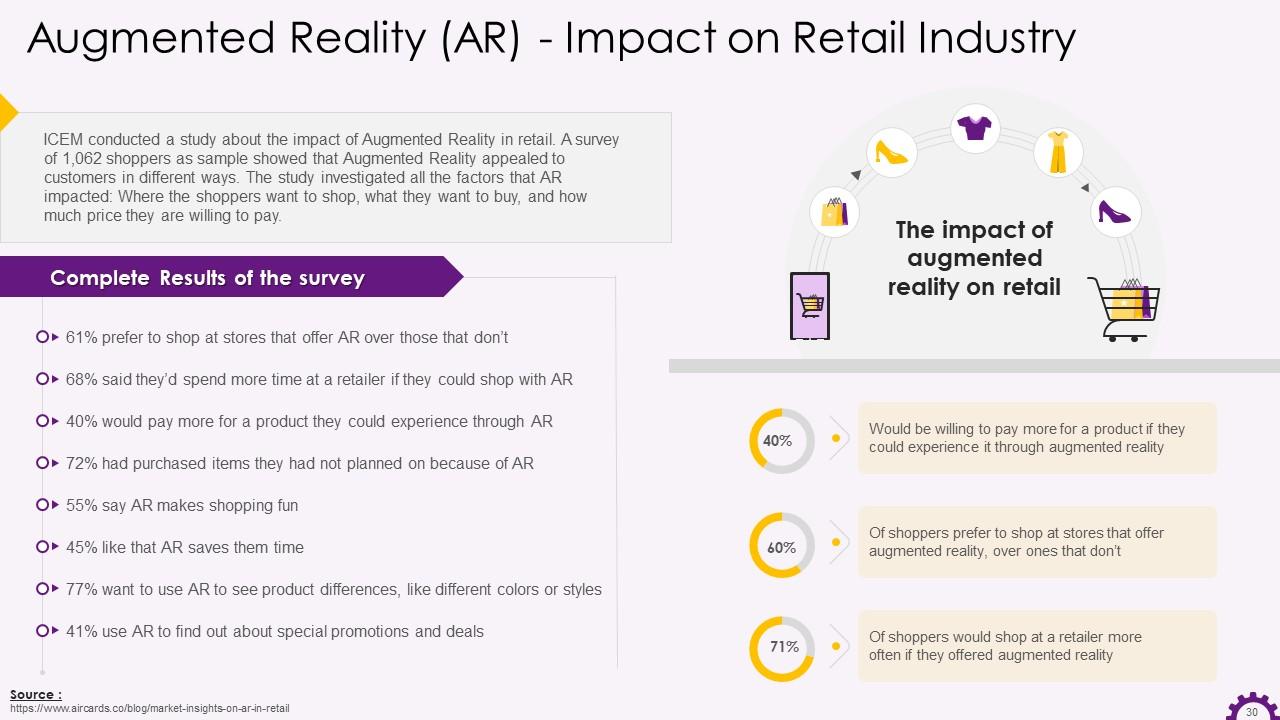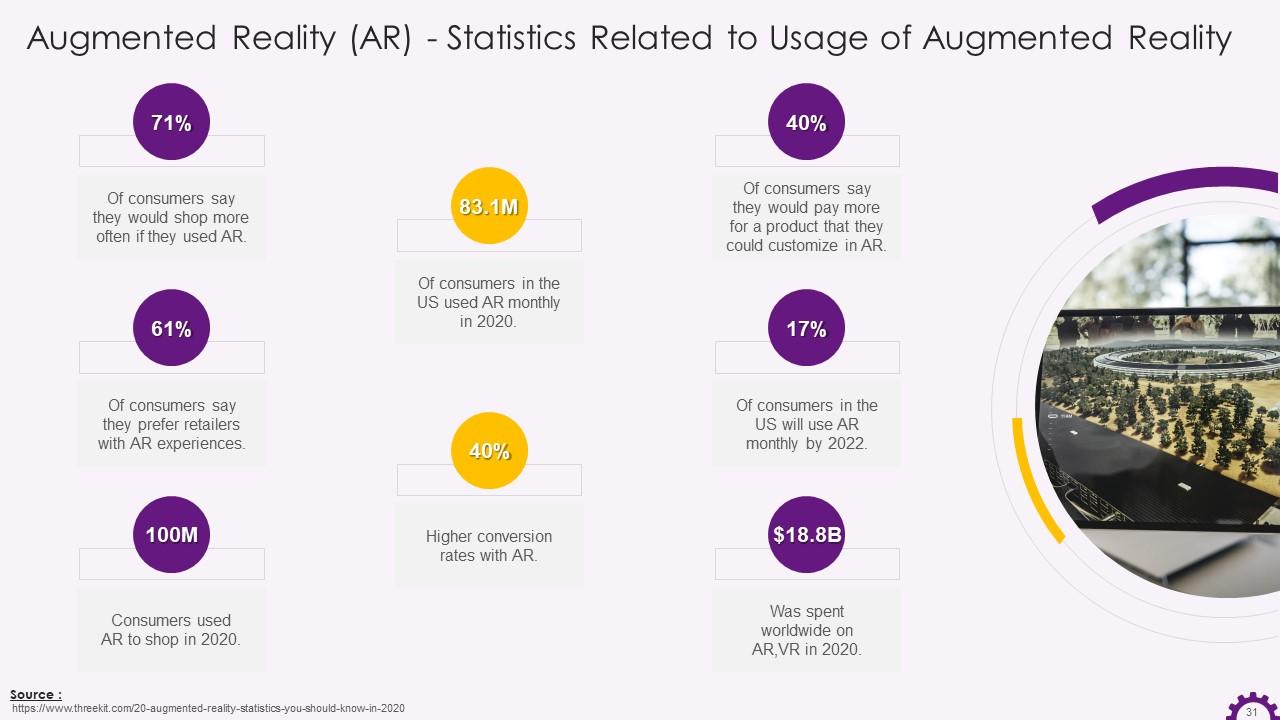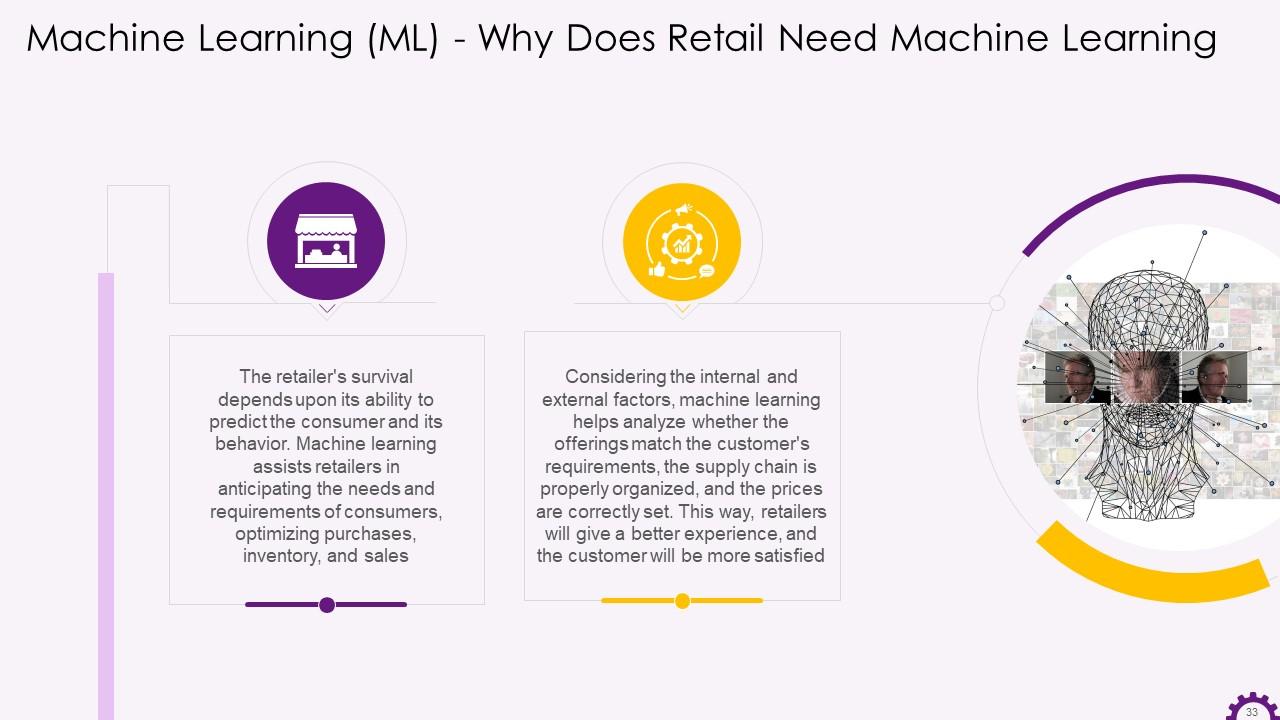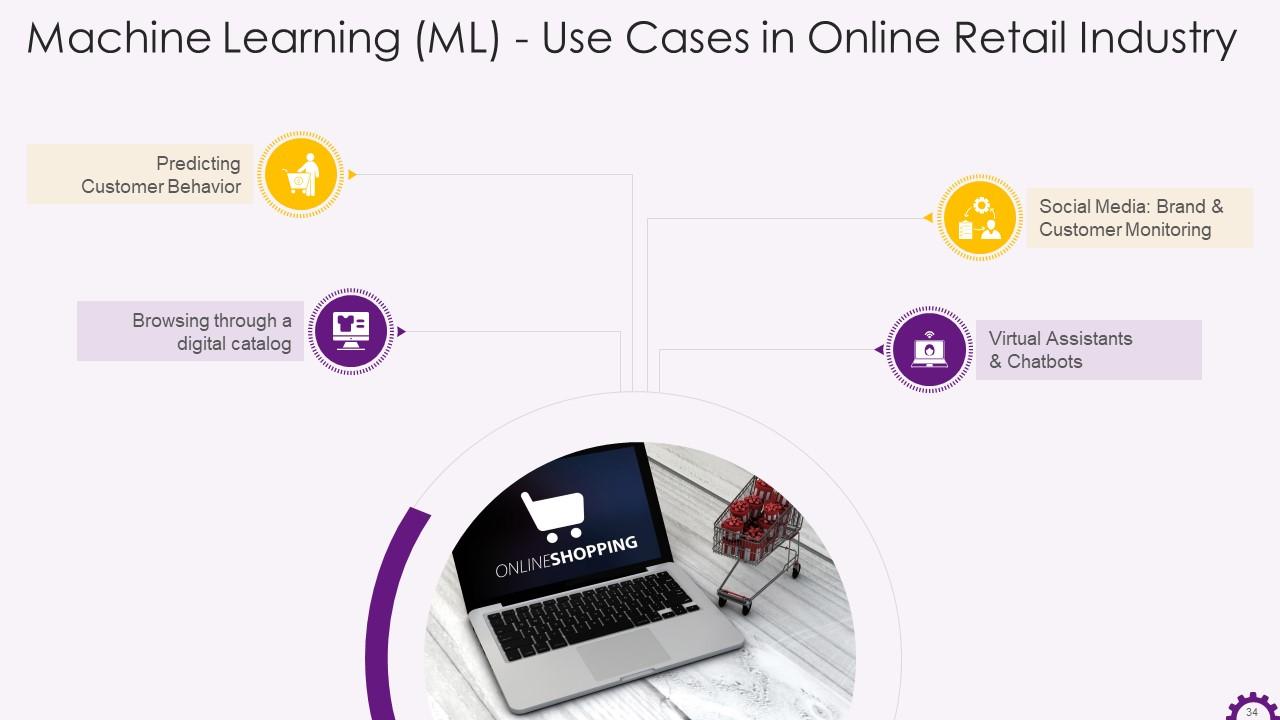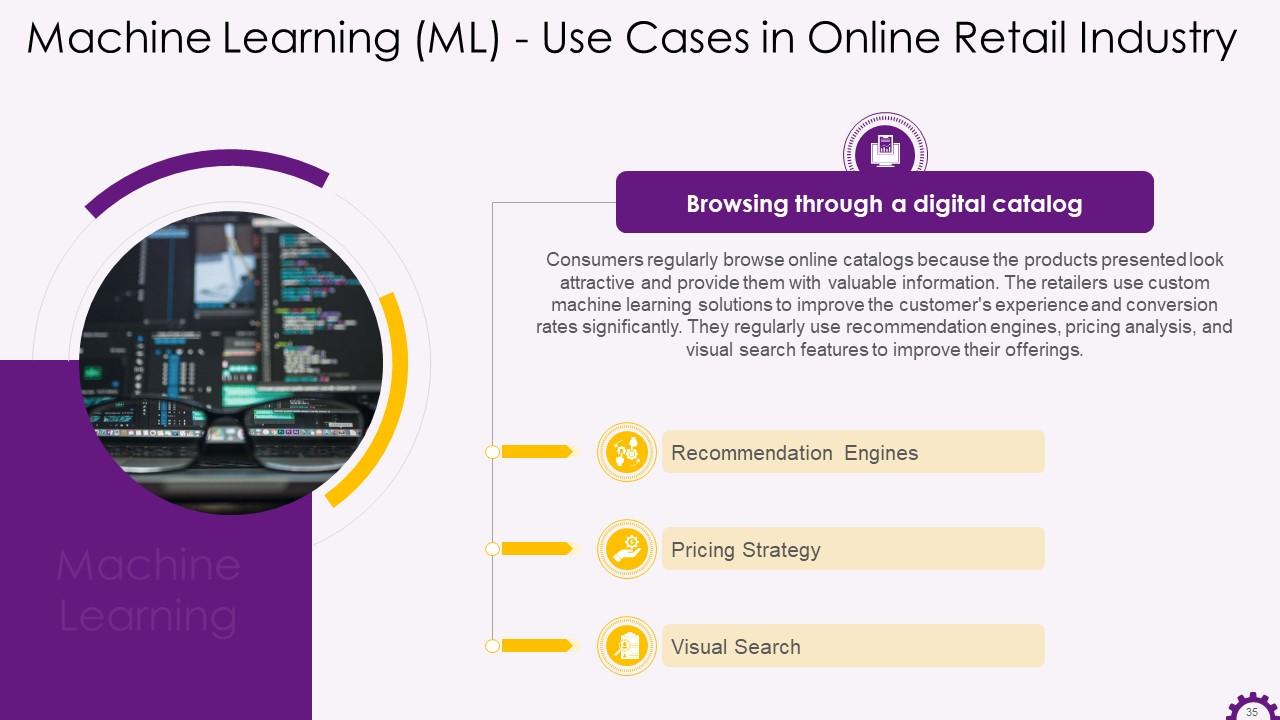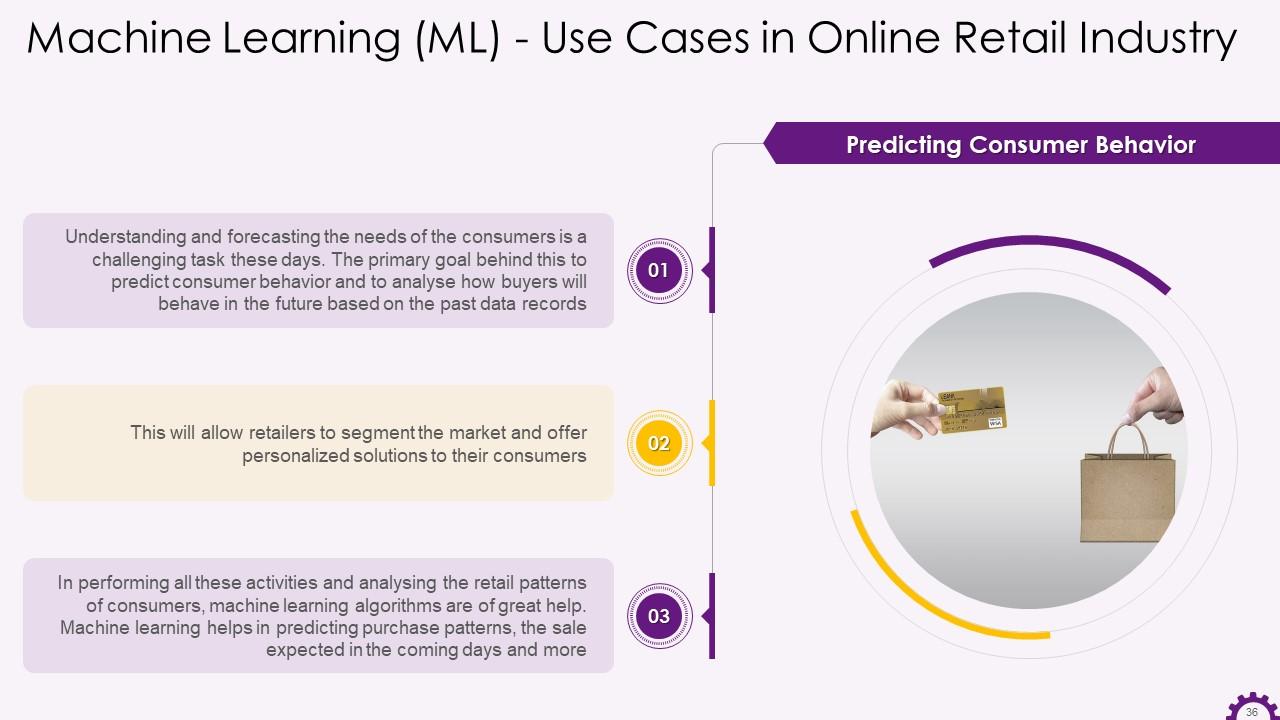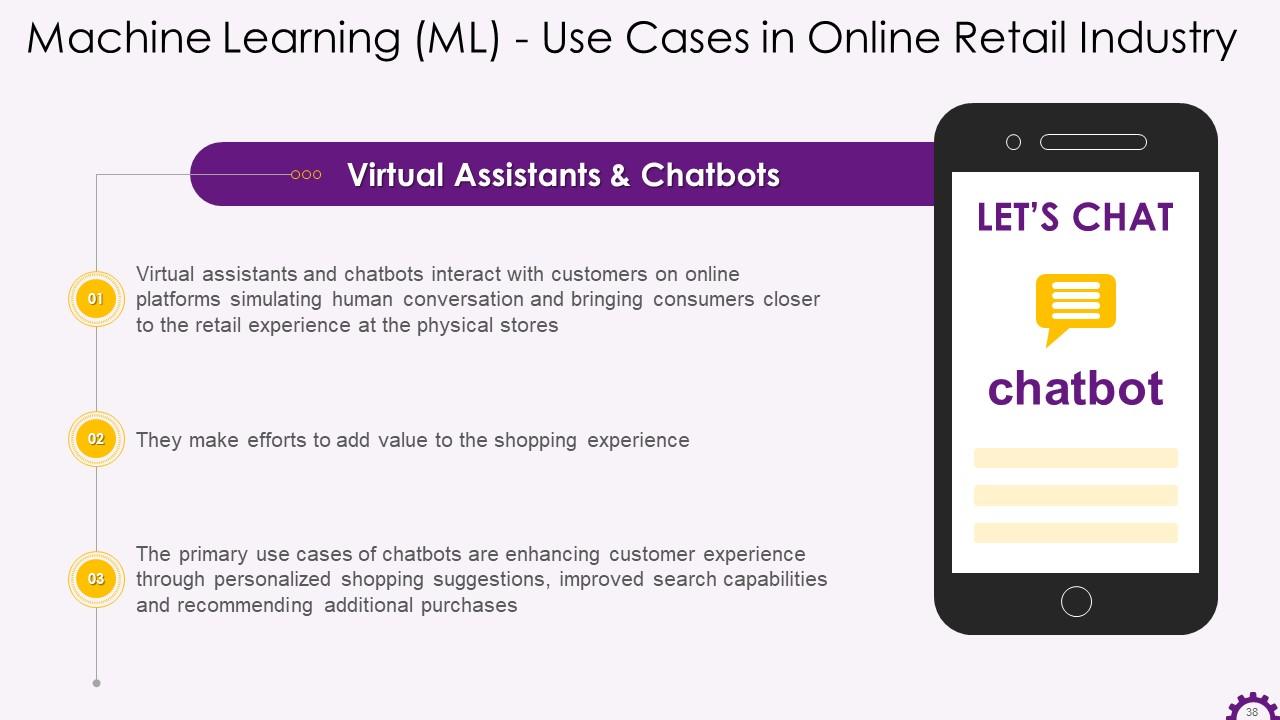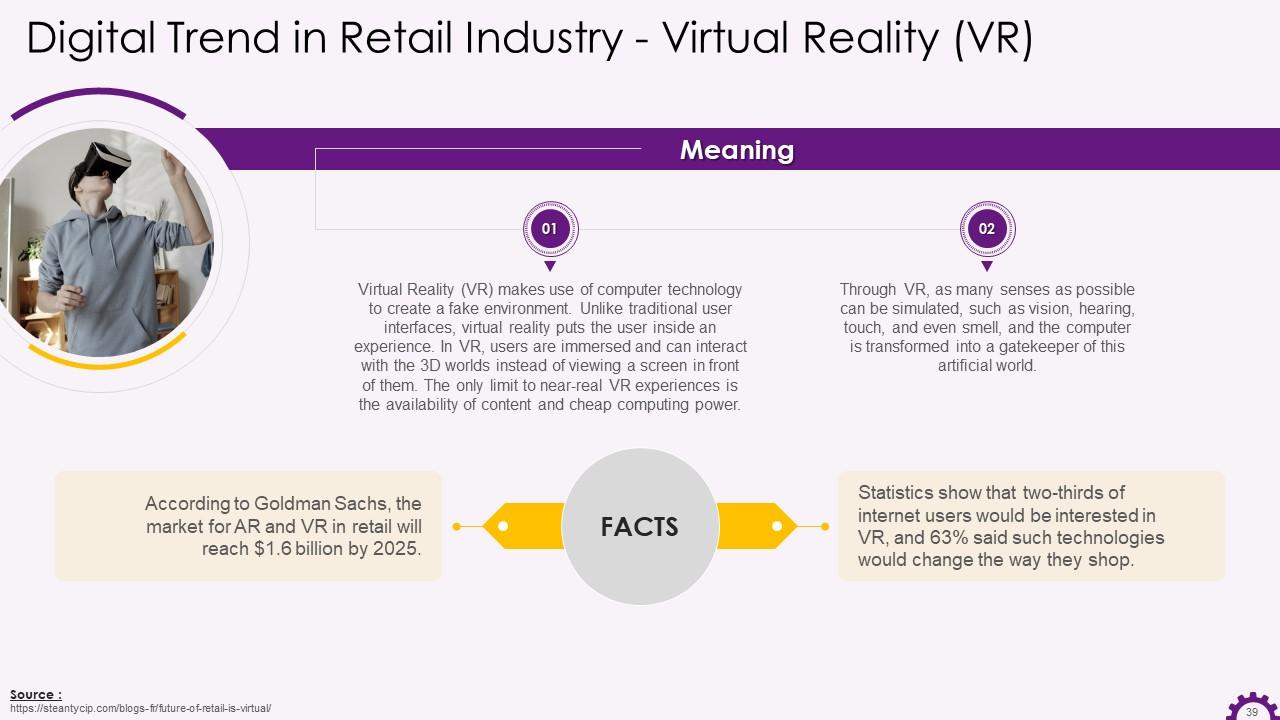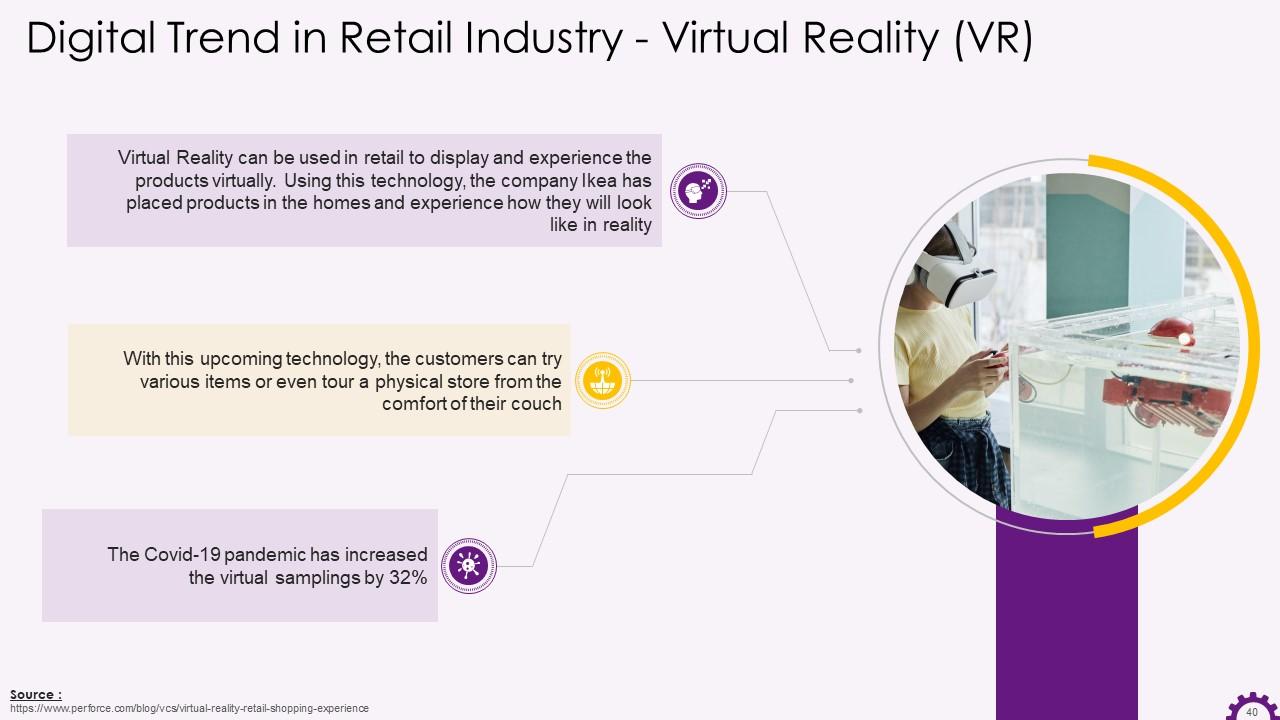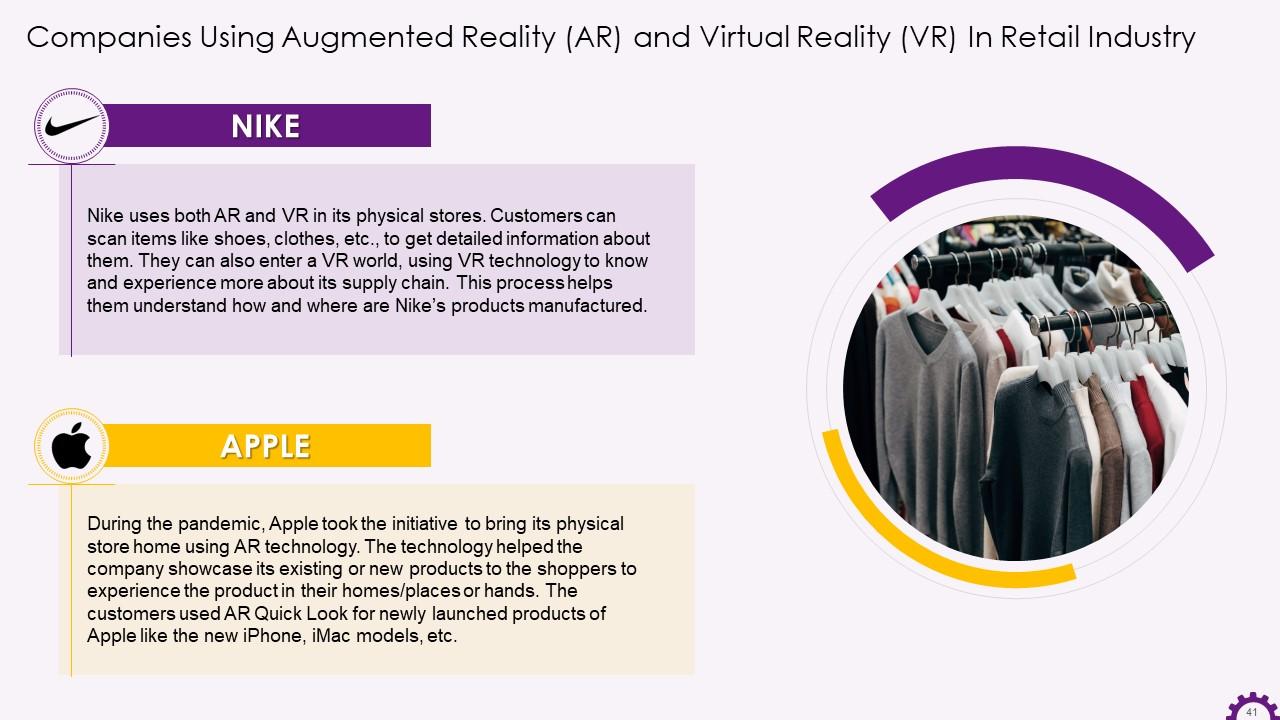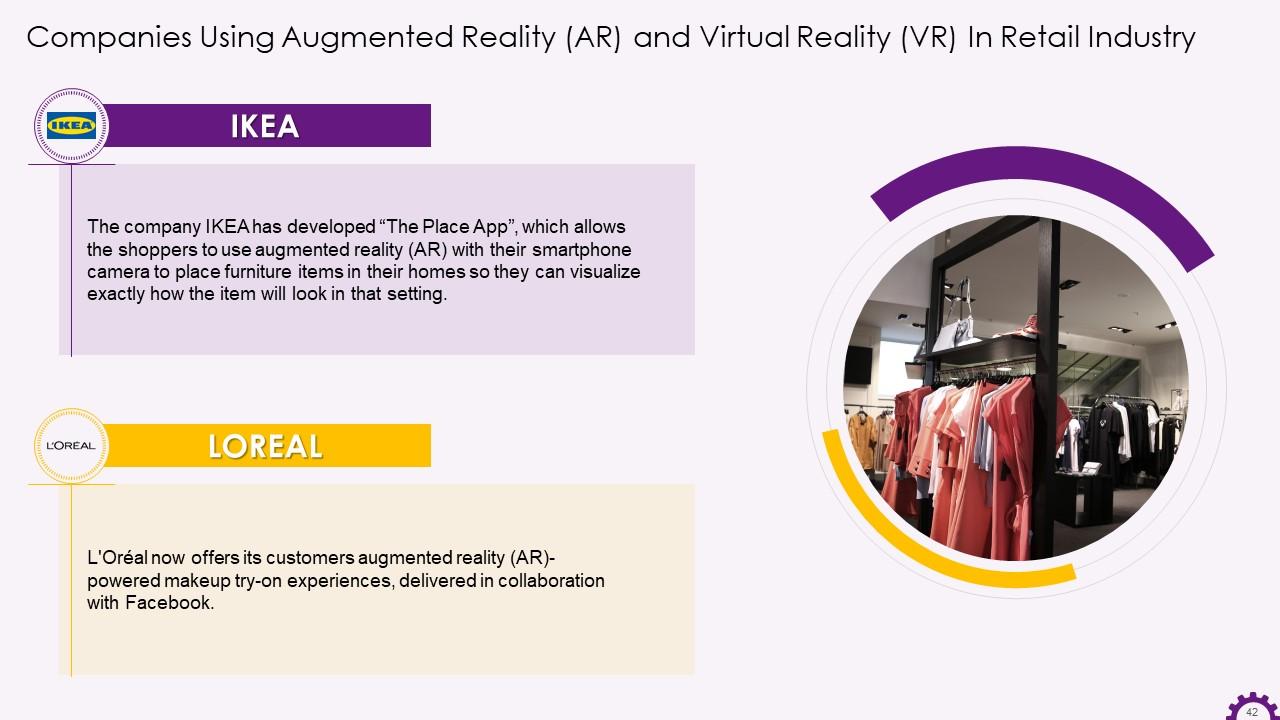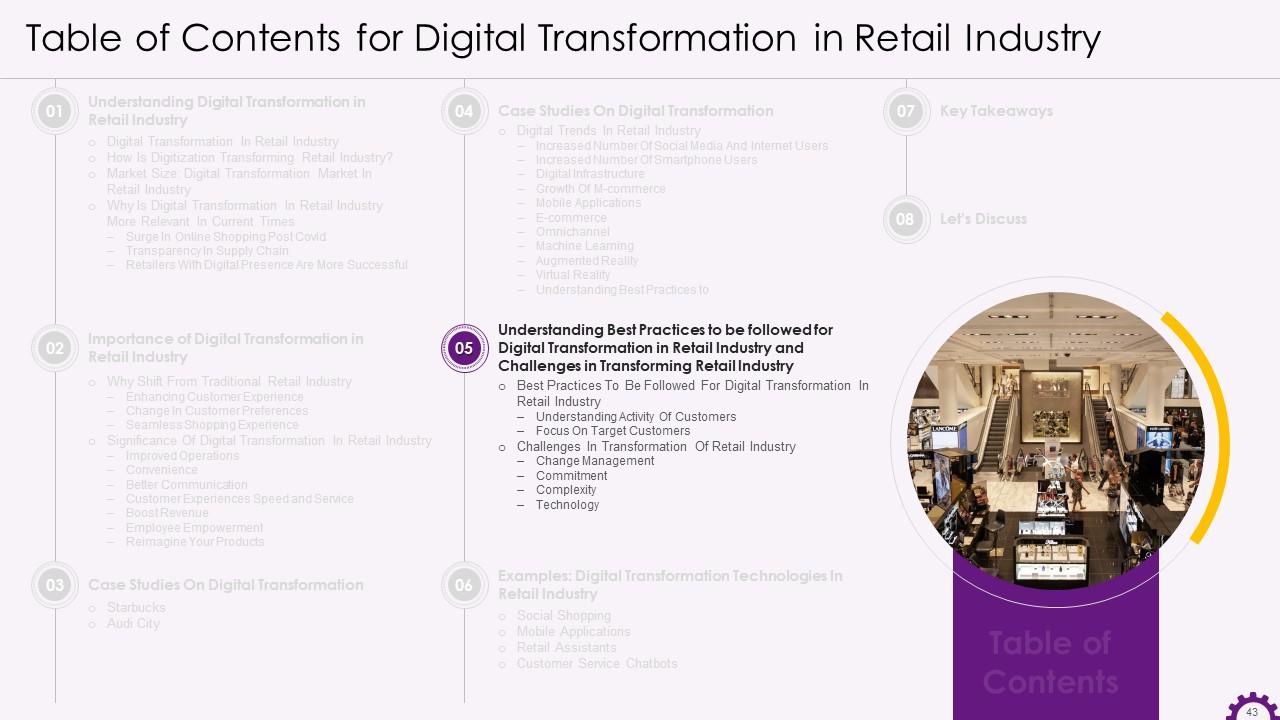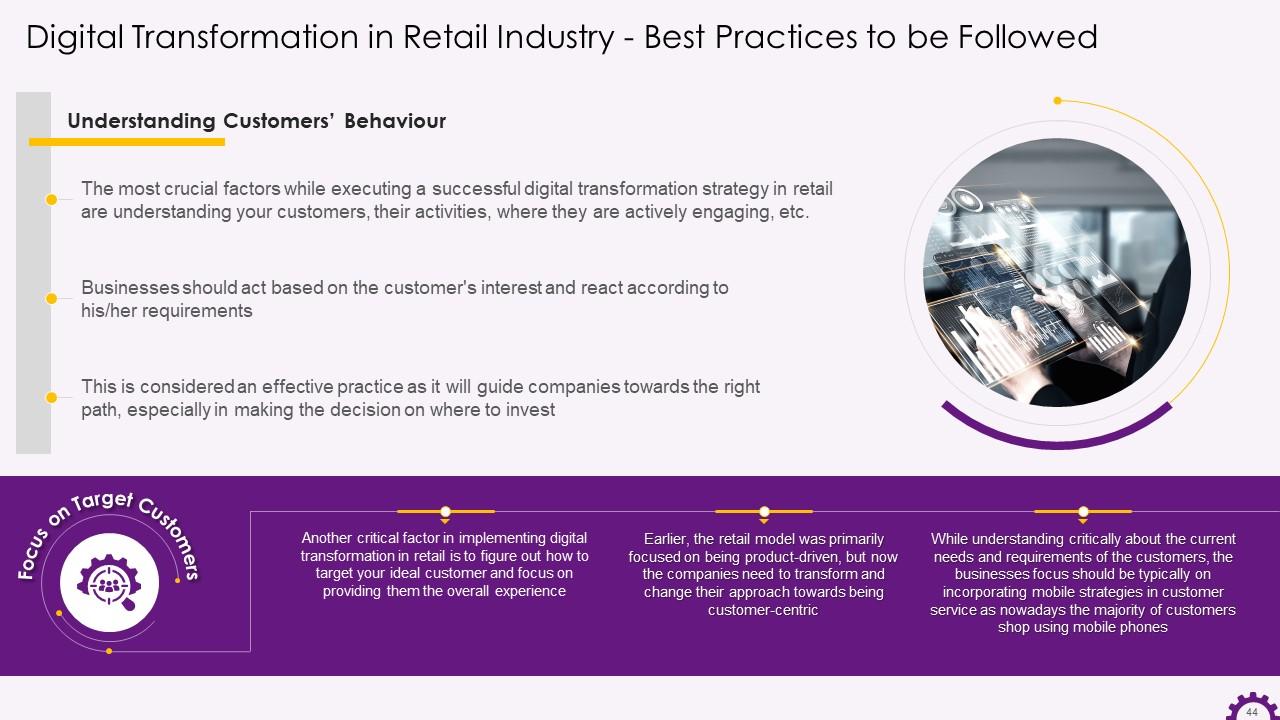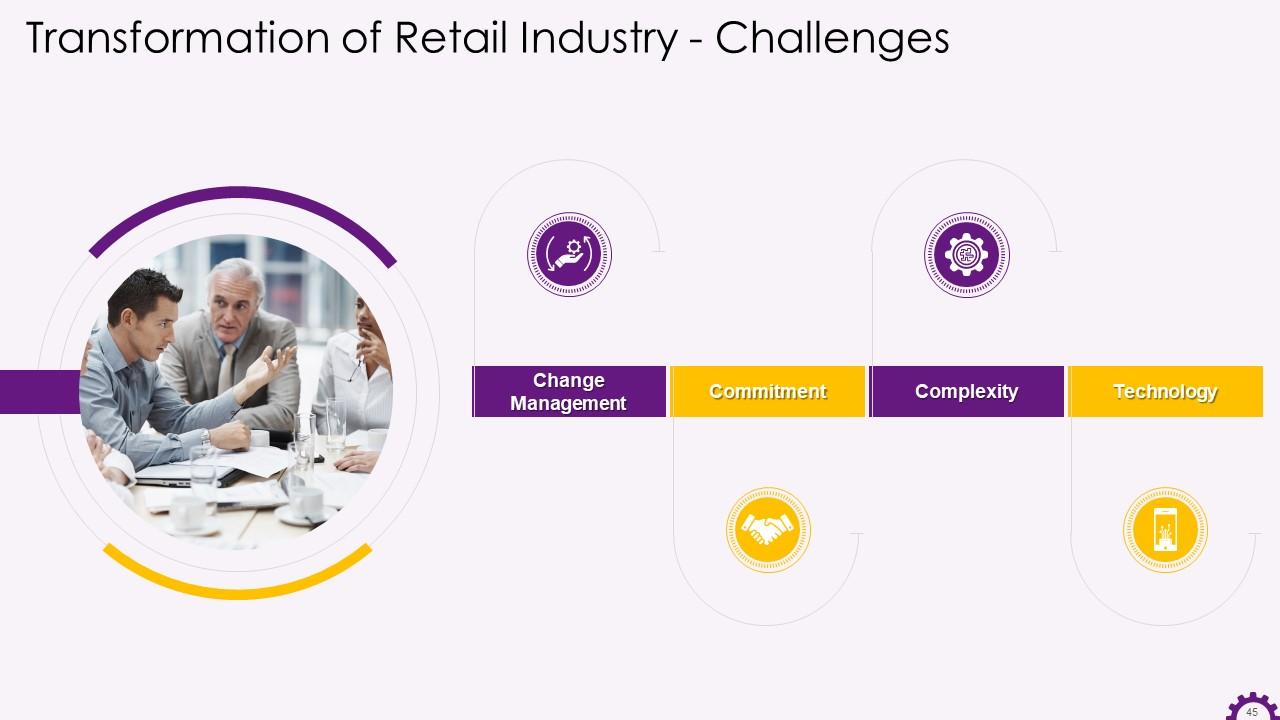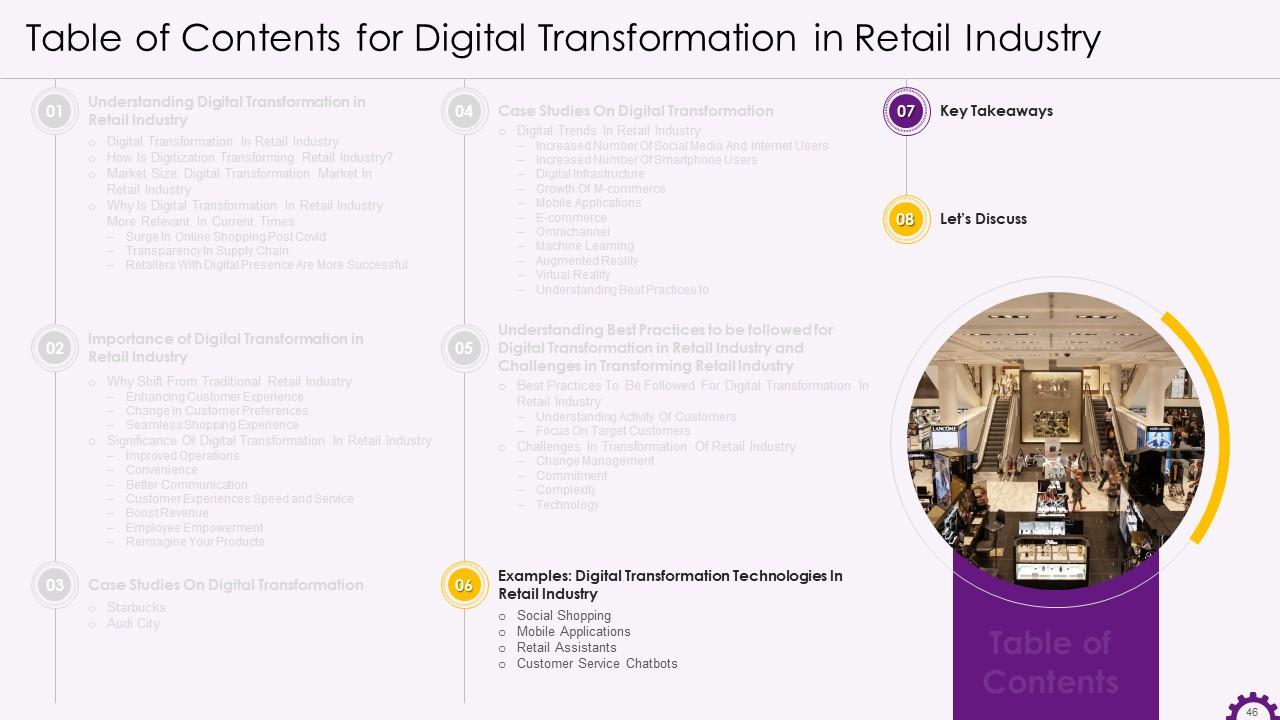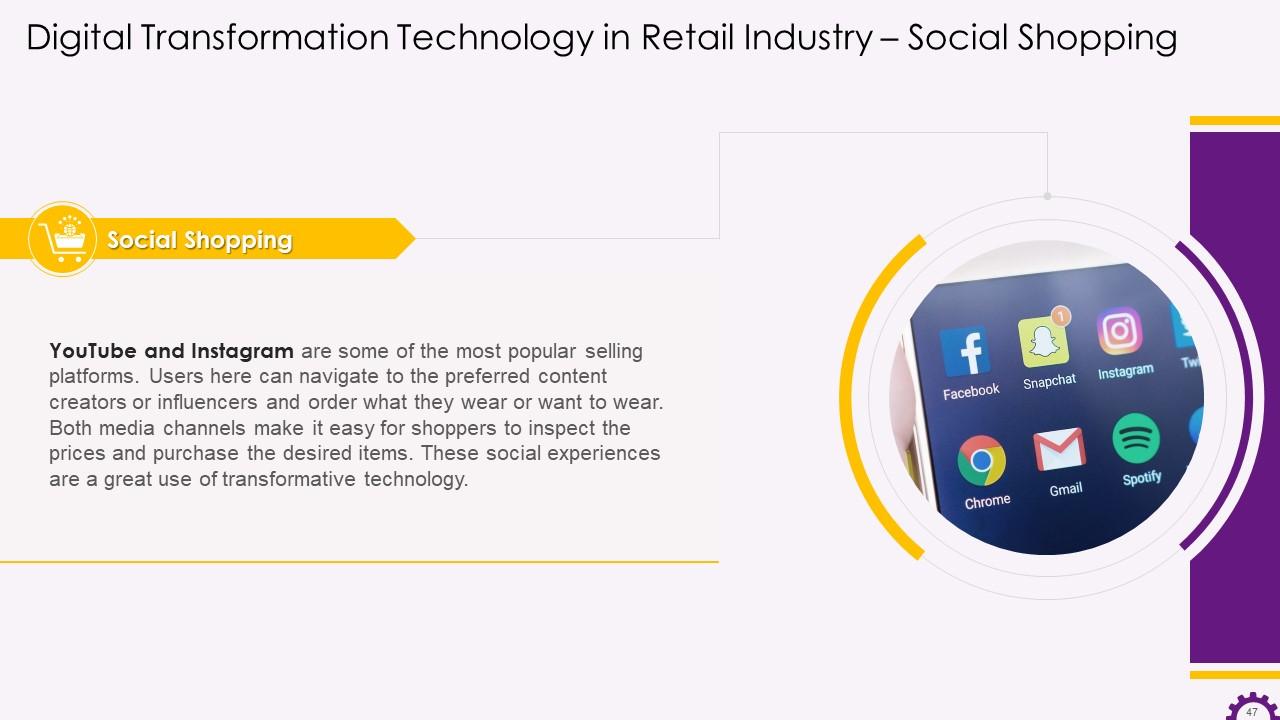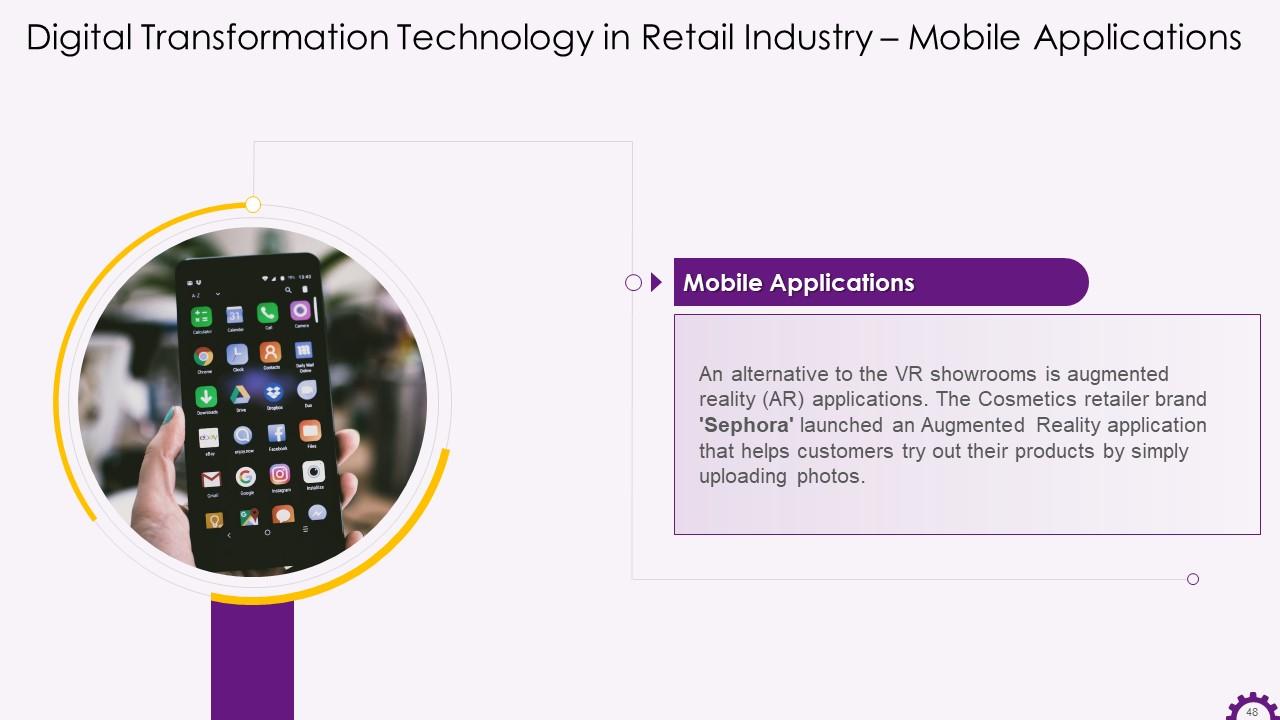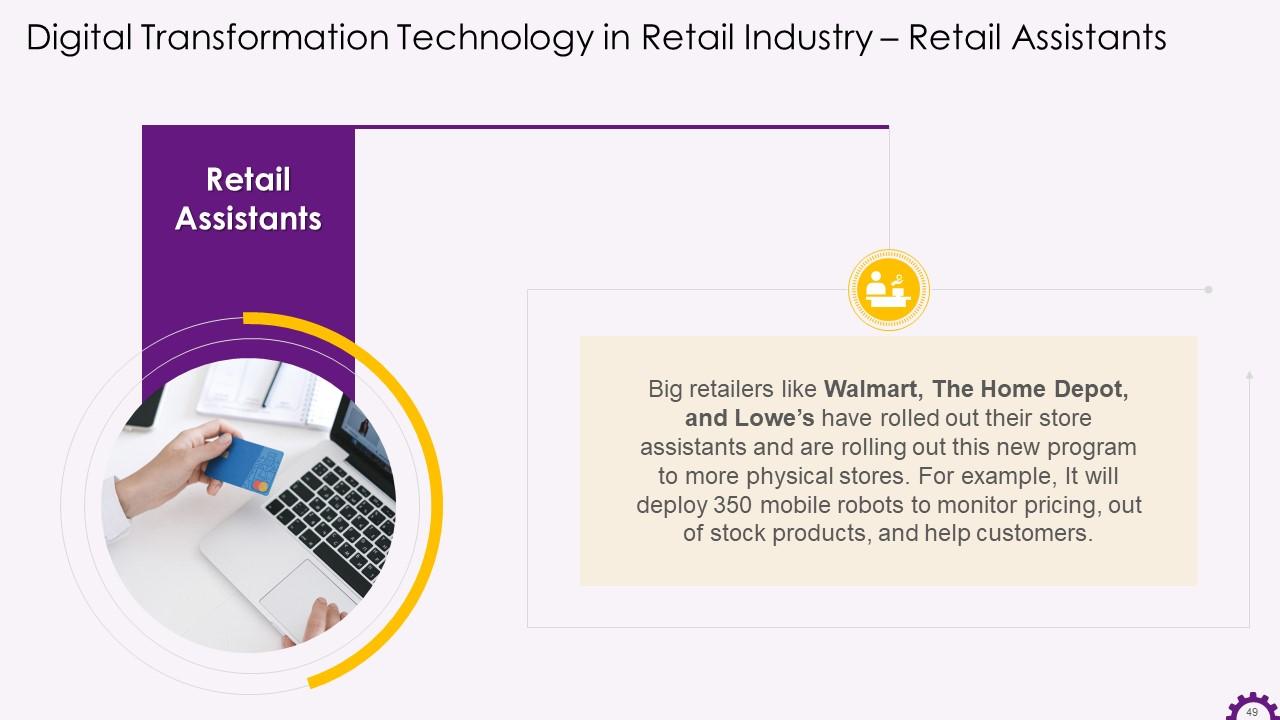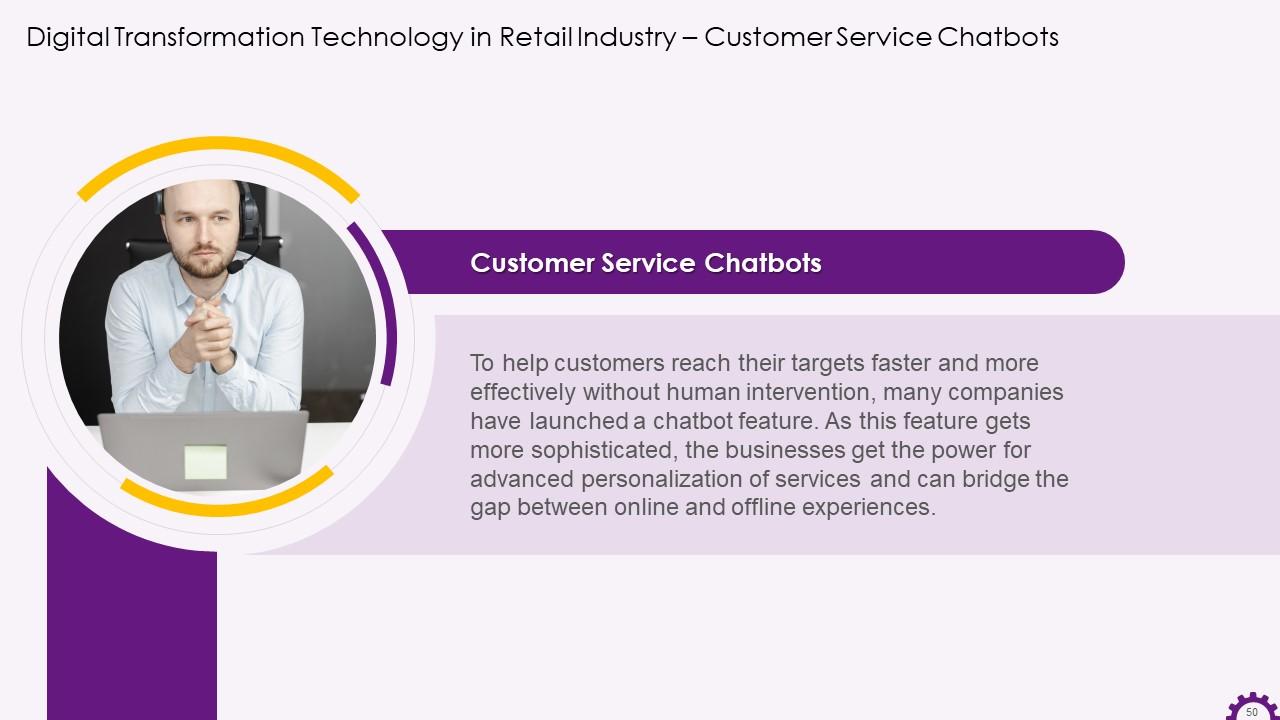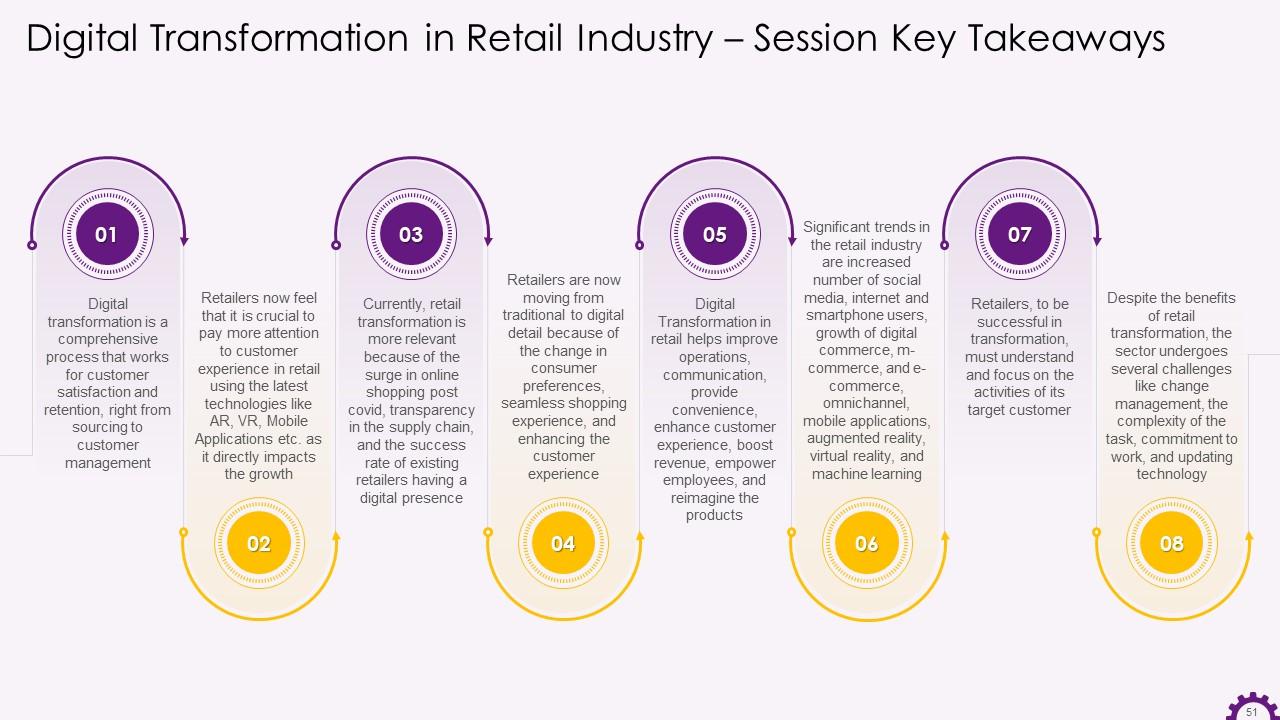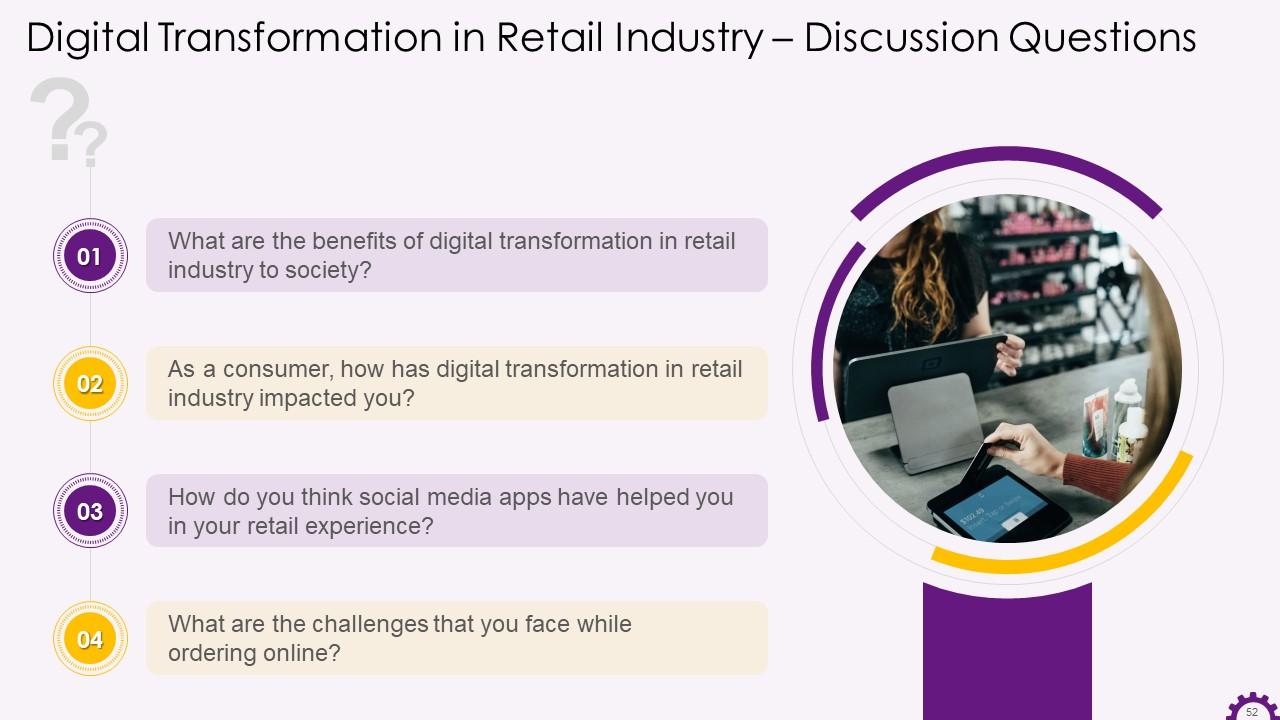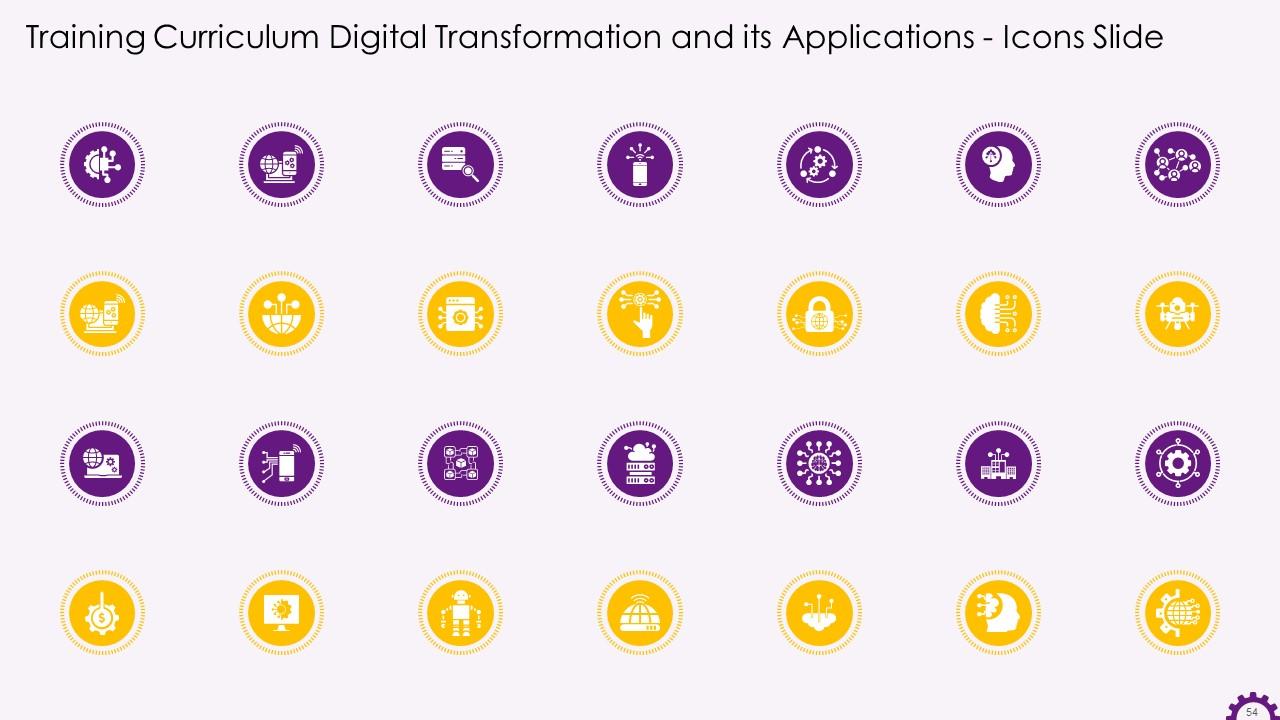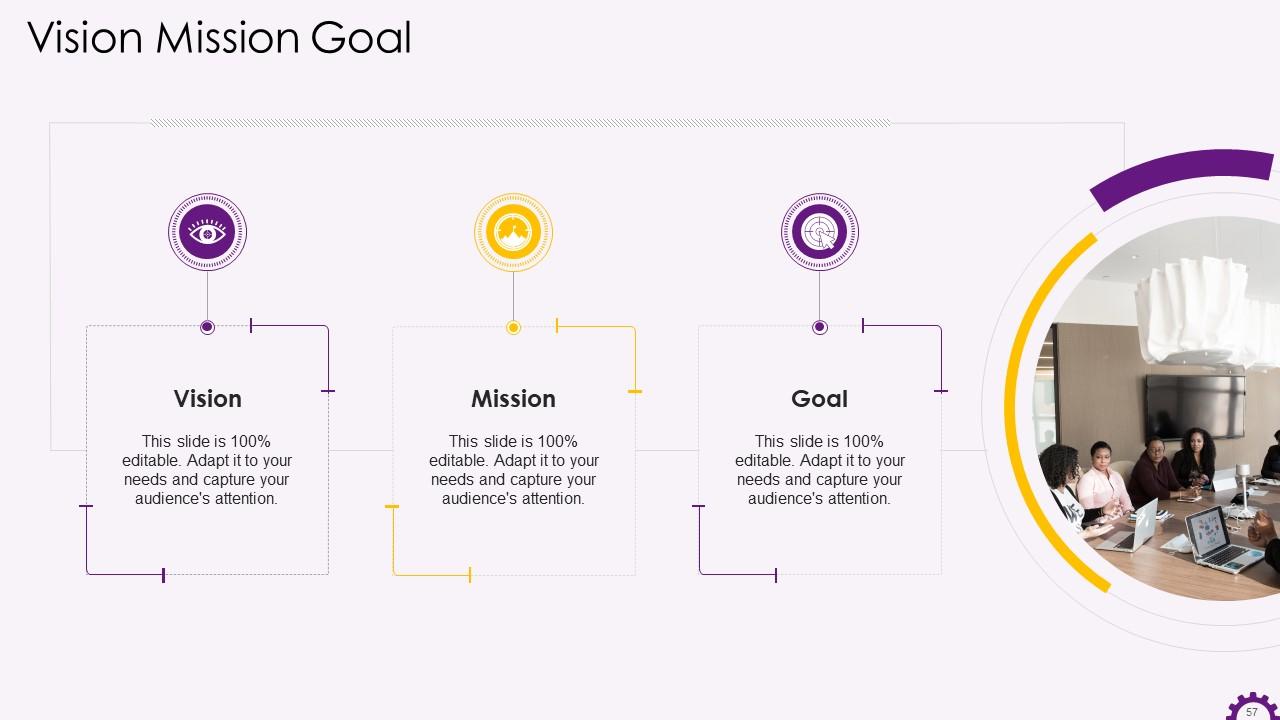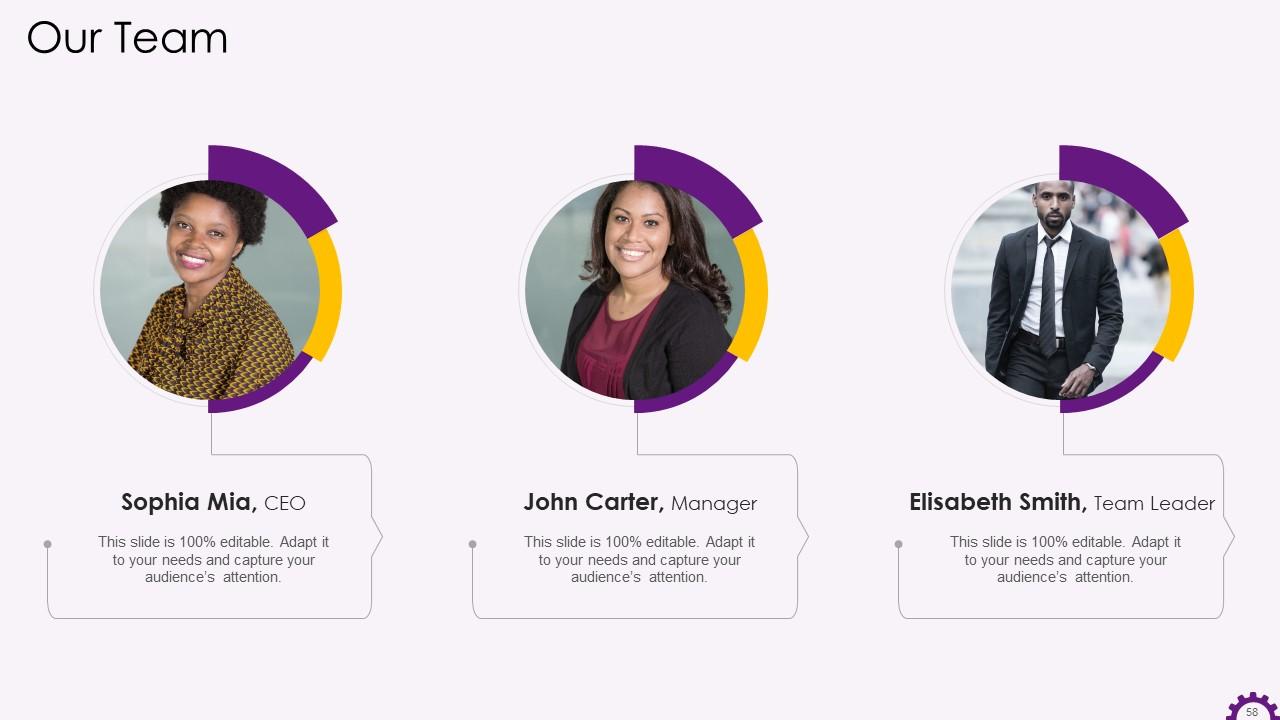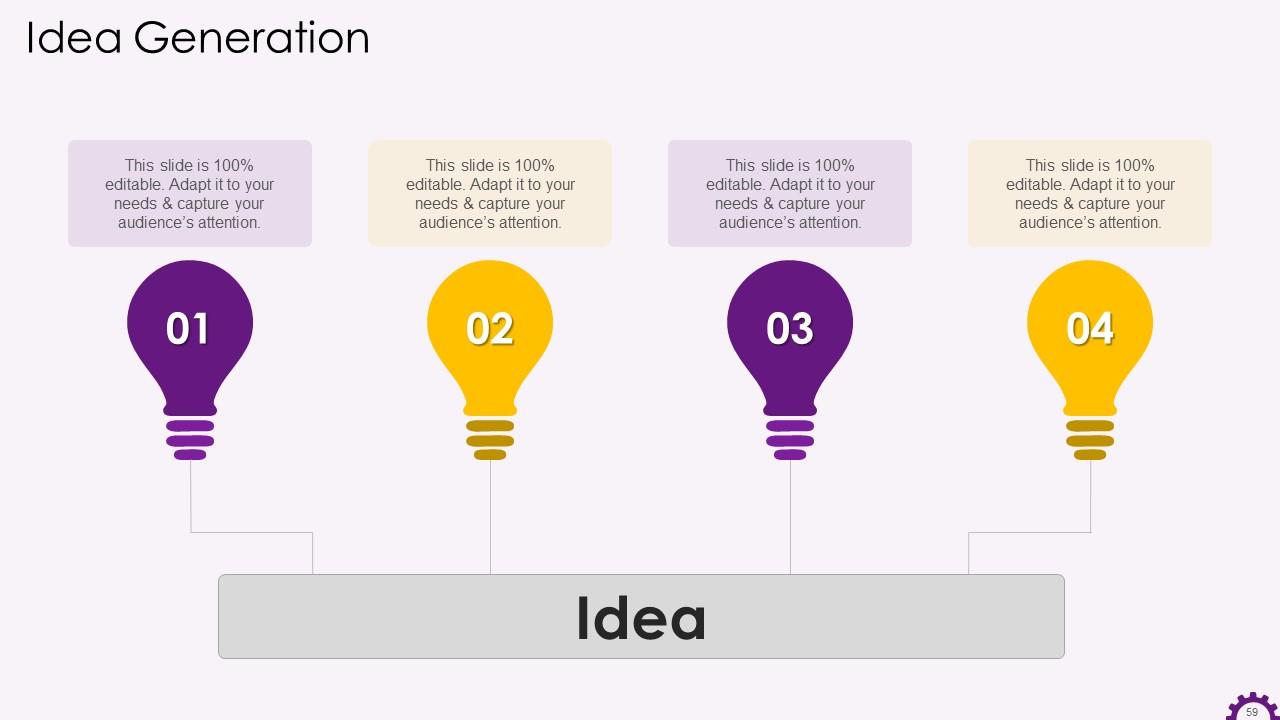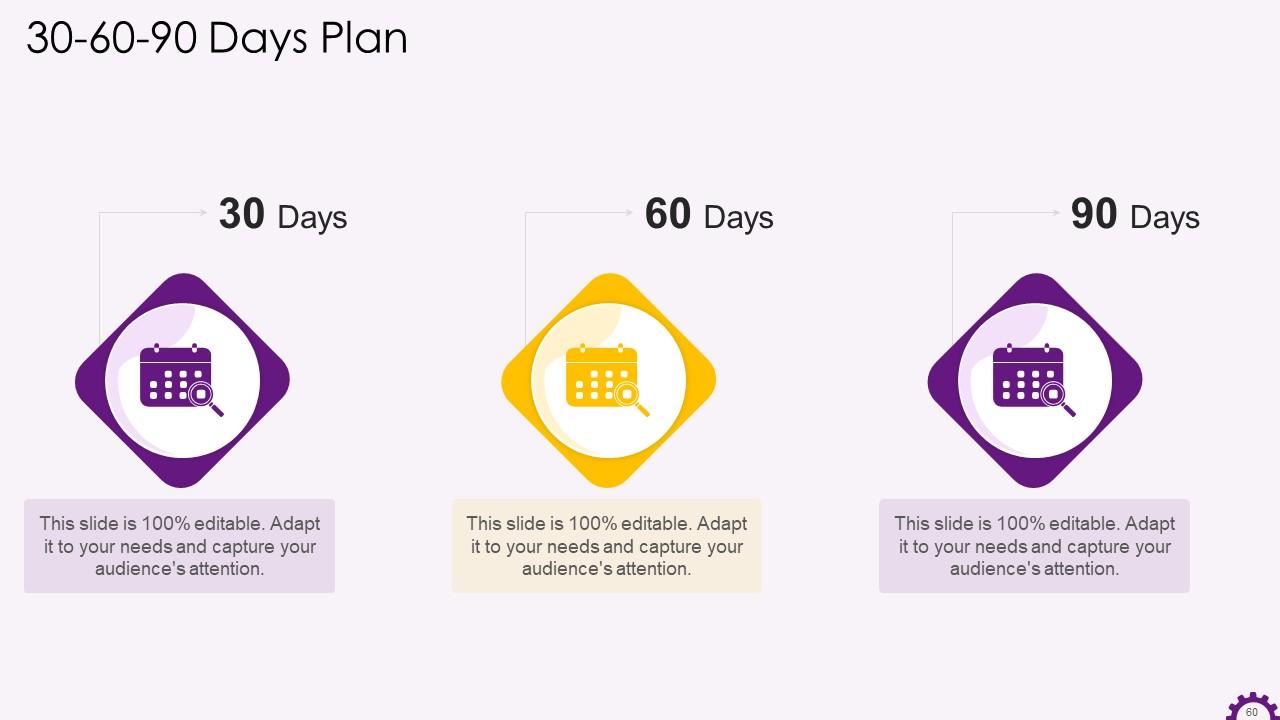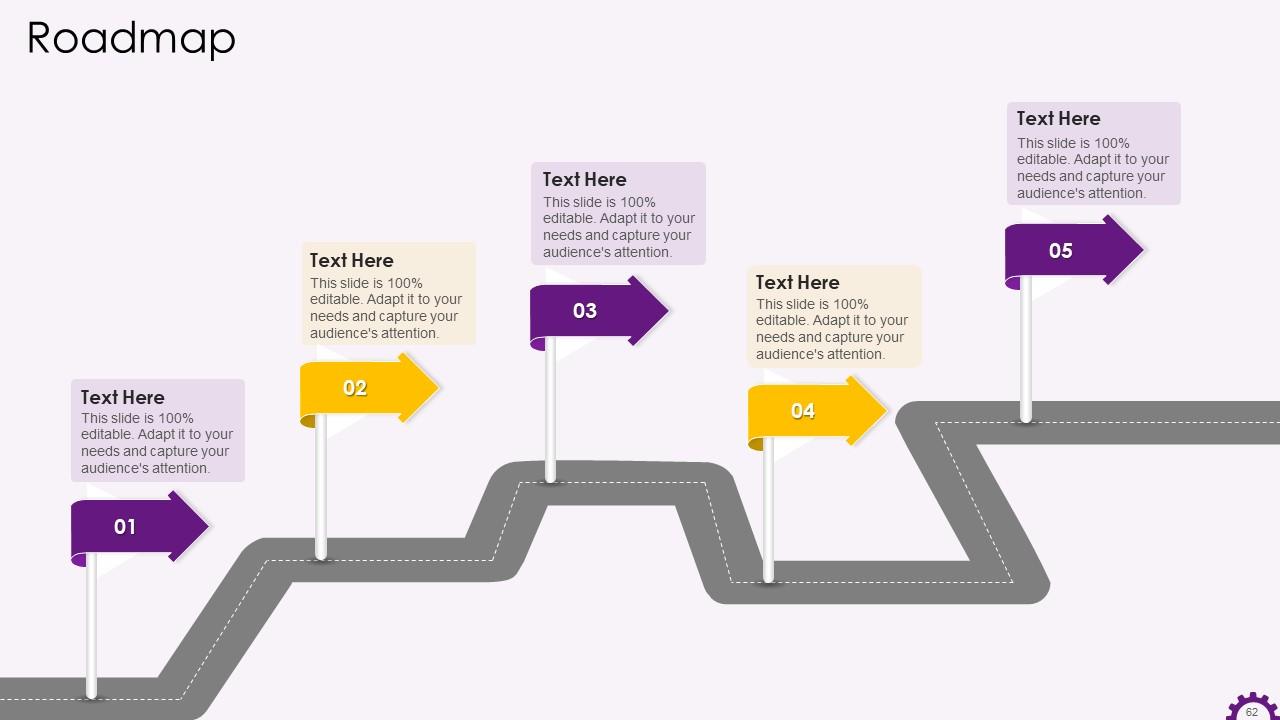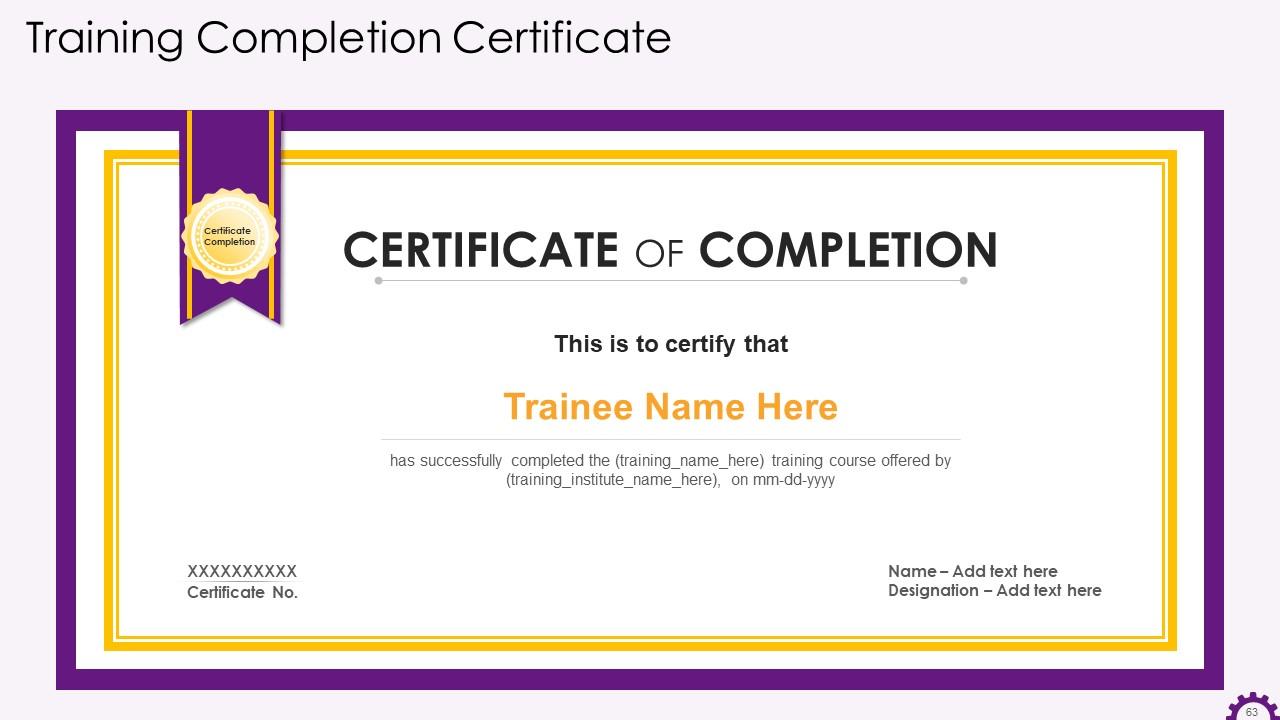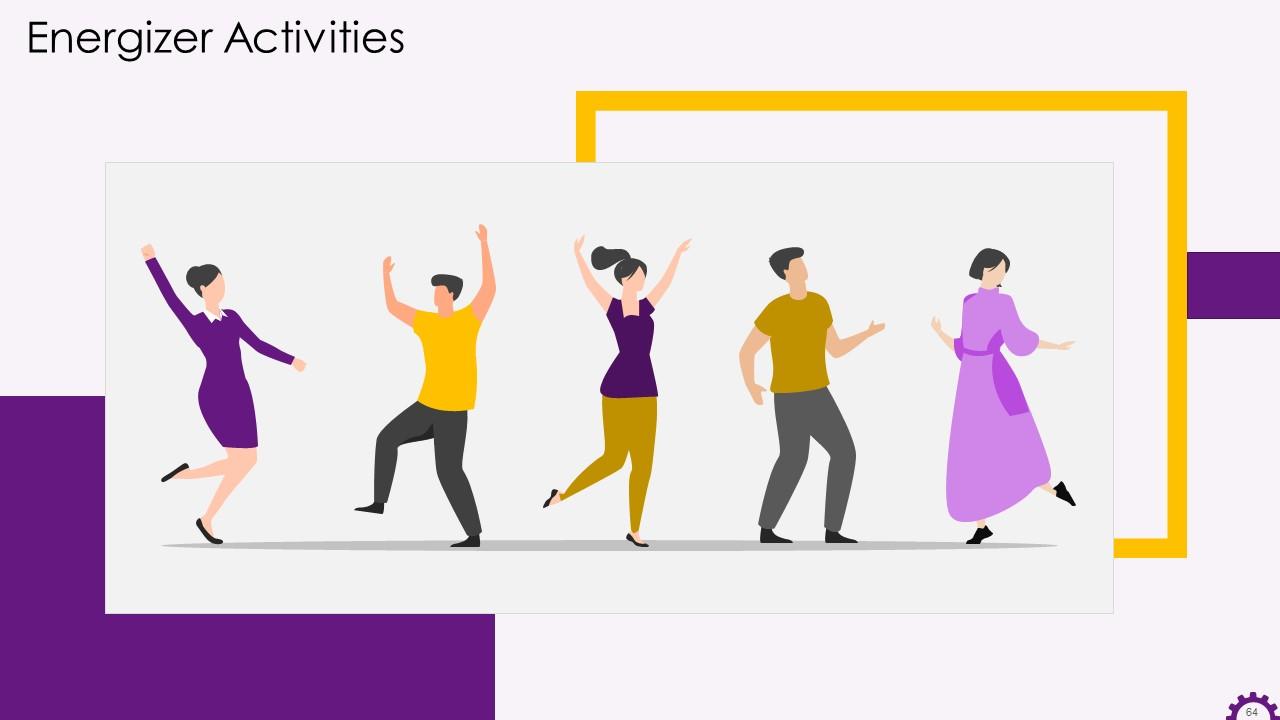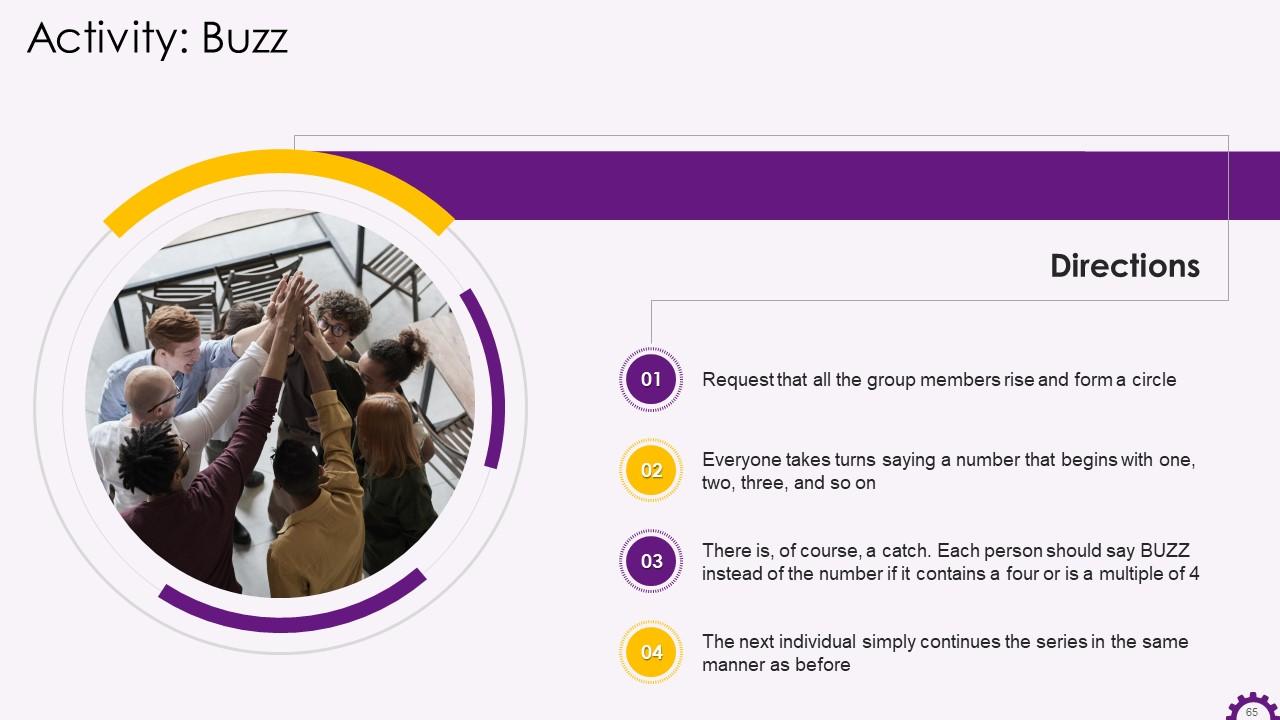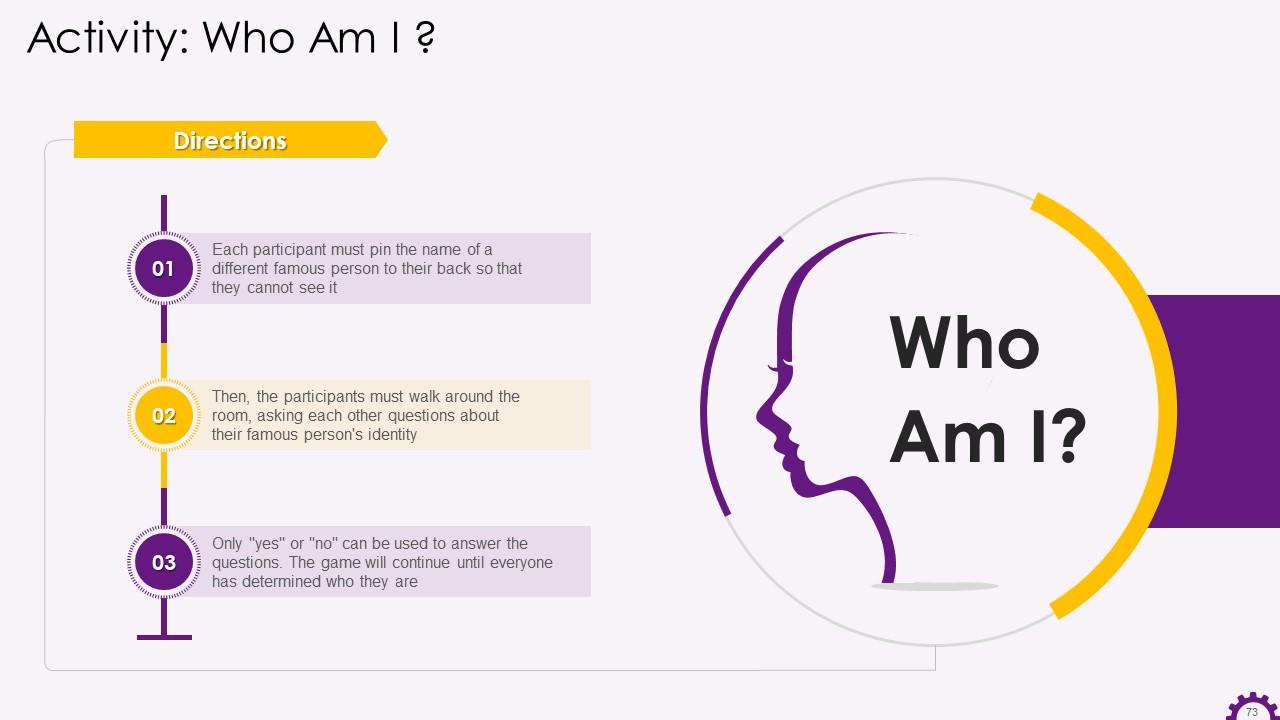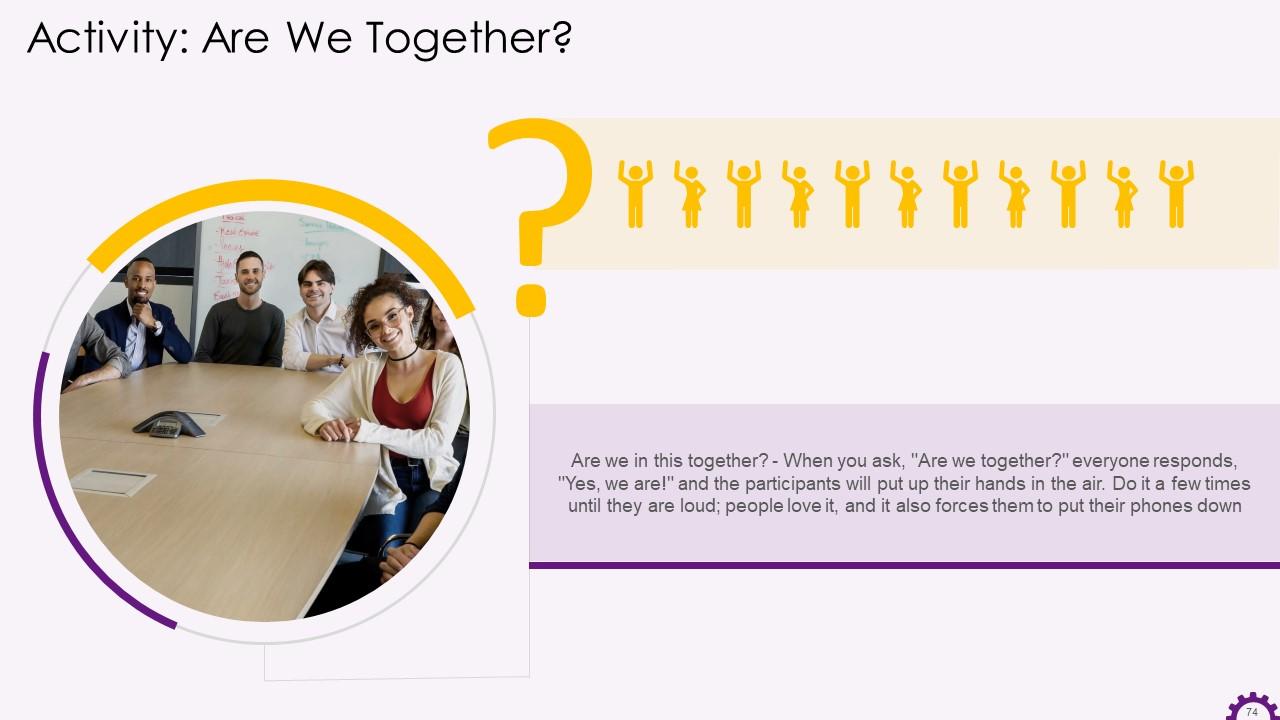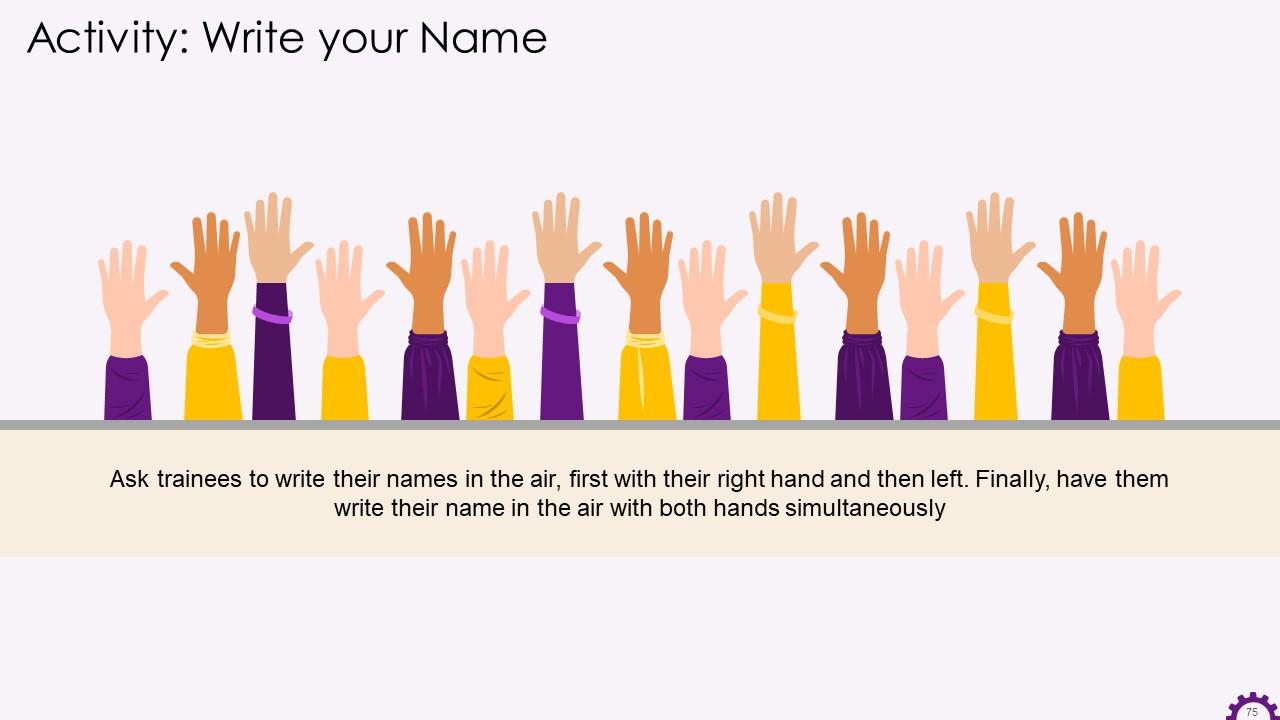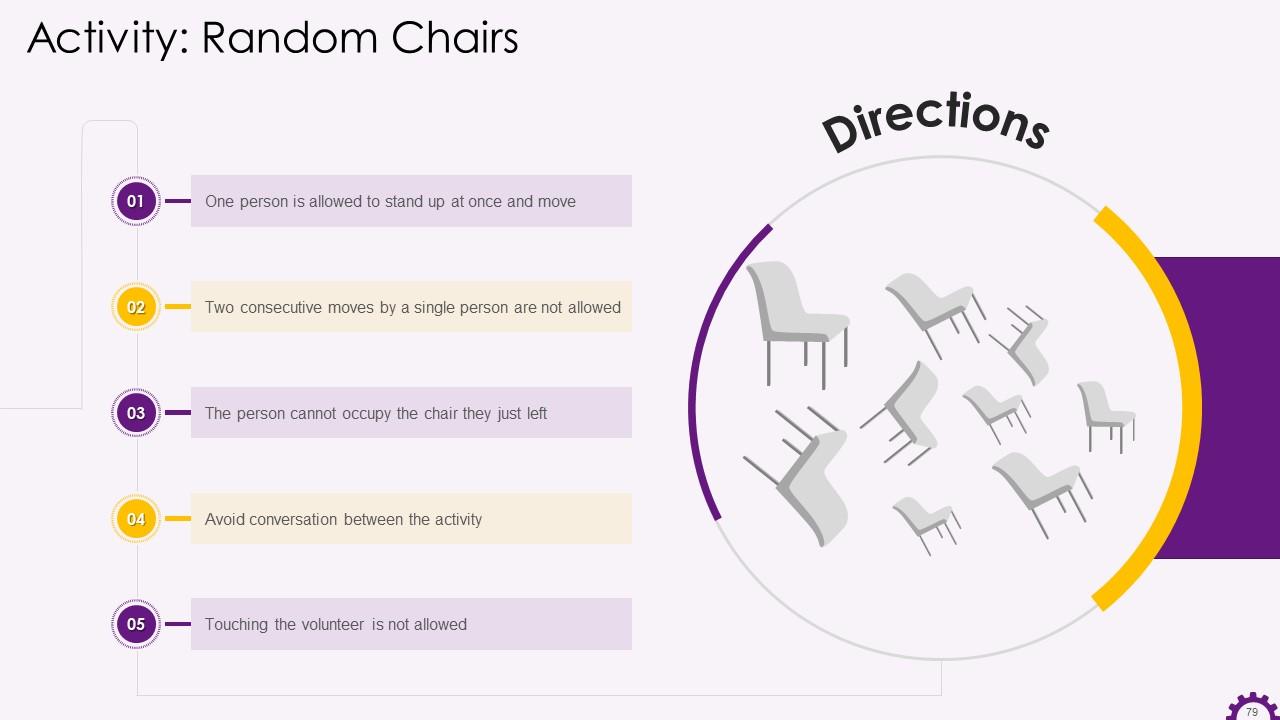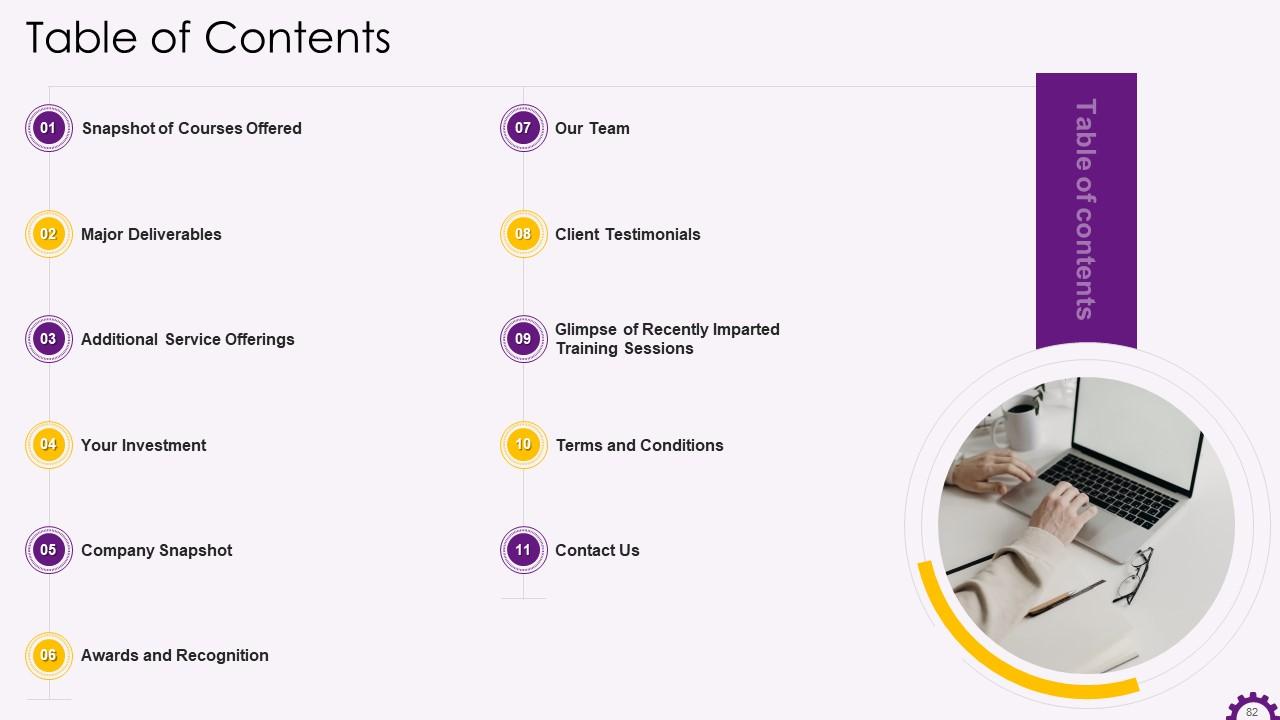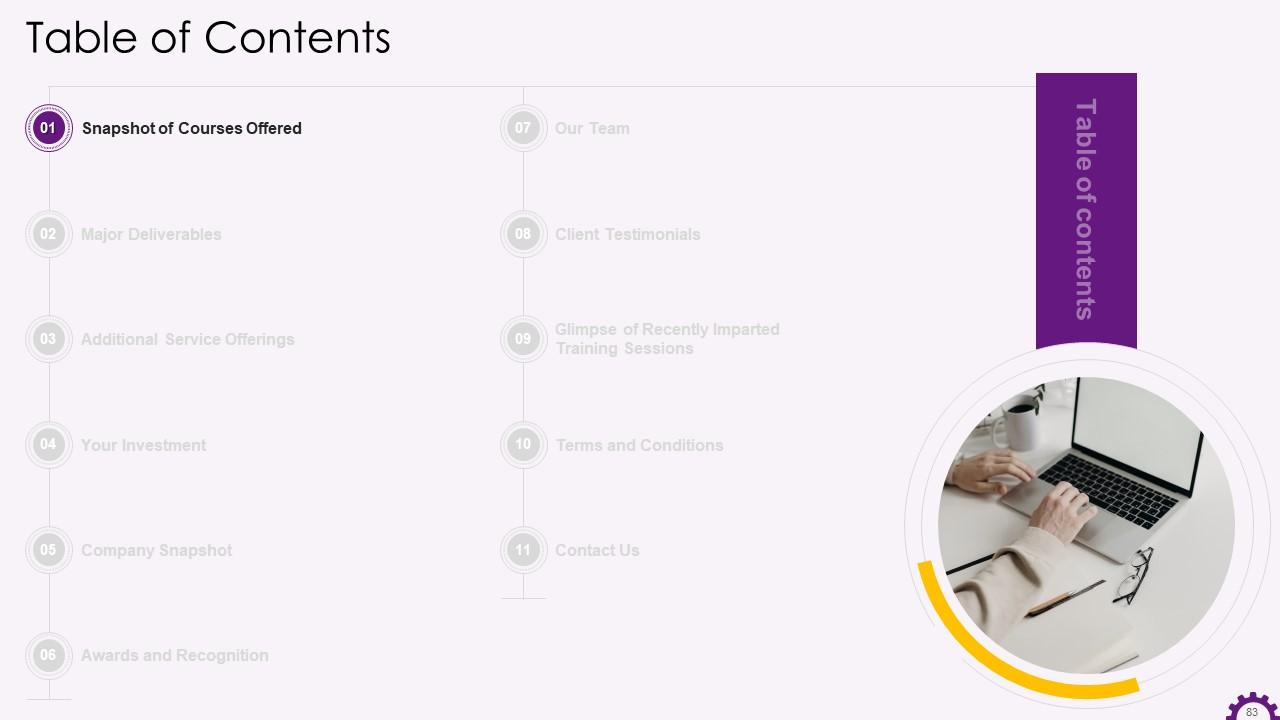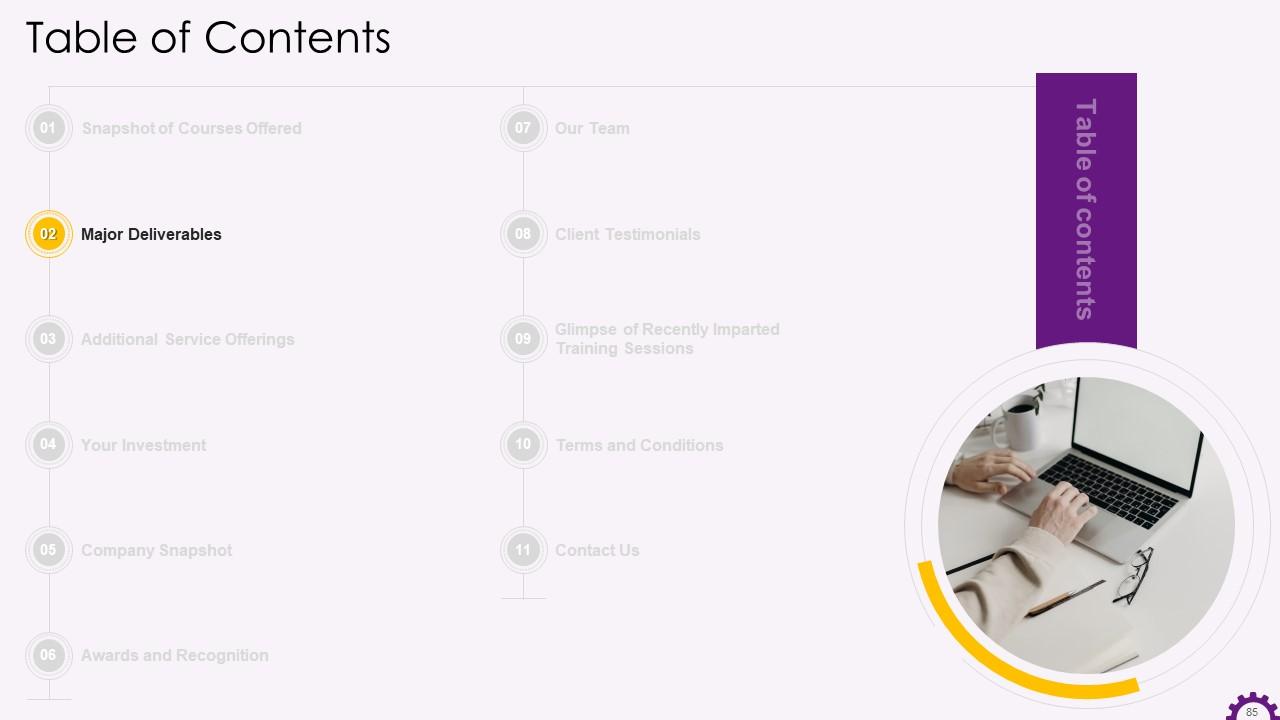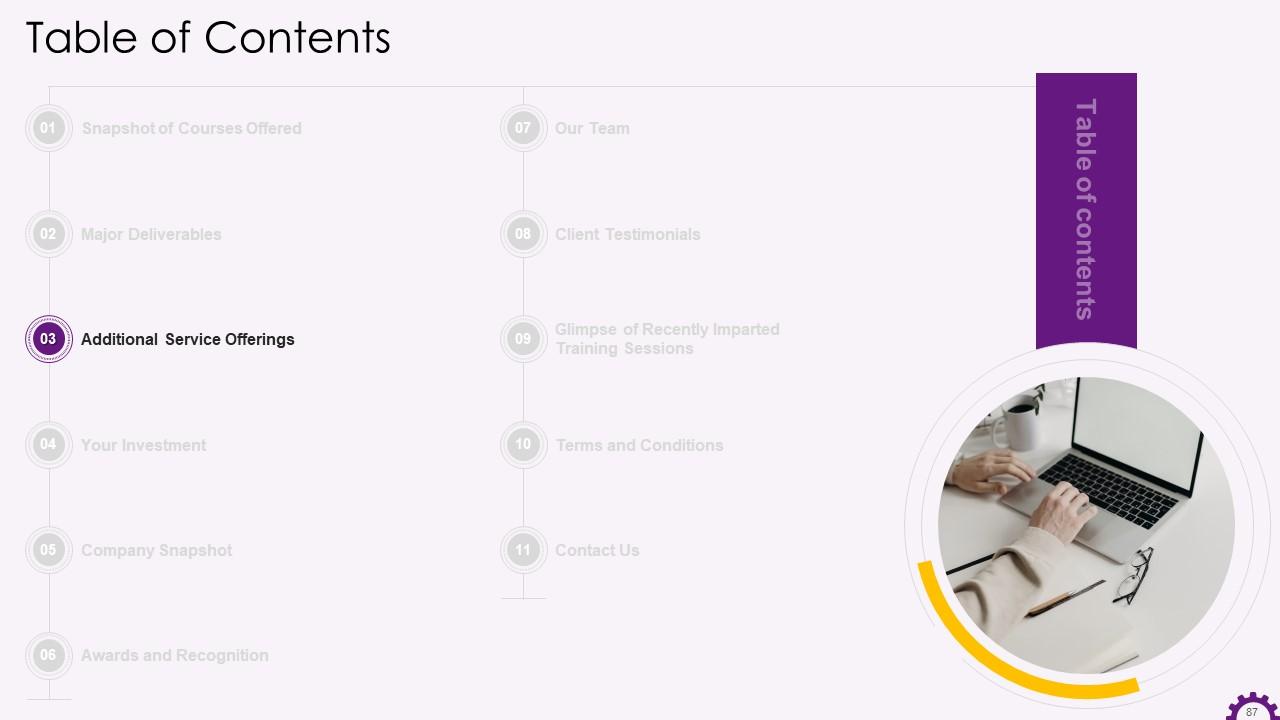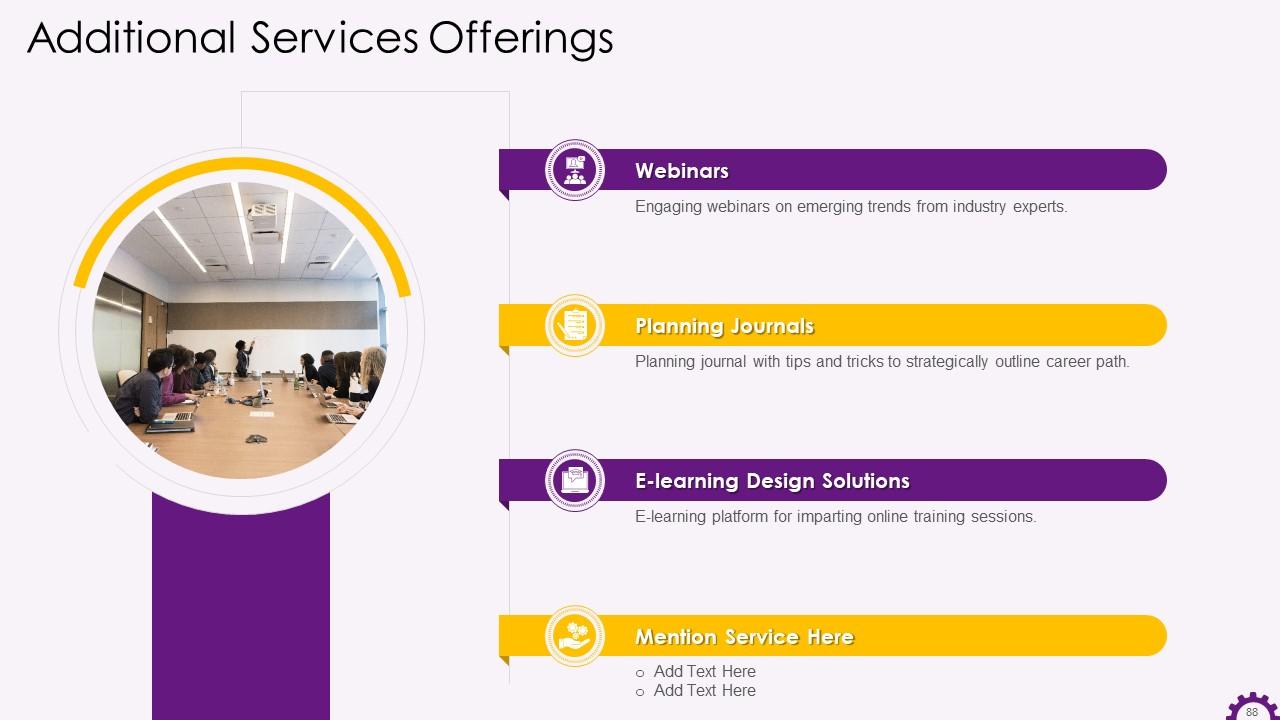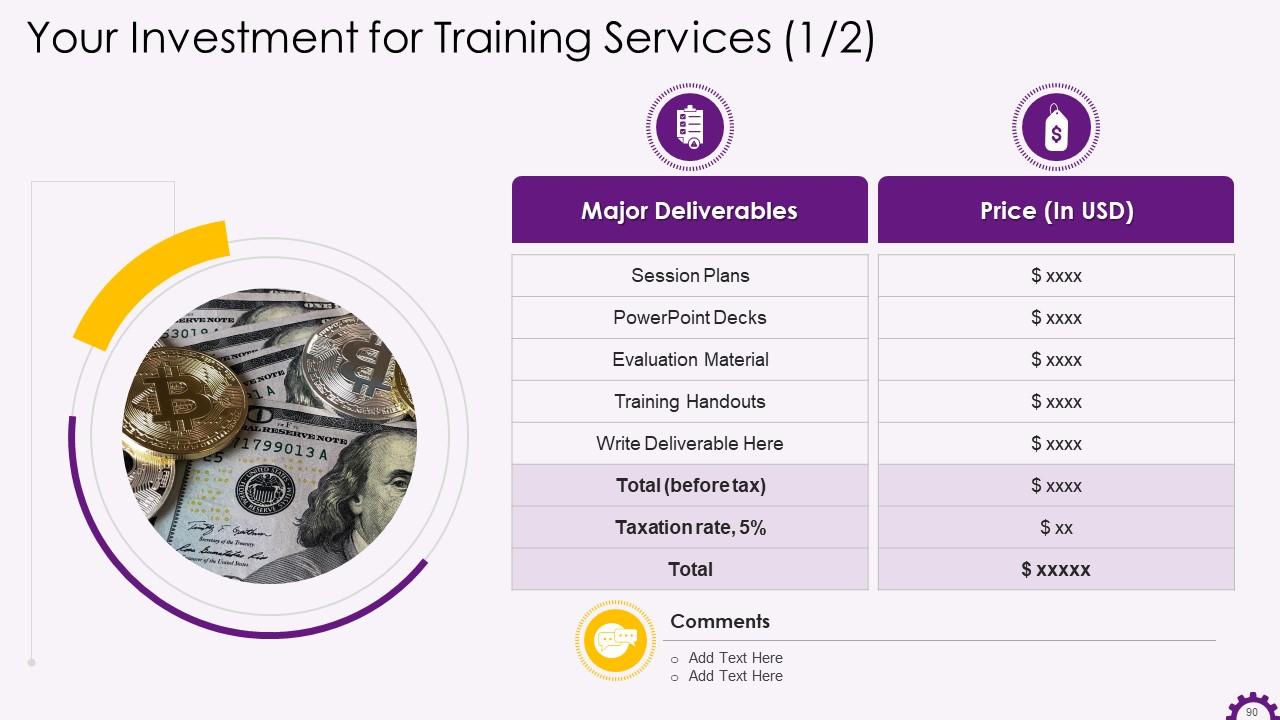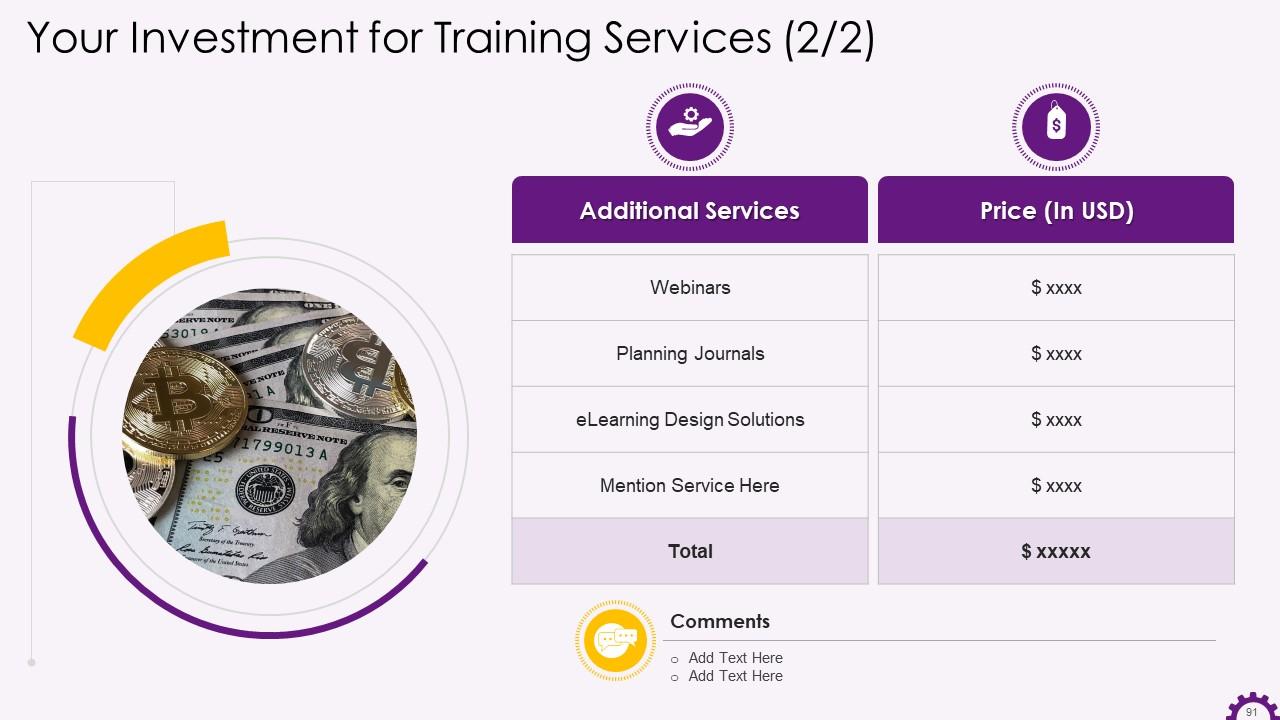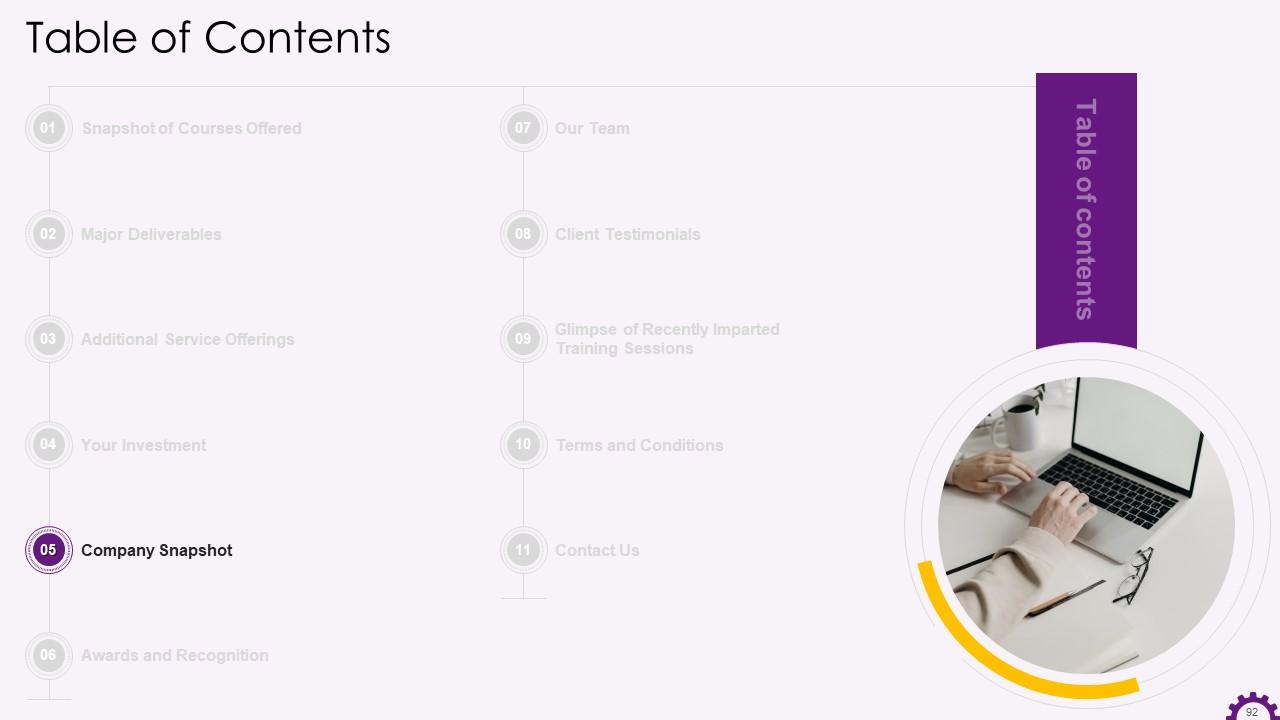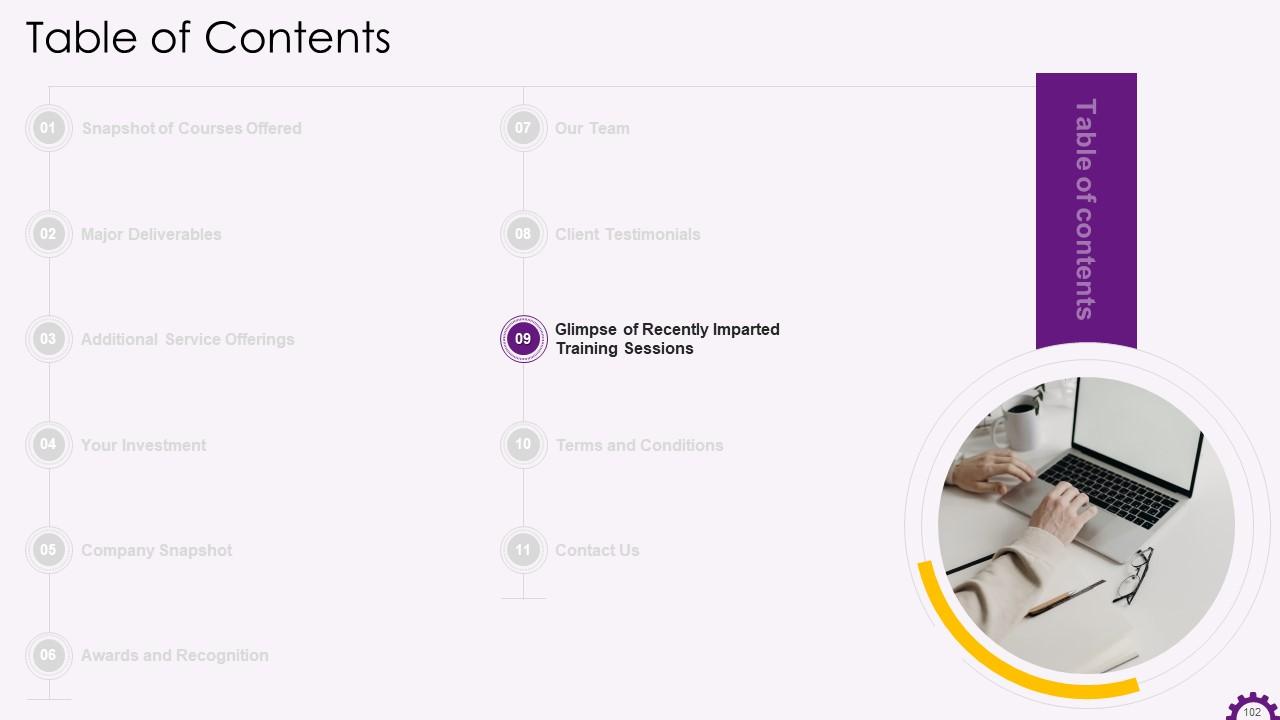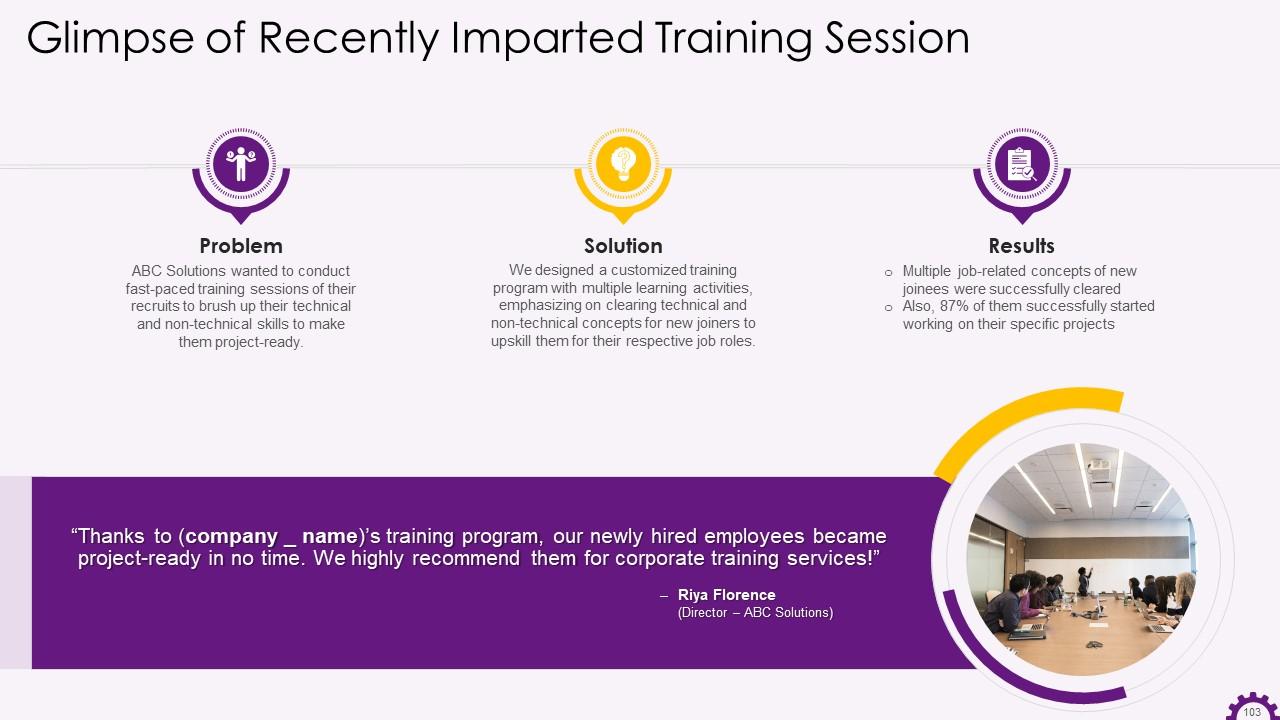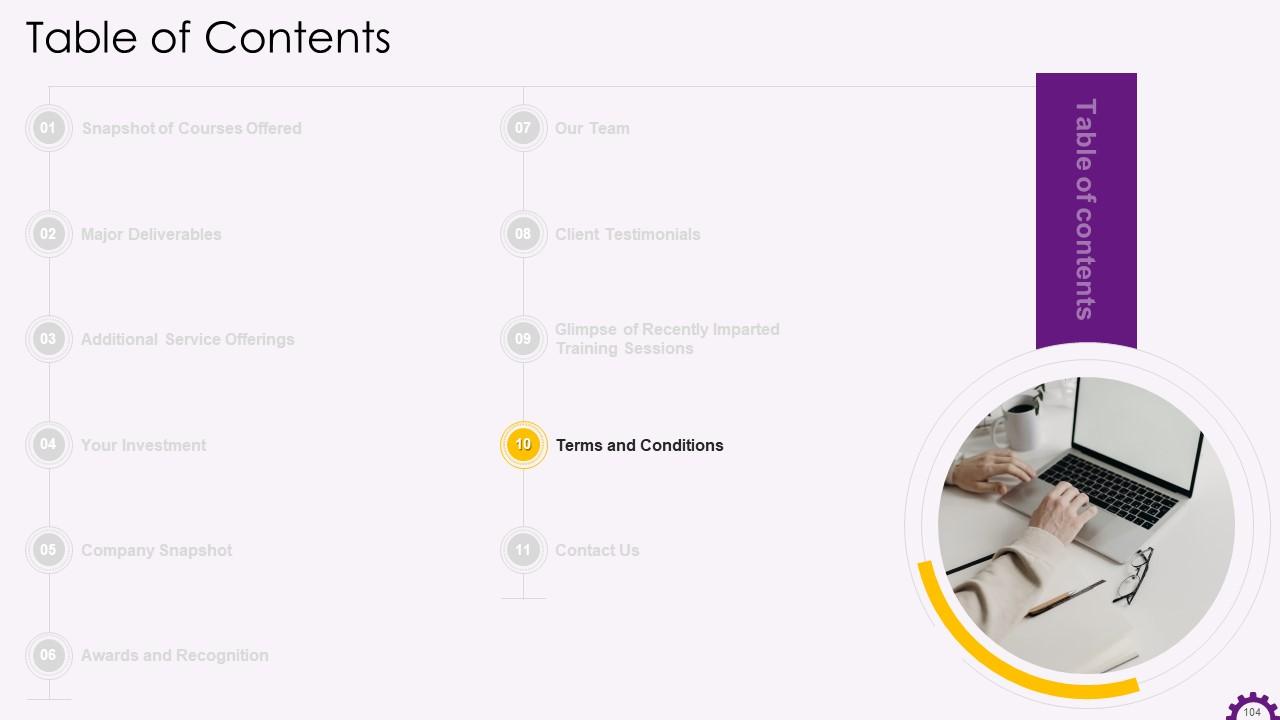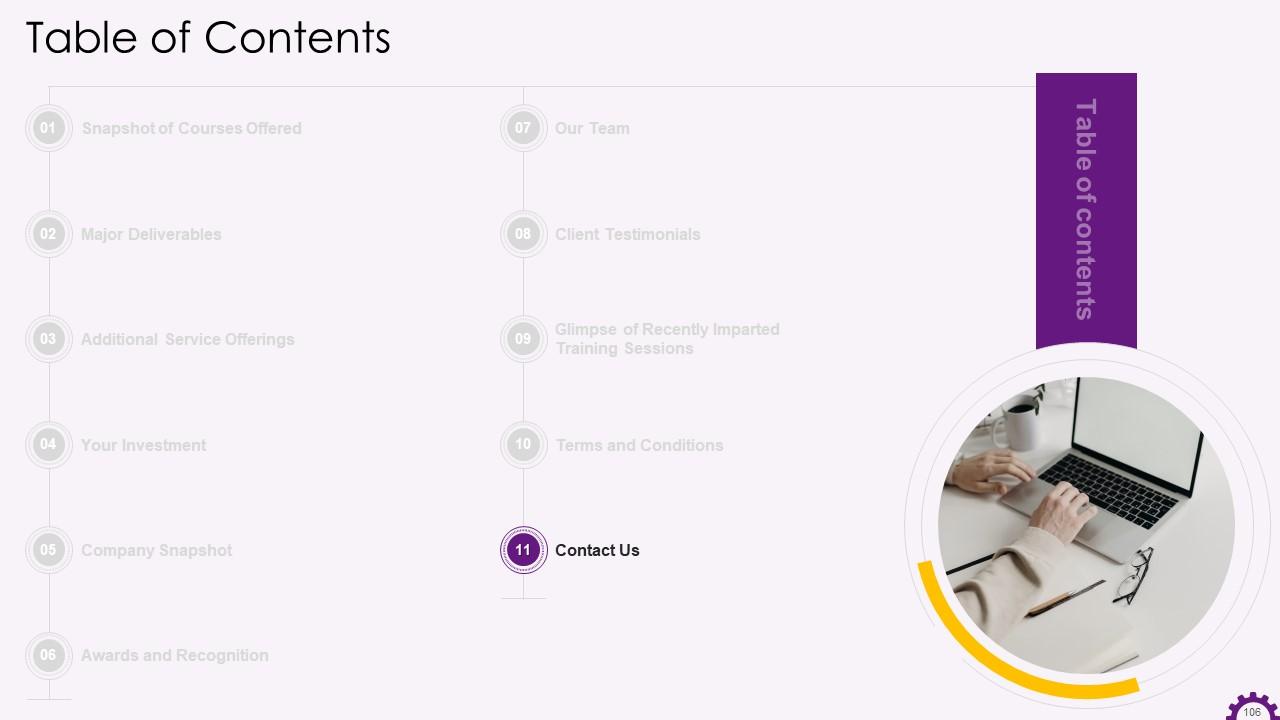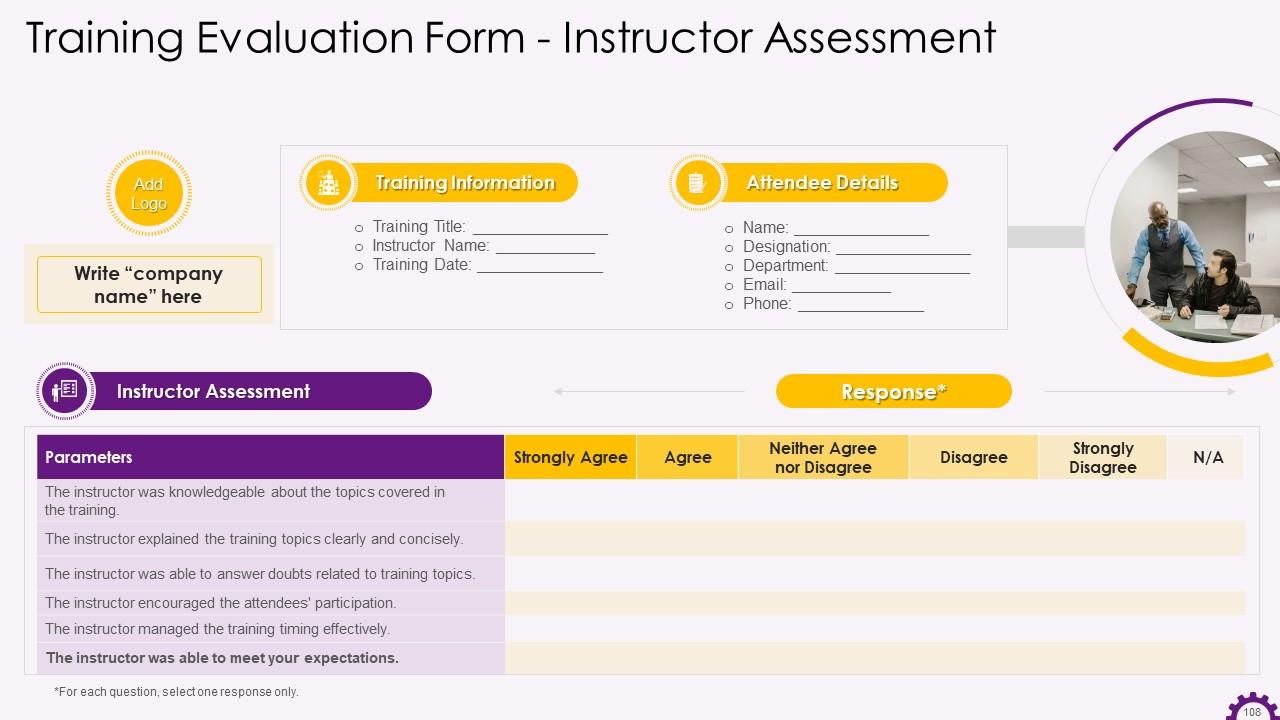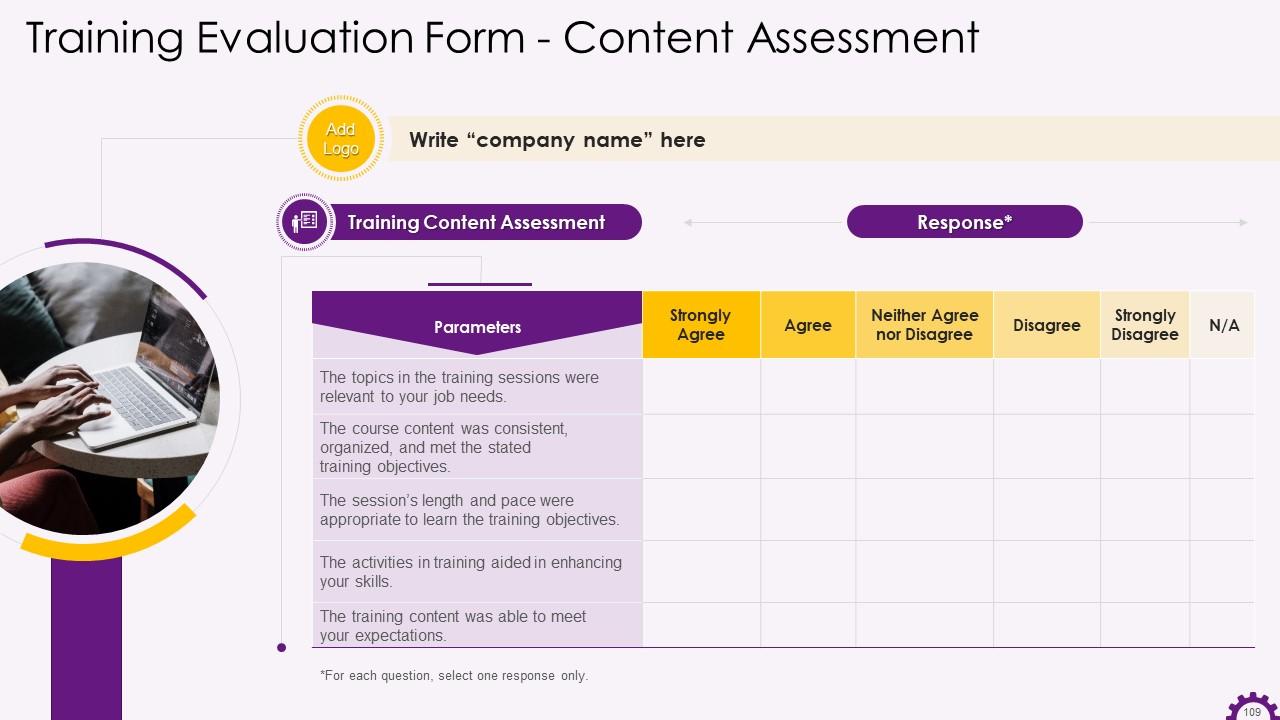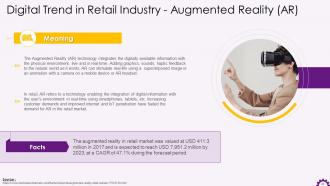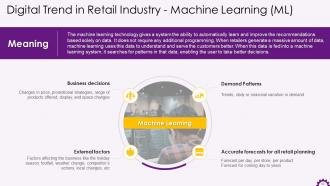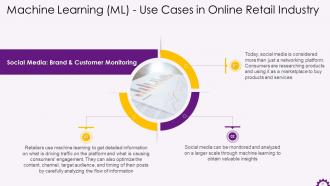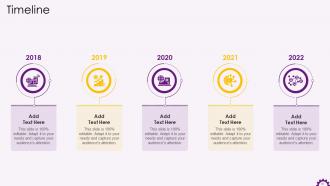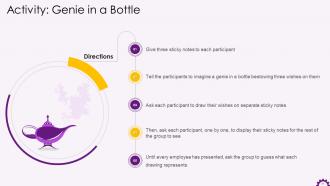Digital Transformation in Retail Industry Training ppt
The PowerPoint training deck in-depth covers the digital transformation in the retail industry. It includes the significance of digitalization in the retail sector, which are improved operations, better communication, and improved customer experiences. The module has PPT slides on emerging digital trends in the retail industry, such as the growth of m-commerce and e-commerce, the usage of machine learning for product recommendations, and augmented reality and virtual reality to checkout products. It also has the best practices and challenges associated with the digital transformation of the retail industry. The Digital Transformation PPT deck also has case studies, key takeaways, and discussion questions to make the training session interactive. Further, it also contains about us, vision, mission, goal, 30-60-90 days plan, timeline, roadmap, training completion certificate, energizer activities, client training proposal, and assessment form.
The PowerPoint training deck in-depth covers the digital transformation in the retail industry. It includes the significanc..
- Google Slides is a new FREE Presentation software from Google.
- All our content is 100% compatible with Google Slides.
- Just download our designs, and upload them to Google Slides and they will work automatically.
- Amaze your audience with SlideTeam and Google Slides.
-
Want Changes to This PPT Slide? Check out our Presentation Design Services
- WideScreen Aspect ratio is becoming a very popular format. When you download this product, the downloaded ZIP will contain this product in both standard and widescreen format.
-

- Some older products that we have may only be in standard format, but they can easily be converted to widescreen.
- To do this, please open the SlideTeam product in Powerpoint, and go to
- Design ( On the top bar) -> Page Setup -> and select "On-screen Show (16:9)” in the drop down for "Slides Sized for".
- The slide or theme will change to widescreen, and all graphics will adjust automatically. You can similarly convert our content to any other desired screen aspect ratio.
Compatible With Google Slides

Get This In WideScreen
You must be logged in to download this presentation.
PowerPoint presentation slides
Presenting Training Deck on Digital Transformation in Retail Industry. This deck comprises of 110 slides. Each slide is well crafted and designed by our PowerPoint experts. This PPT presentation is thoroughly researched by the experts and every slide consists of an appropriate content. All slides are customizable. You can add or delete the content as per your need. Not just this, you can also make the required changes in the charts and graphs. Download this professionally designed business presentation, add your content and present it with confidence.
People who downloaded this PowerPoint presentation also viewed the following :
Content of this Powerpoint Presentation
Slide 4
This slide explains the meaning of digital transformation in retail sector. It states that digital transformation in retail is a comprehensive process that works toward improved customer experience and satisfaction. Digital transformation in retail considers every aspect of the business starting from sourcing to customer management.
Slide 5
This slide explains how digitalization is contributing to the growth and transformation of retail sector. By utilizing technologies like big data, real-time shopping, automation, customization, AR, VR, ML etc., the business are improving their processes, models and customer service.
Slide 6
The purpose of this slide is to highlight statistical data related to the market size and growth rate of the digital transformation in the retail sector.
Slide 7
This slide explains why digitalization is more prevalent in the current scenario in the retail sector. The reasons behind this are surge in online shopping post covid, transparency in the supply chain, and positive experience of businesses who have gone the digital presence route.
Slide 8
This slide explains how the covid pandemic has contributed to the growth of digital transformation in retail. The existing covid situation has led to a change in consumers' preferences, causing an increase in online shopping and an upward growth trend in digital retail sector.
Slide 9
This slide explains the relevance of digitalization in bringing transparency in supply chain management. With the help of digitalized solutions, retailers will be in a better position to take scientific decisions about inventory, operations, strategies, and distribution channels. This concept of transformation will help retailers enhance both online and offline experiences.
Slide 10
This slide explains how and why retailers with a digital presence are more successful and emerging. It shows that the retailers having a digital presence can capture a larger market share earning more profits and gain a first-mover advantage.
Slide 12
This slide explains why the retailers are switching from traditional to digital retail. Digital transformation in retail will improve the experience of both the retailers and the customers. With the change, the retailers will understand the customer needs, their changing tastes, preferences, and offer an enhanced, seamless shopping experience. This transformation will improve the business opportunities for retailers also, as they will be able to attract and retain more customers.
Slide 13
This slide mentions the points of importance in the digitalization of retail. Digitalization of retail will improve operations, communication, provide convenience in shopping, enhance customer experience, boost revenue, empower employees, and help in reimagining products.
Instructor’s Notes:
- Efficient operations: Using digital technologies like AI, VR, Cloud technologies etc. helps the business improve its operations. Availability of real-time data helps in predicting and analyzing the needs and requirements of customers well in advance
- Convenience: Digital transformation tools like AI have made the job of retailers and customers easy. Retailers are now able to sell their products online using websites and apps and offline using physical stores. The on-time management of inventory and other processes and understanding consumer needs have enriched customer experience
- Better communication: With the digitalization of the retail sector, retailers can now improve their communication and form better connections with their customers using social media channels, mobile applications, websites, etc.
- Customer Experiences Speed and Service: Digital transformation enriches customer experience by offering them better services and a smooth journey from the selection of product till it is received. Improved processes have also contributed to increasing employees' productivity by making them more effective and efficient. Digital transformation is an entirely customer-centric process, but it also helps businesses become better and more competitive
- Boost revenue: Digitalization of retail has expanded the customer base of the retailers and, hence, widened the scope of products and services offered. This has eventually led to increased avenues for income and growth rate
- Employee empowerment: Employee empowerment means training them with the skills and knowledge required to perform a particular task well. The changing needs of businesses and customers with digitalization encourages companies to innovate and become better than before. This has mandated empowering human resources giving them the support required to perform effectively and efficiently
- Reimagine your products: Considering the dynamic environment, the focus of businesses must be on continuous innovation of their products and services. This sounds easy, but it requires proper research and then selection of the right tools and resources. The ultimate goal is better operations and return
Slide 15
This slide explains how Starbucks digitally transformed its traditional retail strategies. Starbucks’ main innovation is their mobile order and pay app feature. It is based on a customer-first strategy that addresses the basic needs and wants of the customers on priority.
Slide 16
This slide explains how Audi has transformed from traditional to digital retailing using virtual showrooms known as “Audi City.” The Audi City concept has changed the pattern of premium car sales by presenting its entire model range using virtual technology and personalized advice feature. This feature has allowed its visitors to explore the complete catalog of Audi’s model range hands-on, in city-centre stores where establishing large showrooms was nearly impossible. This transformation has also led to a surge in sales volume compared with the traditional retail patterns.
Slide 18
This slide depicts why and how the increased adoption and usage of social media has impacted the retail sector worldwide. It also shows key statistics relating to the increase in social media users from 2017 to 2025.
Slide 19
This slide depicts why and how the increased number of internet users has impacted the retail sector worldwide. It also shows the key statistics on increase in internet users.
Slide 20
This slide depicts why and how the increased number of smartphone users has impacted the retail sector worldwide. It also shows the statistics related to the increase in smartphone users from 2016 to 2021 and the expected growth in numbers by 2026.
Slide 21
This slide explains the concept of digital infrastructure in retail and how it improves the retail process. It explains that the focus on technology, networking like broadband networks, financing the digital highways, restoring the telecom sector’s health, providing efficient infrastructure for data localization will help strengthen the country’s digital infrastructure.
Slide 22
This slide explains the concept of digital infrastructure in retail and how it assists in improving the retail processes. It focuses on a robust digital infrastructure that can support new requirements and customer demands. It also mentions that to execute an effective retail experience, retailers should consider core areas like integration, data centers, networking, etc., to produce strong infrastructure.
Slide 23
This slide explains the meaning of m-commerce in retail and how it has grown over the years, contributing to sales worldwide. It is also stated that m-commerce leads to a better customer experience, growth opportunities, and omnichannel experience.
Slide 24
This slide explains the use of mobile applications in retail and how it has made the process of retailers and customers easy. It states that mobile applications assist the customers in making an informed choice, these apps provide relevant information about a product or service.
Slide 25
This slide illustrates the meaning of e-commerce and its impact on the digitalization of the retail sector. It mentions that as the Internet becomes ubiquitous, the number of digital buyers is also growing. It also shares statistics on the number of online buyers and value of their spend in year 2020.
Slide 26
This slide explains the omnichannel concept in retail and the channels of conduct. It describes how this concept enriches customer service and promotes seamless transactions. The omnichannel retail can take various forms like a showroom experience where a purchaser sees a product offline but buys online. In another way, a person researches the product and checks its reviews online and then experiences and buys the product from the store.
Slide 27
This slide depicts an illustration which the trainer can use to explain the concept of omnichannel shopping to the target audience. It describes how omnichannel retail integrates different channels to provide customers with a seamless shopping experience.
Slide 28
This slide explains the significance of omnichannel using the example of Starbucks. Starbucks uses omnichannel retail to attract and retain its customers. This slide also highlights statistics showing the growth of companies that have implemented omnichannel strategy in retail.
Slide 29
This slide mentions the meaning of Augmented Reality and how it is utilized in retail. It also tells the market growth rate of Augmented Reality (AR) over the past 4 years.
Slide 30
This slide explains the impact of Augmented Reality (AR) on retail using a study conducted by ICEM. It states factors that were impacted by Augmented Reality (AR), like where the shoppers want to buy, how they want to buy, what they want to buy, etc.
Slide 31
This slide illustrates the statistics related to usage of Augmented Reality in retail.
Slide 32
This slide explains the meaning of Machine Learning and makes a strong case for its adoption in retail. Understanding demand patterns, external factors, and making business decisions requires the use of Machine Learning in the retail sector.
Slide 33
This slide mentions the reasons for need of machine learning in retail. It also states how machine learning has impacted the growth of retailers.
Slide 34
This slide mentions the application areas of Machine Learning in Online Retail. Machine Learning can be used to improve the customer experience by utilizing custom ML in browsing, predicting the customer's behavior, understanding social media patterns, and improving chatbots and virtual assistants.
Slide 35
This slide mentions the use cases of machine learning while browsing through a digital catalog. The use cases are recommendation engines, pricing strategy, and visual search.
Instructor’s Notes:
- Recommendation Engines: In the current business scenario, most e-commerce and retail companies leverage the power of data and boost sales using recommender systems on their websites, mobile apps etc. Recommendations help speed up the searches and make it easier for the users to find the content. Using this system, retailers focus on increasing sales volume and earnings, enriching customer experience, and gaining a competitive advantage
- Pricing Strategy: Pricing is an essential predictor of profitability. Machine learning algorithm considers key pricing variables to define an automatic pricing strategy, prices discovered this way are dynamic and in real-time
- Visual Search: Customers mostly search for visual content before making any purchases. In most cases, they cannot easily find accurate keywords to describe their requirements. The visual search feature aims to make it easier for consumers to find exactly what they’re looking for. Machine learning algorithms help achieve excellent results with the huge and increasing amount of clicking and sharing images
Slide 36
This slide mentions the significance of machine learning in predicting consumer behavior, sales patterns, and analyzing their actions based on past data records.
Slide 37
This slide mentions the significance of understanding social media usage patterns in predicting consumer behavior.
Slide 38
This slide mentions the significance of virtual assistants and chatbots in assisting retail services and improving customer experience.
Slide 39
This slide explains the meaning of Virtual Reality. It also mentions statistics relating to the growth of Virtual Reality market worldwide.
Slide 40
This slide illustrates the meaning of Virtual Reality in the retail sector and how the covid pandemic has impacted its growth.
Slide 41
This slide mentions various companies like Nike and Apple that have incorporated Augmented Reality and Virtual Reality in their retail operations.
Slide 42
This slide mentions various companies like Ikea and Loreal that have incorporated Augmented Reality and Virtual Reality in their retail operations.
Slide 44
This slide mentions the best practices that should be followed for the digital transformation of the retail sector. The business should clearly understand and focus on the activities of the target customers.
Slide 45
This slide mentions the various challenges that arise in the transformation of the retail sector. Challenges like change management, commitment, complexity, technology, and investment challenges affect the sector's productivity.
Instructor’s Notes:
- Change Management: Most departments behave on their own accord, adhering to different standards and metrics. Transformation risks the traditional ways of doing things and sometimes hinders a person's productivity. Changes in roles create additional challenges in proving the ROI and taking ownership. Therefore, retailers are usually unwilling and doubtful to implement new working methods
- Commitment: Most of the time, when initiatives are in progress, they might not be transformational enough and end up being just a mobile app or a new website enhancing customer experience. Moreover, the commitment to introduce digital transformation in an enterprise goes beyond ideation. It requires leadership level emphasis, assurance of resources and budget, and an ability to follow the respective initiative with certainty
- Complexity: Digital transformation in retail is complicated which cannot be handled individually by the retailers. Outsourcing can prove to be a great help, but choosing partners carefully is another critical concern. It requires a partnership of different kinds: co-establishing digital journeys for all the customers, enterprise entities, and stakeholders. The main concern behind finding different digital moments in a retailer’s operational journey and customer experience is to establish a transformational impact
- Technology: Digital transformation to be successful in retail must be backed by a strong technological foundation. The selection of the right technologies that add value to the existing process is also one of the significant challenges in digital retail transformation. Also, it should be paramount to evaluate risks and examine what new infrastructure facilities and technologies would be suitable for the organization in the upcoming period
Slide 47
This slide mentions examples of digital transformation technologies “Social Shopping” being used by companies like YouTube and Instagram.
Slide 48
This slide mentions examples of digital transformation technologies “Mobile Application” being used by companies like Sephora.
Slide 49
This slide mentions examples of digital transformation technologies “Retail Assistants” that companies like Walmart, The Home Depot, and Lowe’s are using.
Slide 50
This slide mentions examples of digital transformation technologies “Customer Service Chatbots”.
Slide 51
This slide illustrates the key takeaways for the section Digital Transformation in Retail Industry.
Slide 52
This slide mentions various questions for discussion and revision of the concepts in the topic Digital Transformation of Retail.
Slide 64 to 79
These slides contain energizer activities to engage the audience of the training session.
Slide 80 to 107
These slides contain a training proposal covering what the company providing corporate training can accomplish for the client.
Slide 108 to 110
These slides include a training evaluation form for instructor, content and course assessment.
Digital Transformation in Retail Industry Training ppt with all 115 slides:
Use our Digital Transformation in Retail Industry Training ppt to effectively help you save your valuable time. They are readymade to fit into any presentation structure.
-
Thank you for showering me with discounts every time I was reluctant to make the purchase.
-
Wonderful templates design to use in business meetings.


